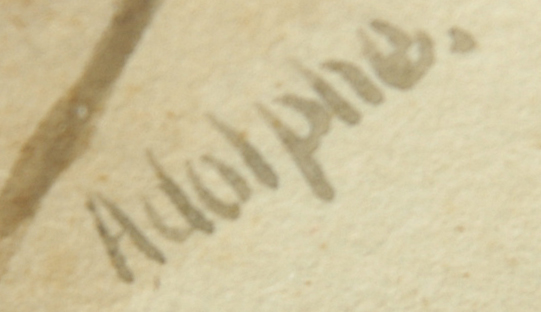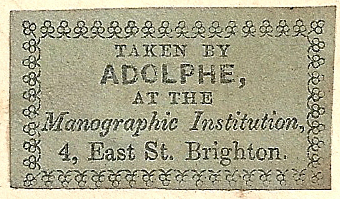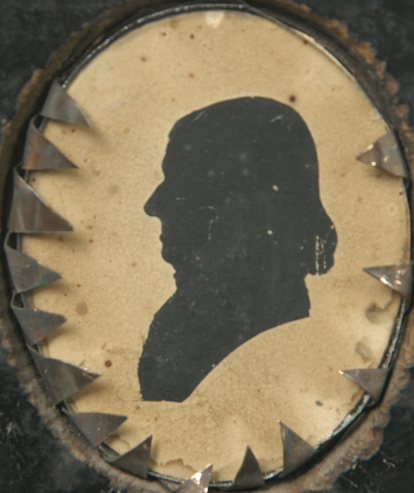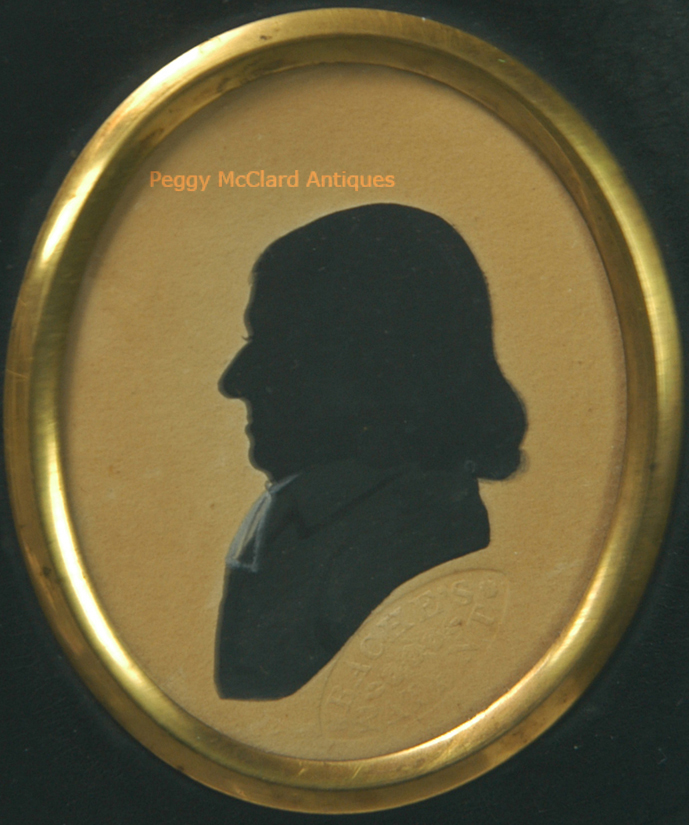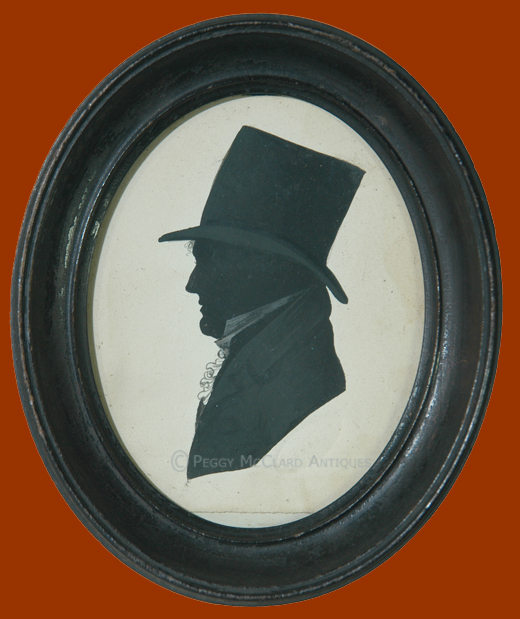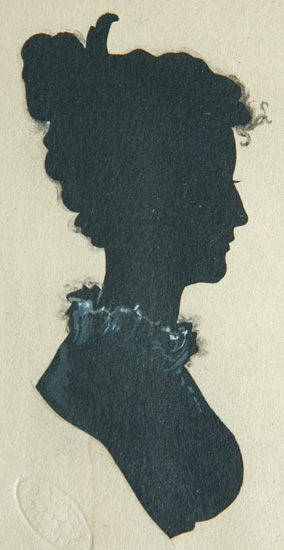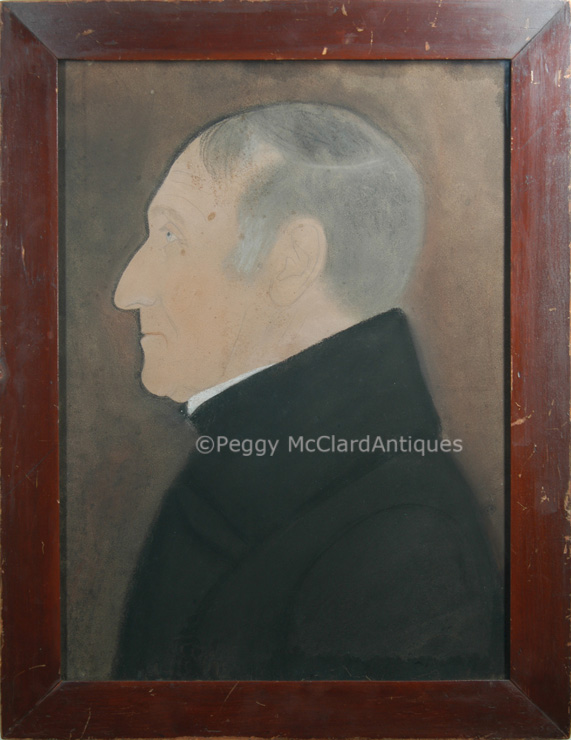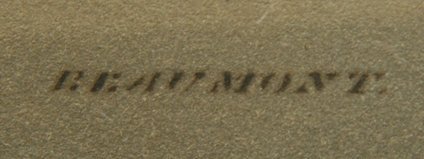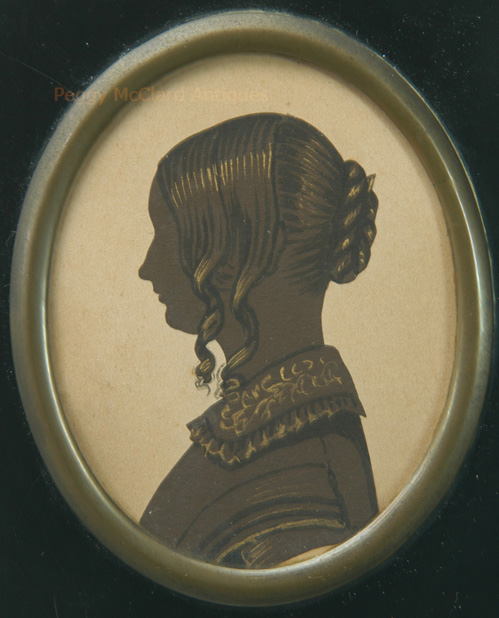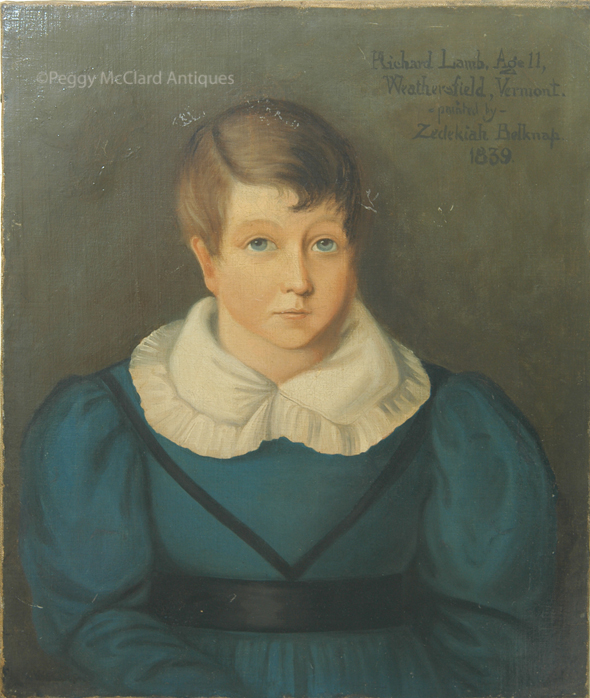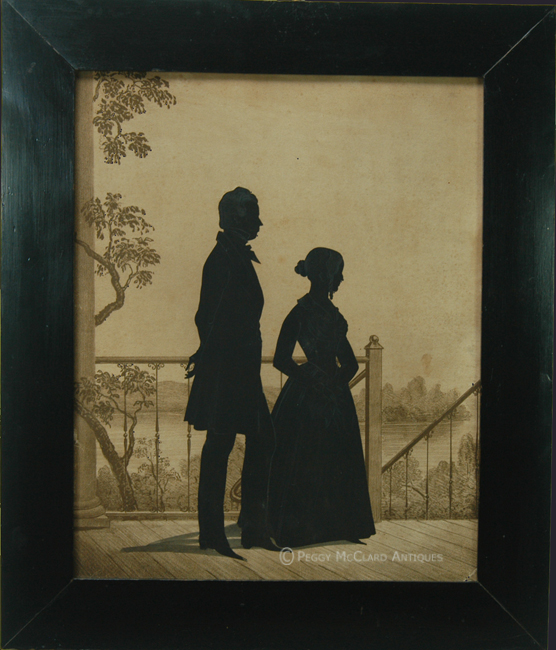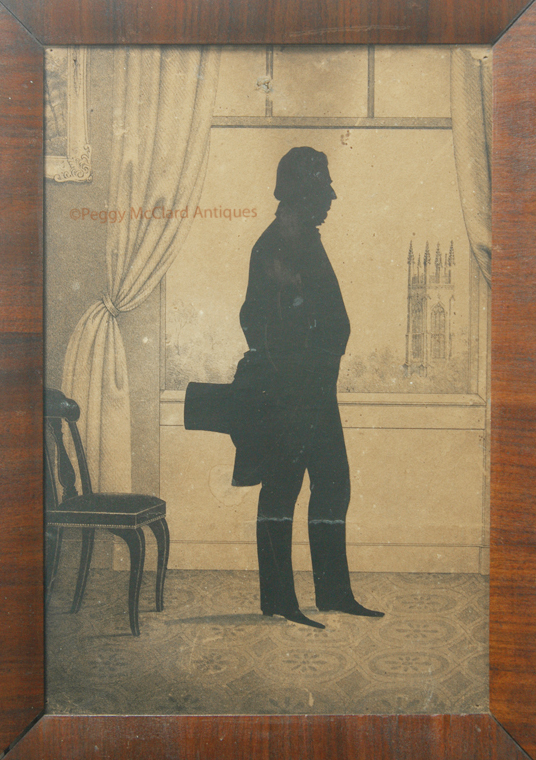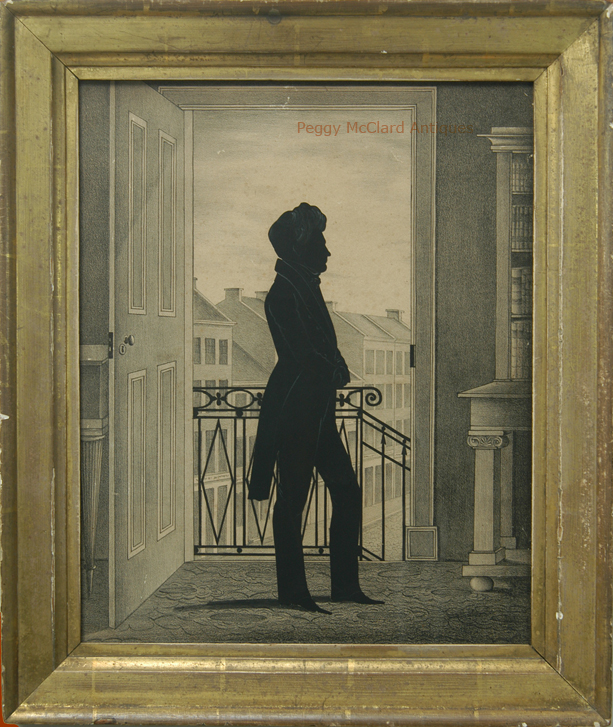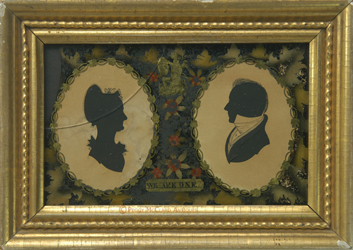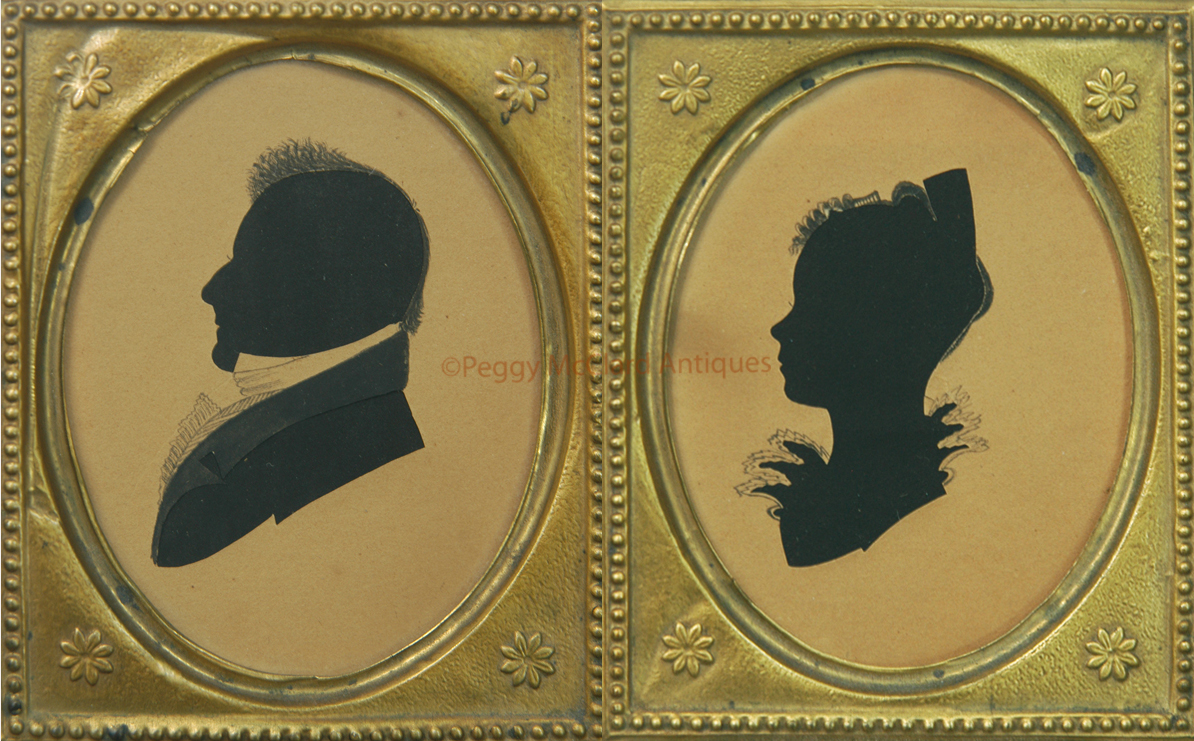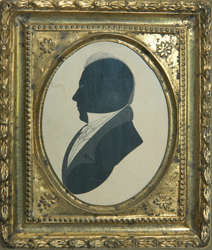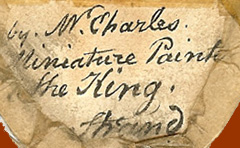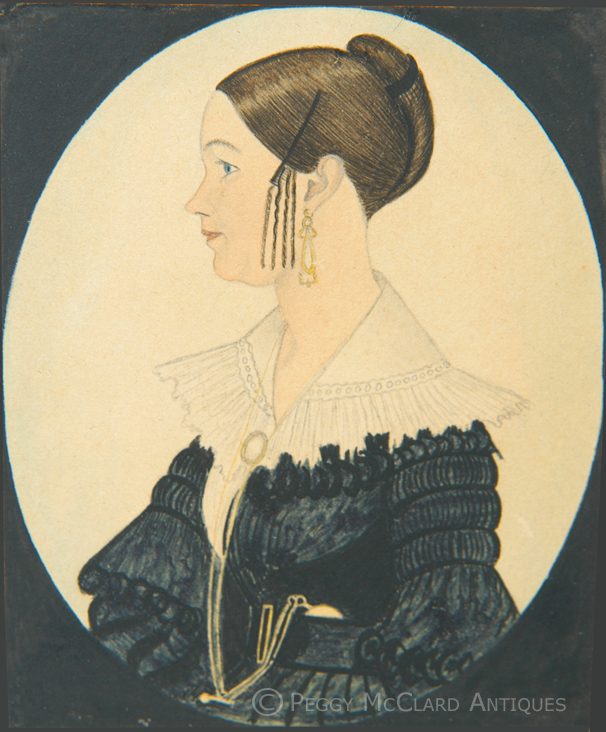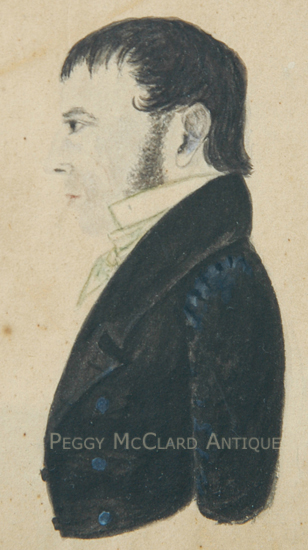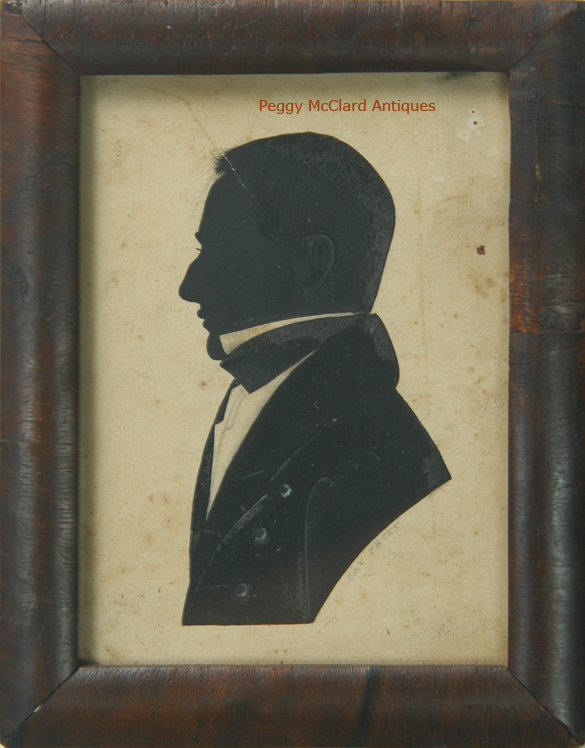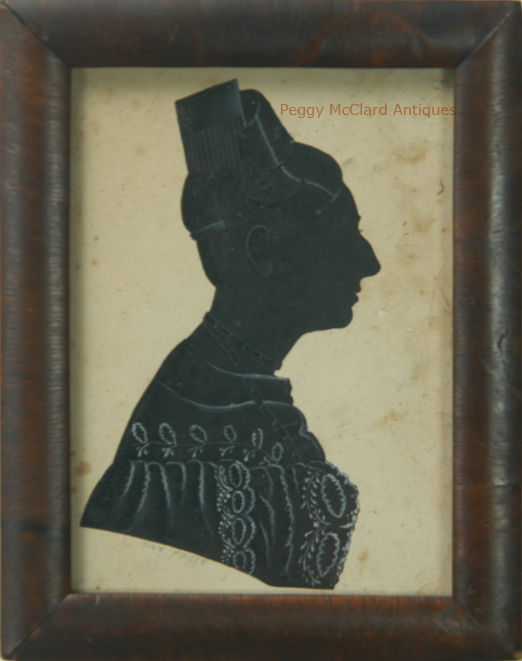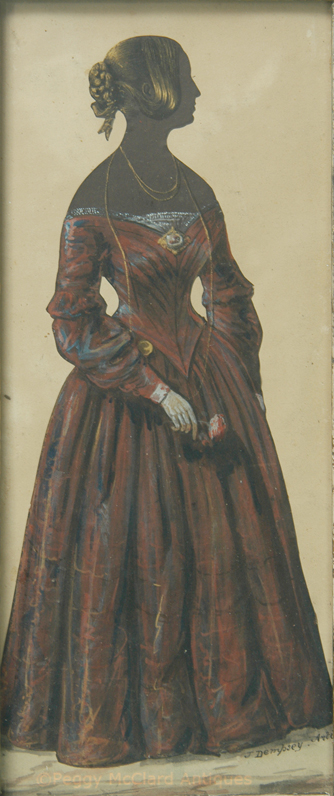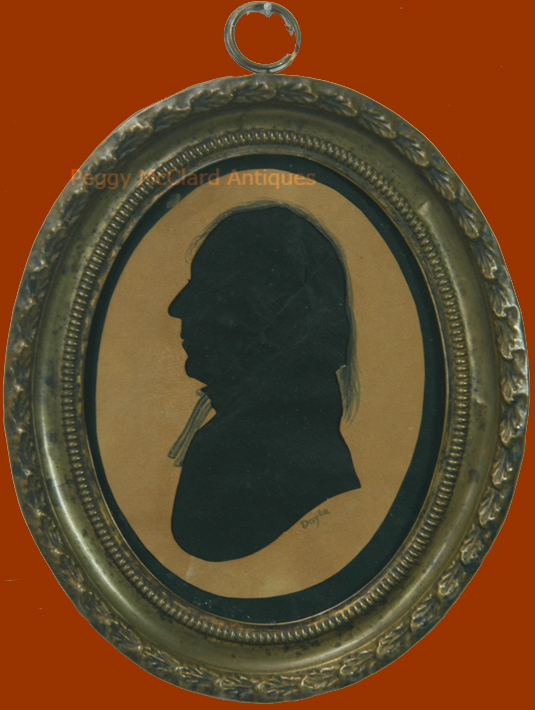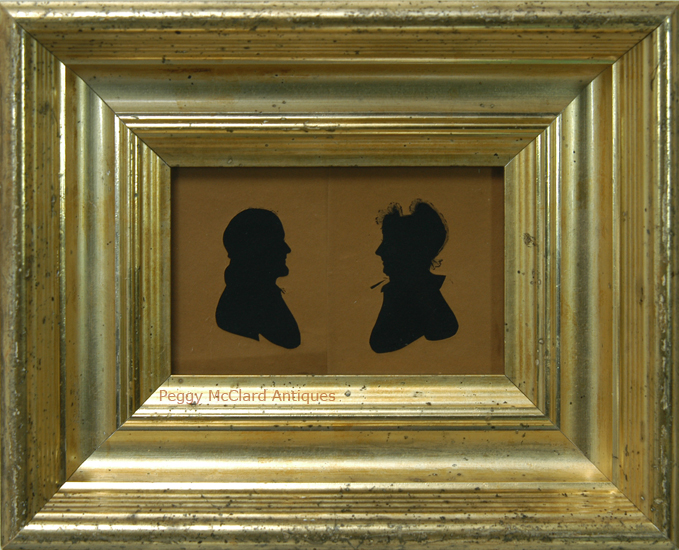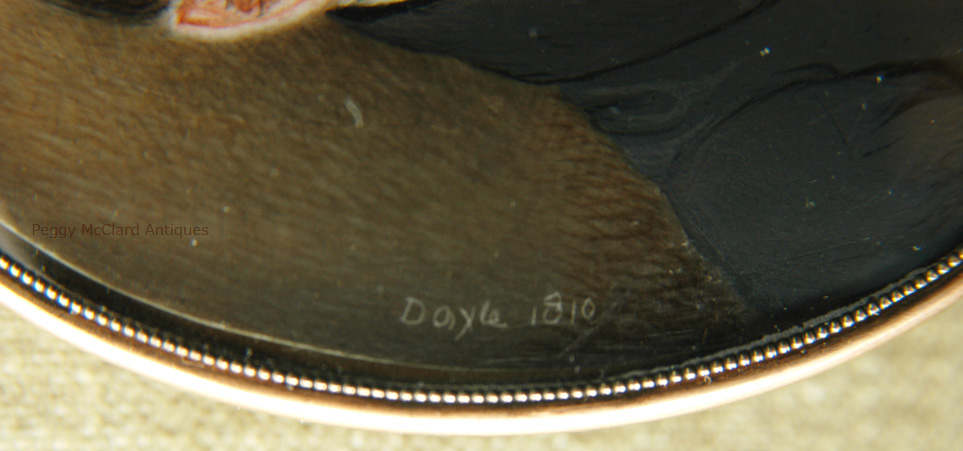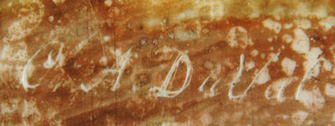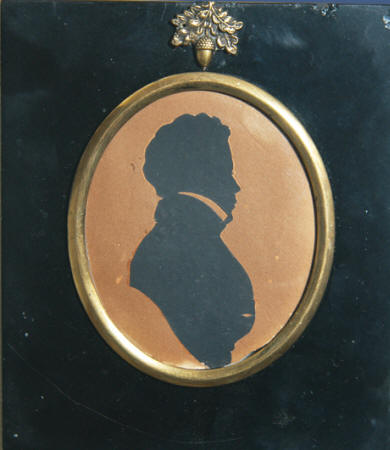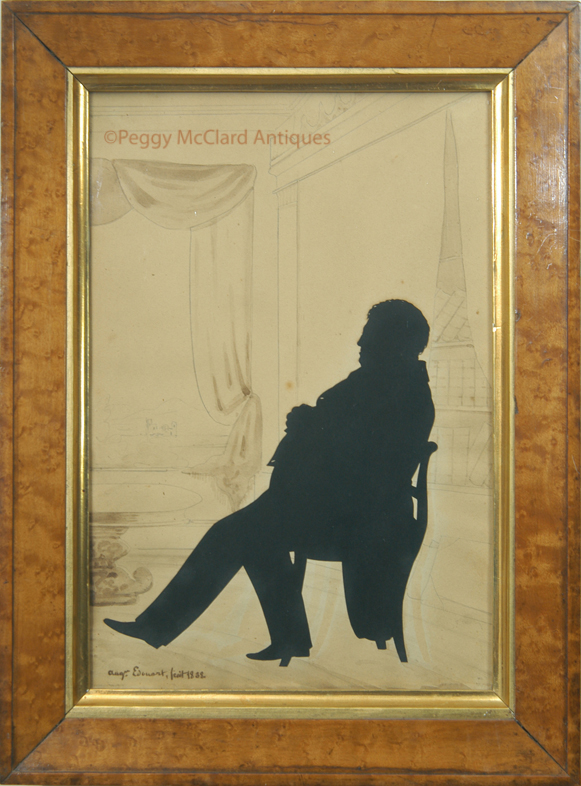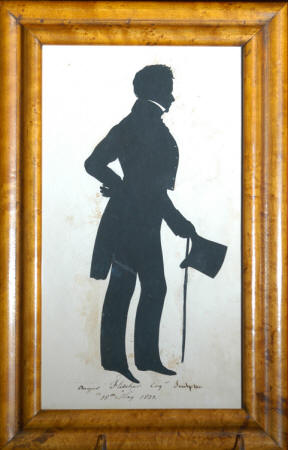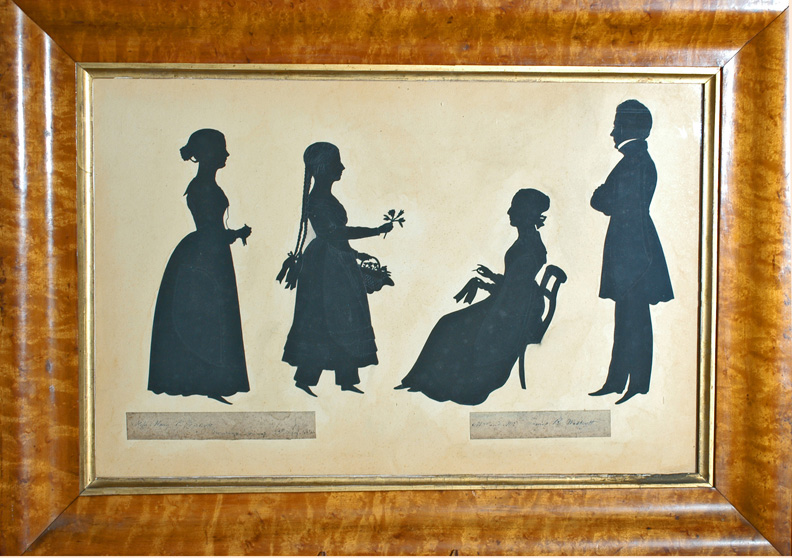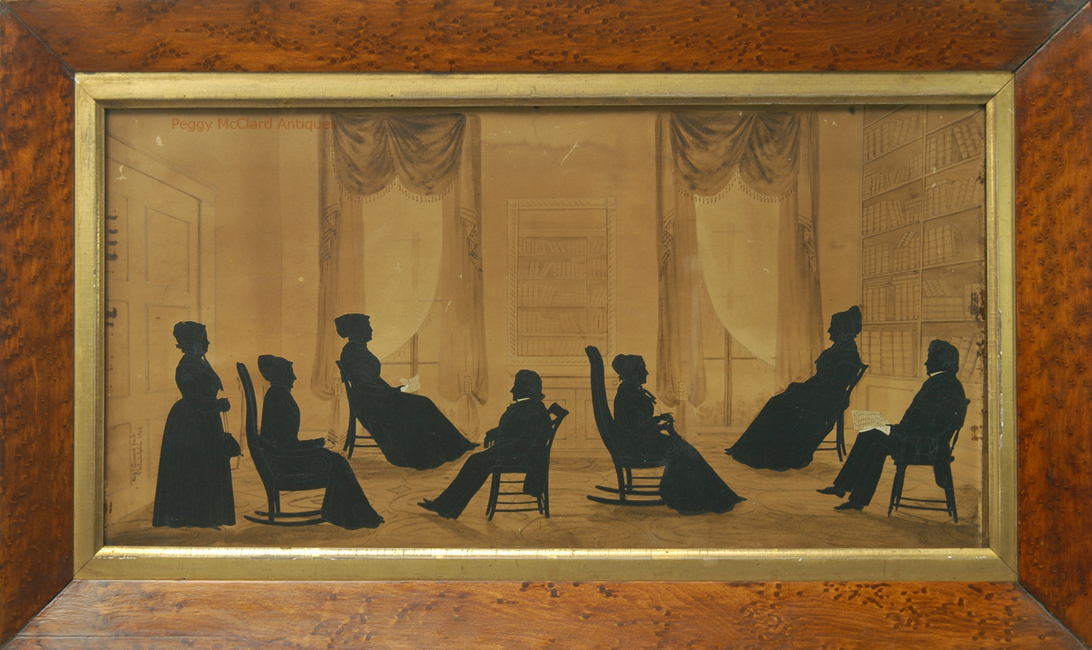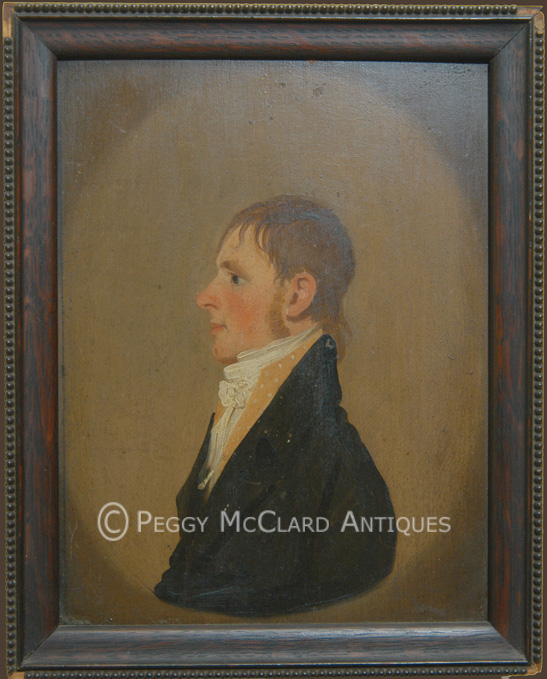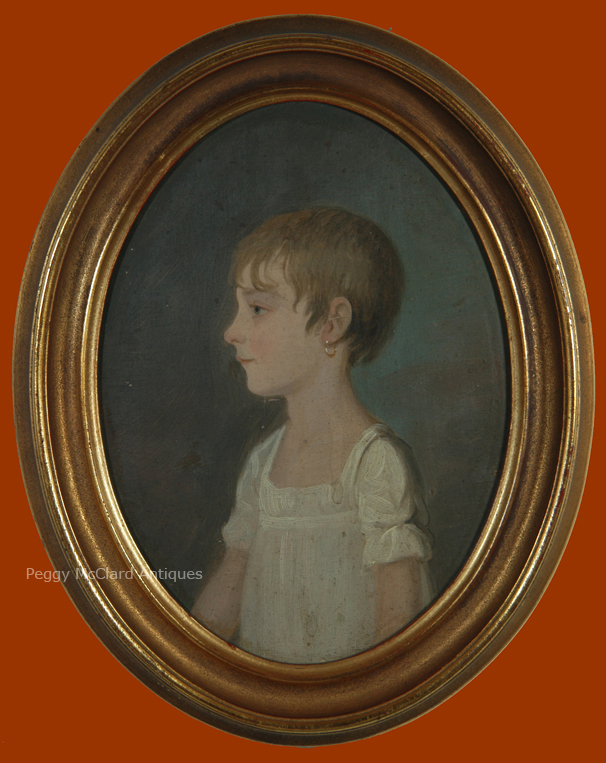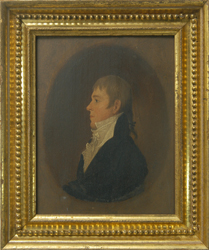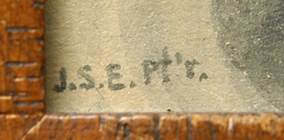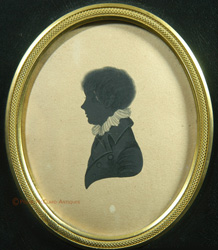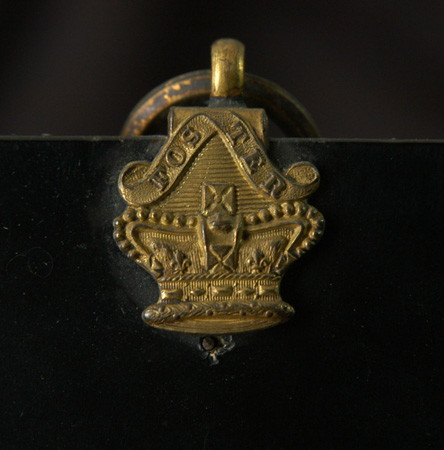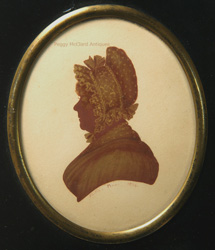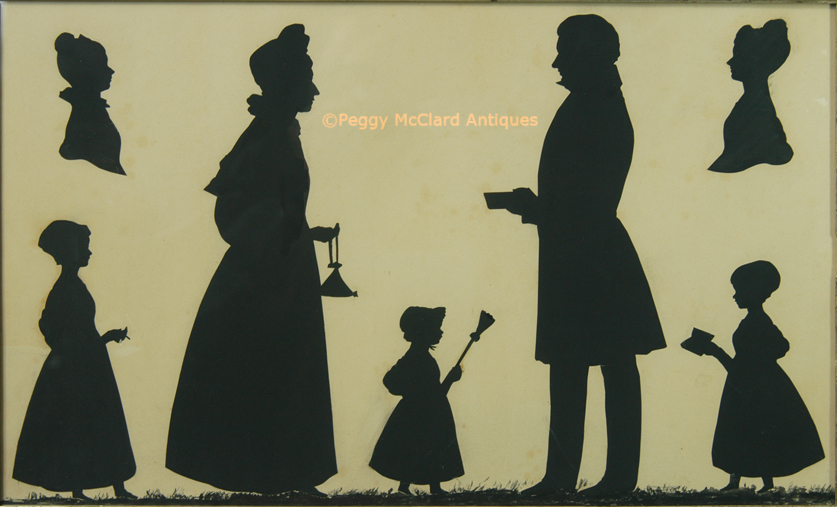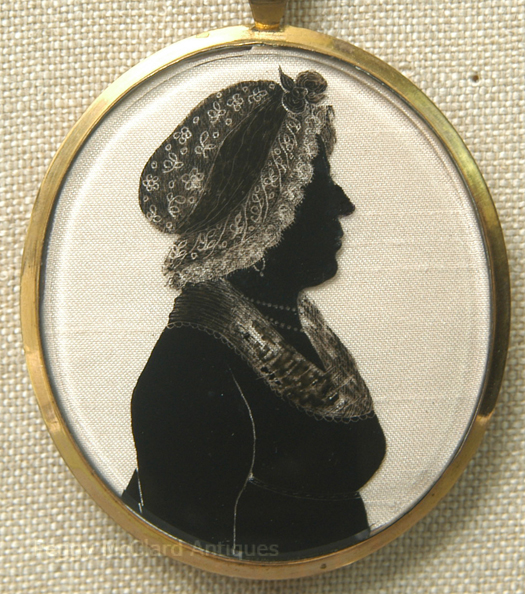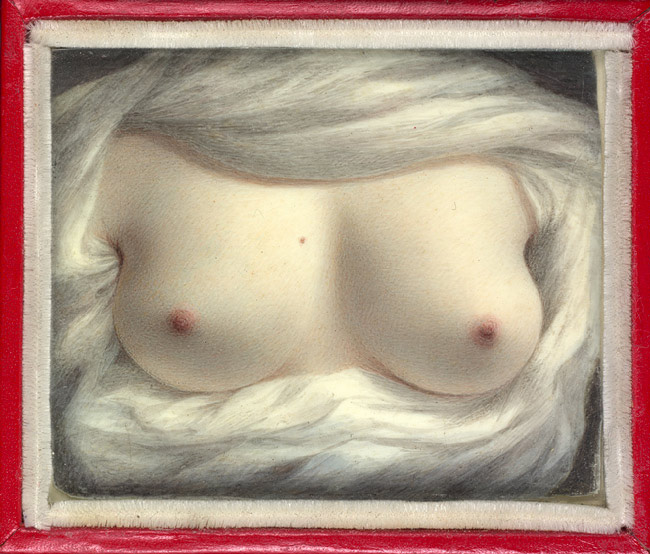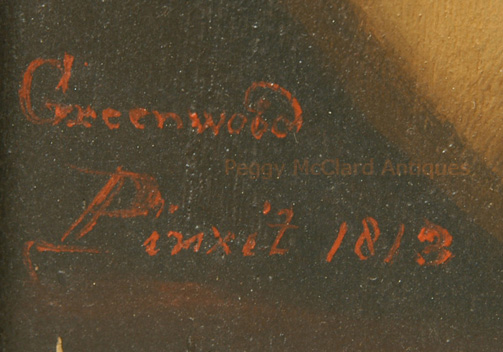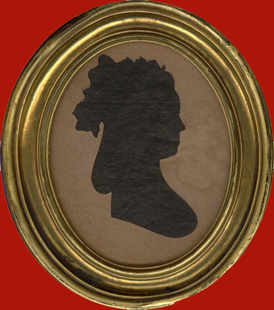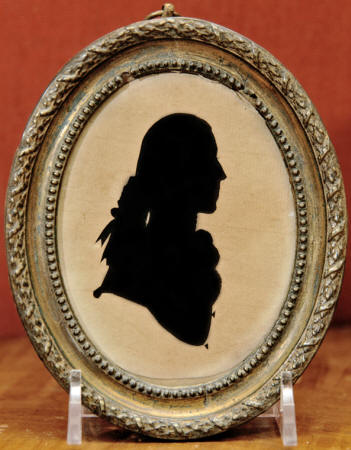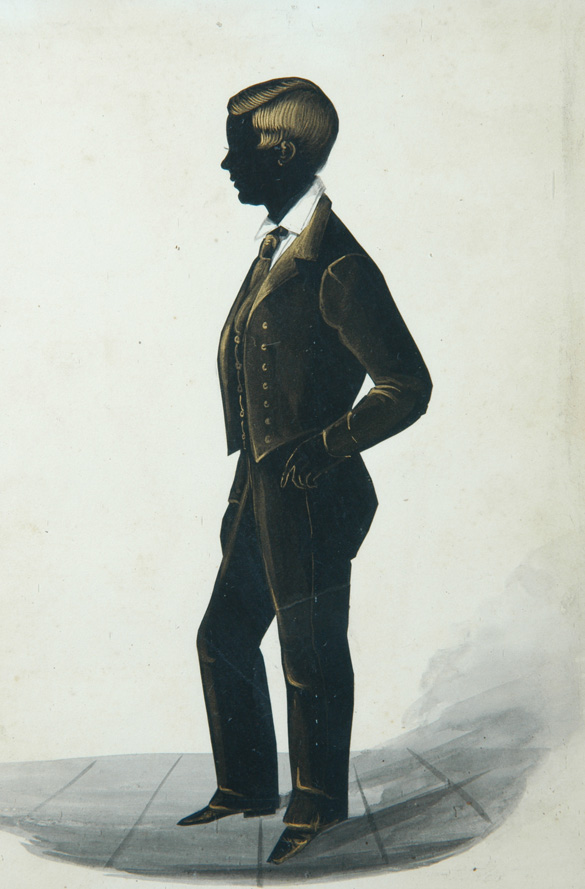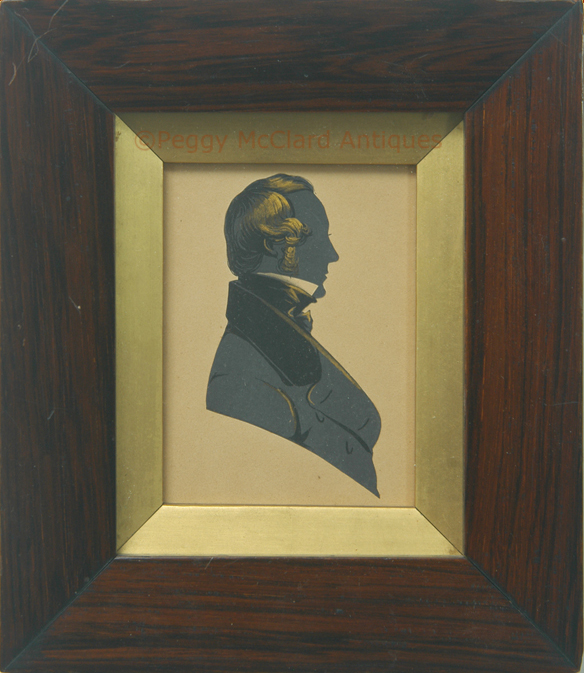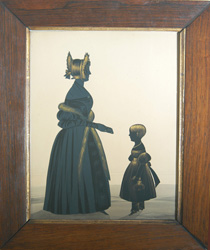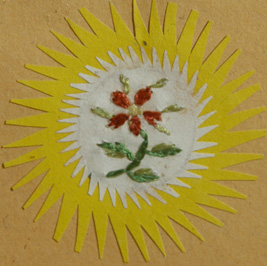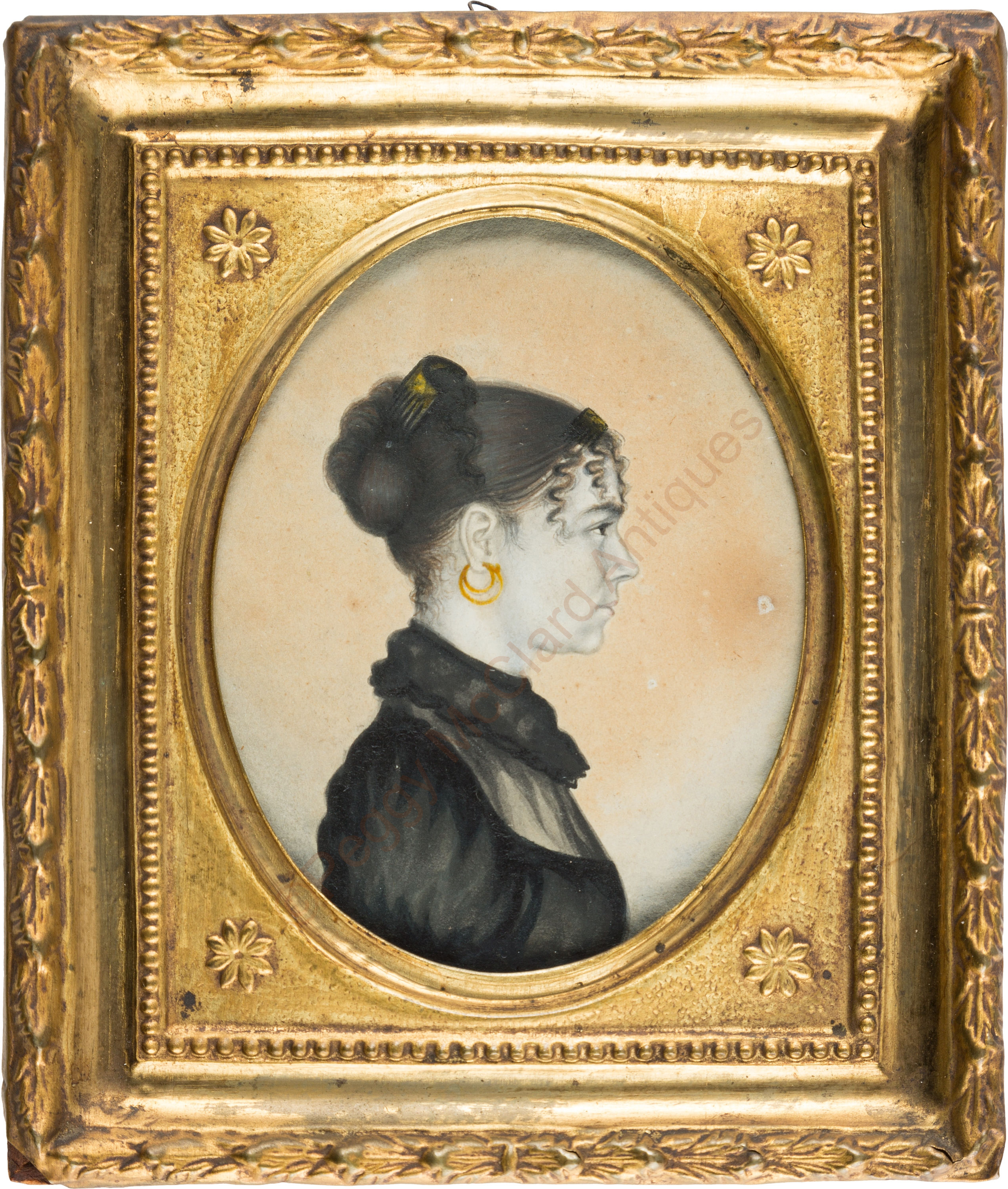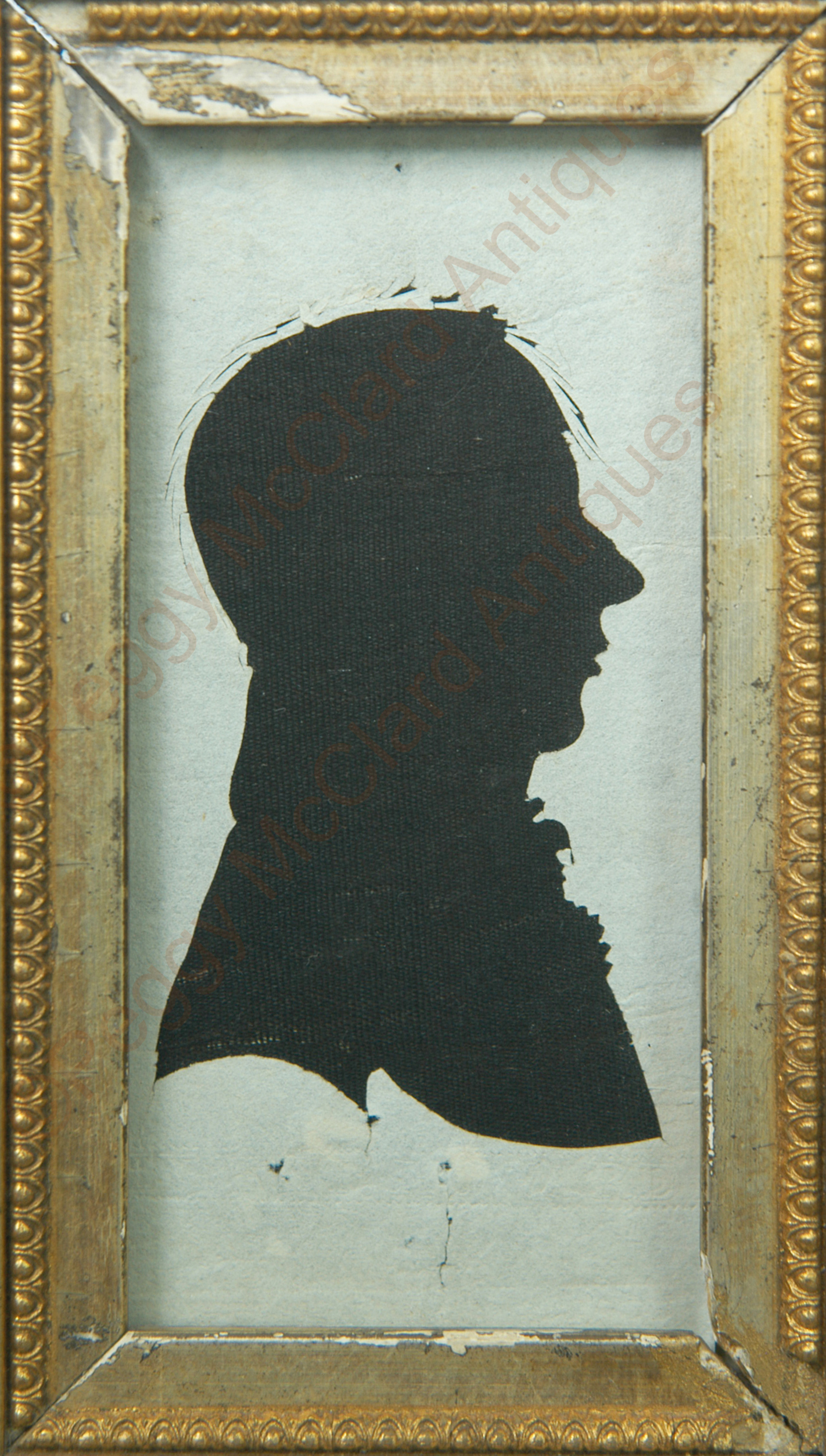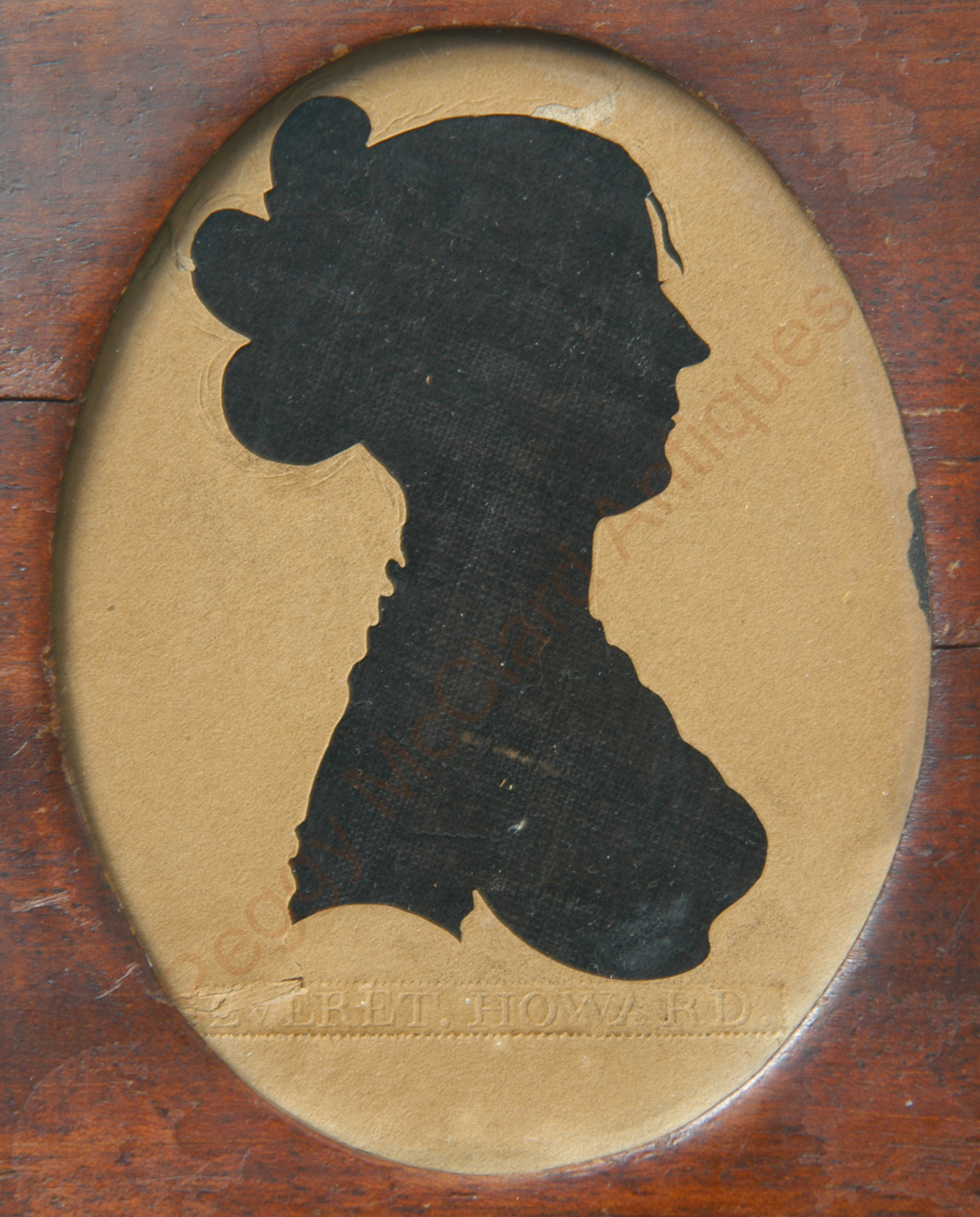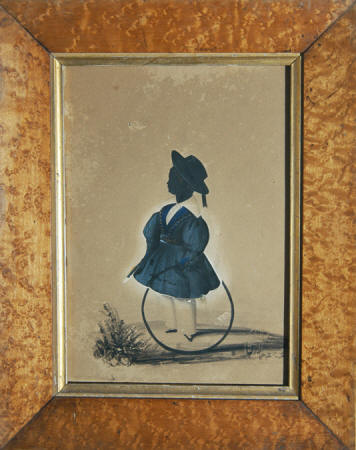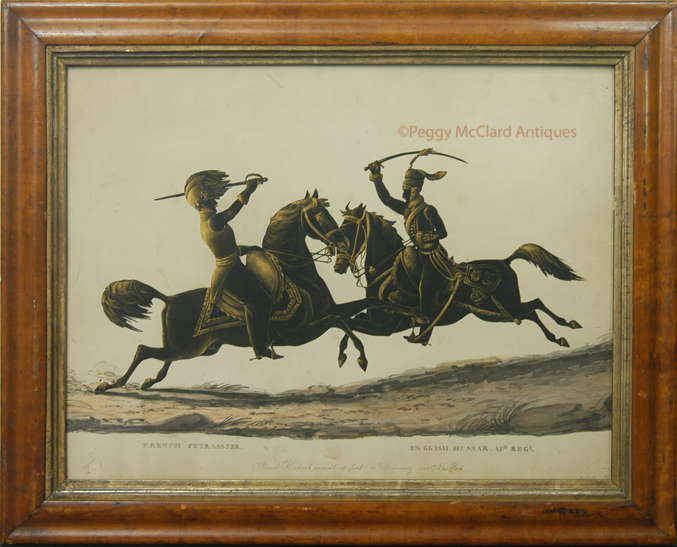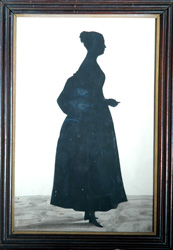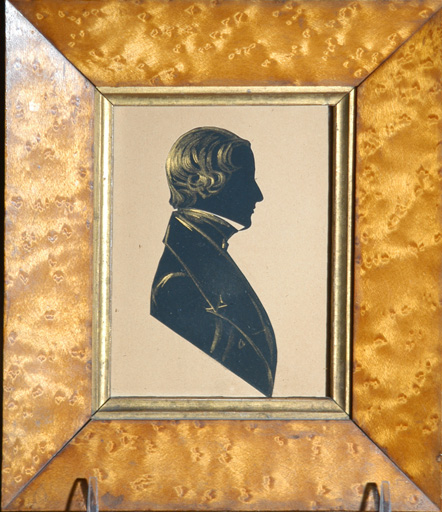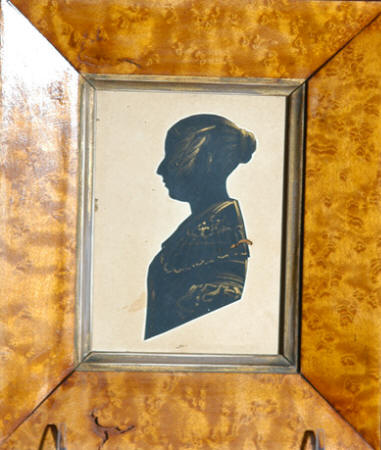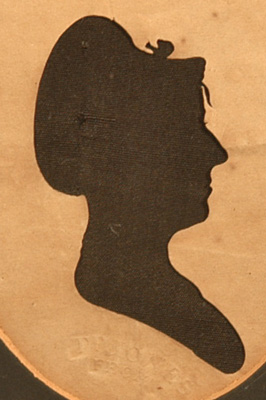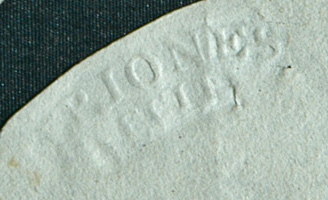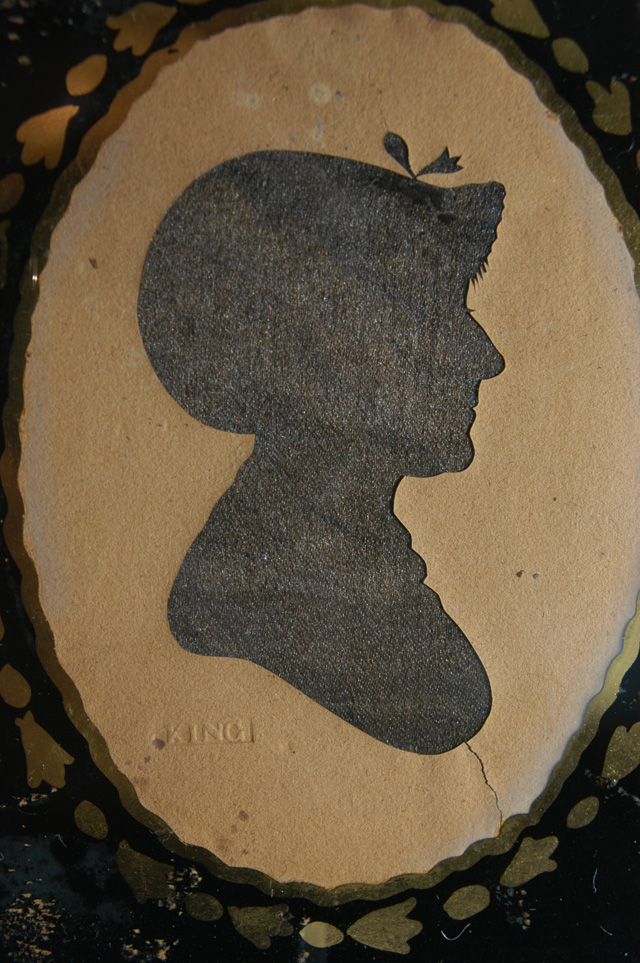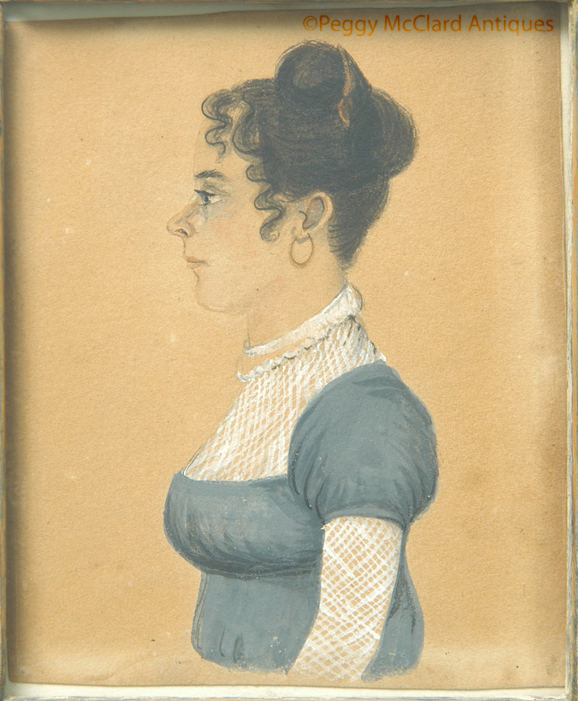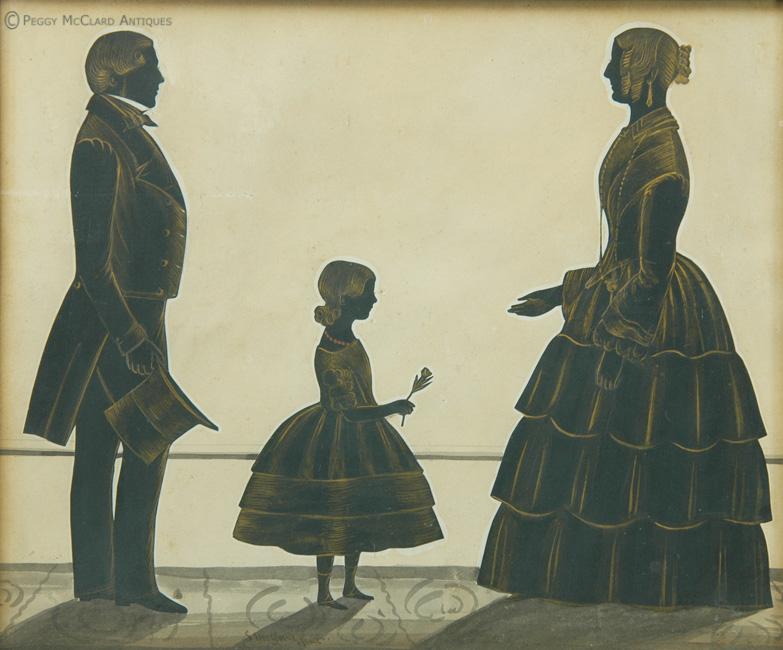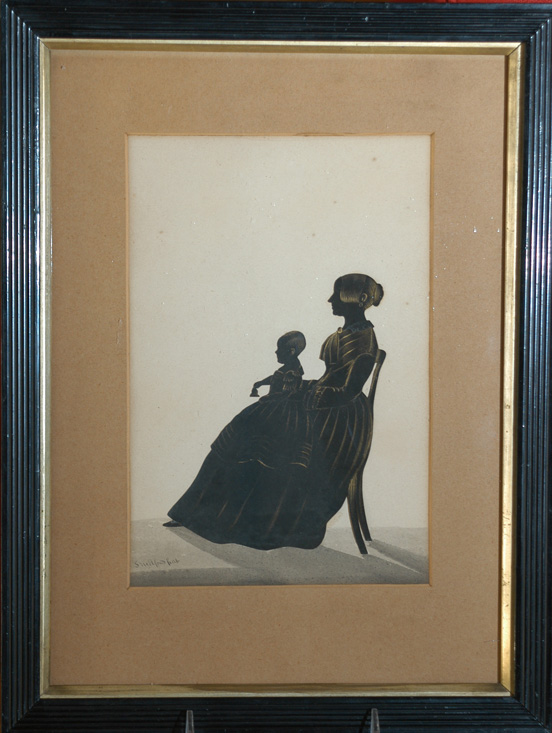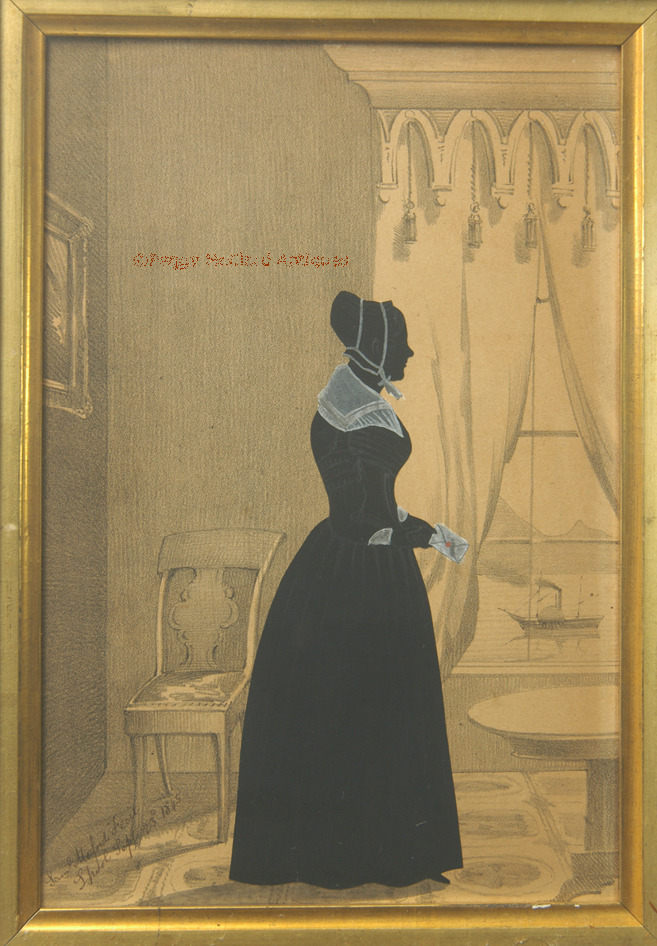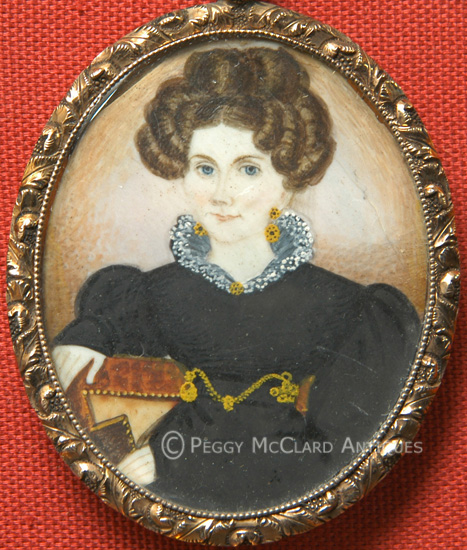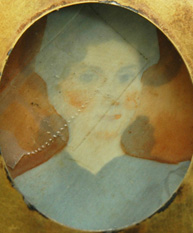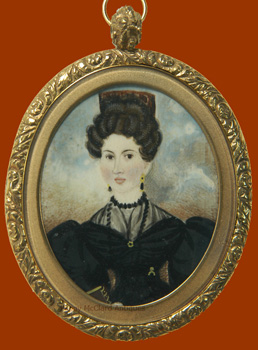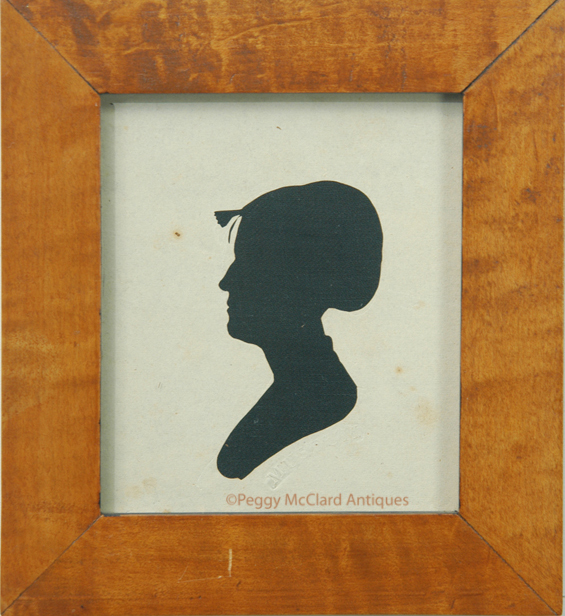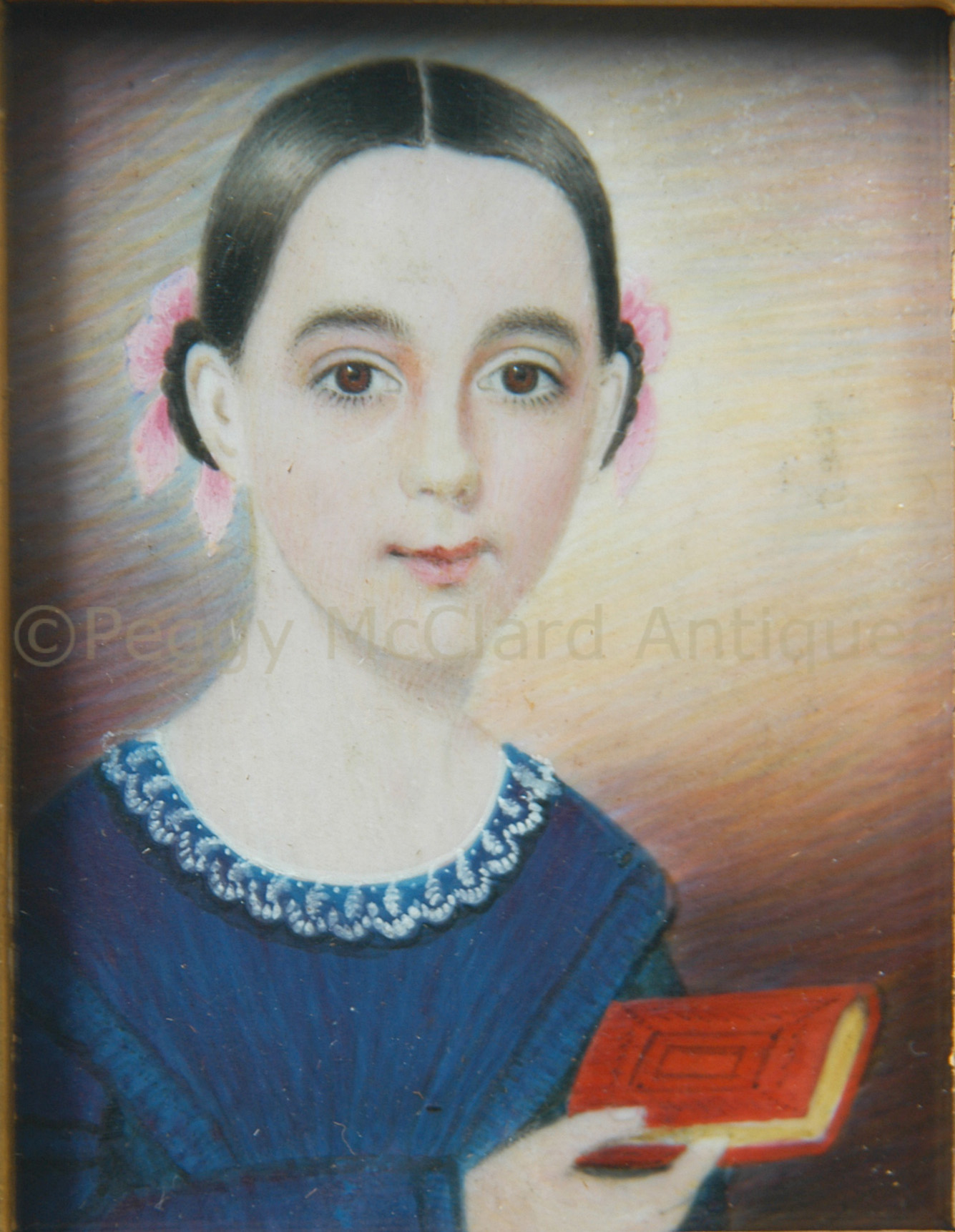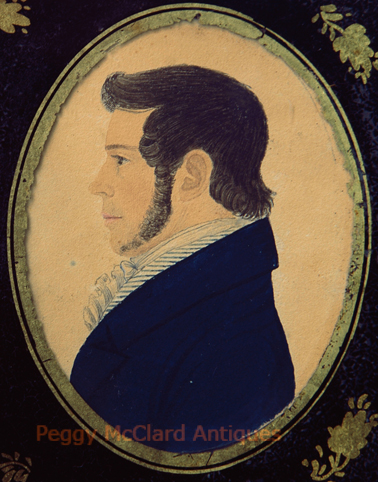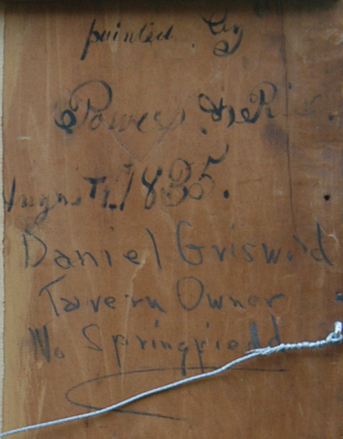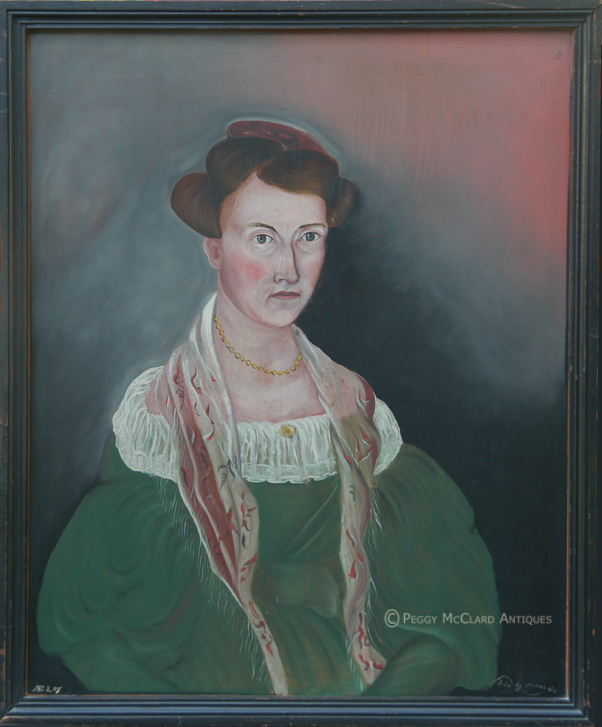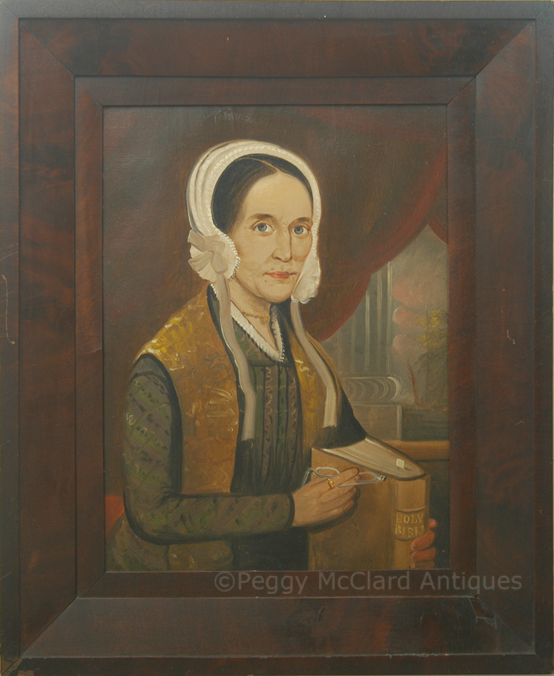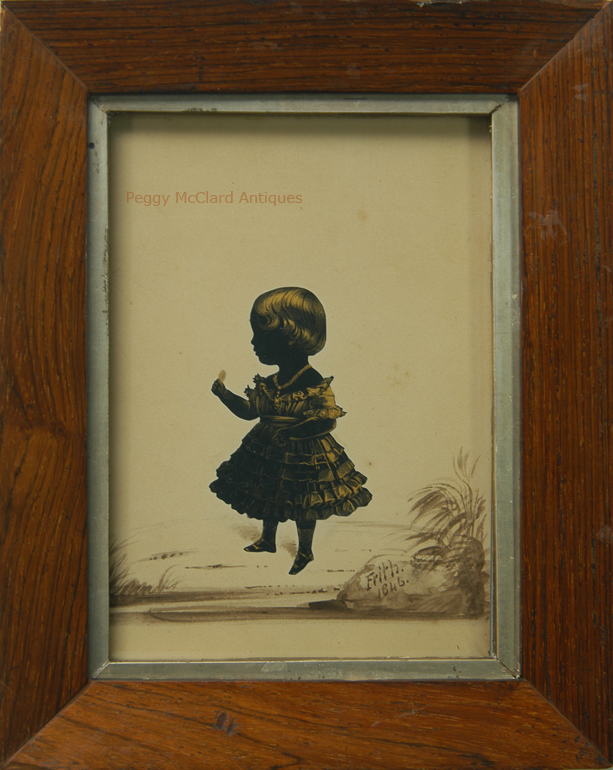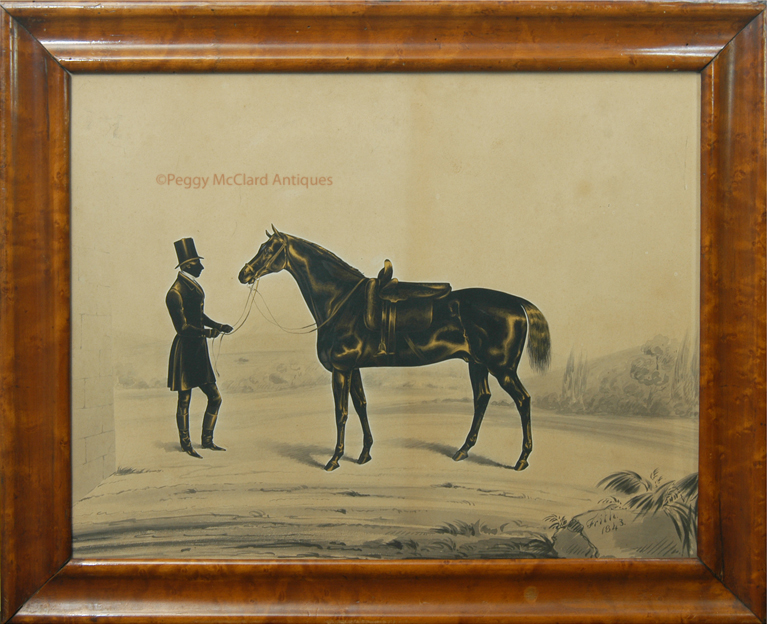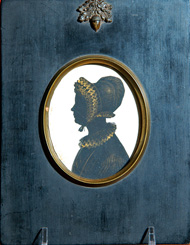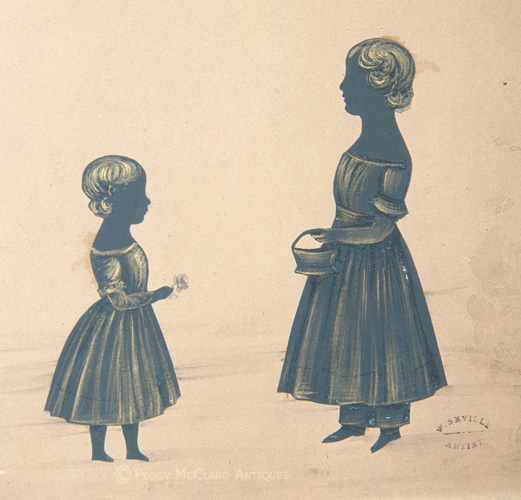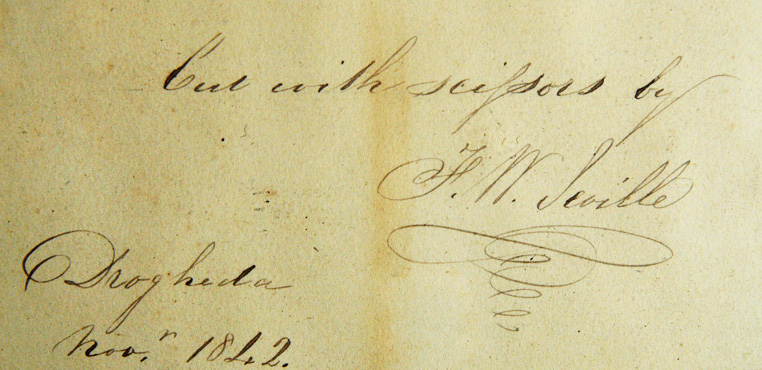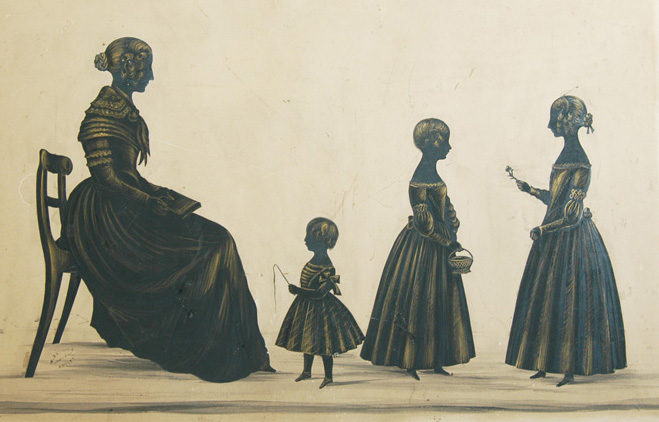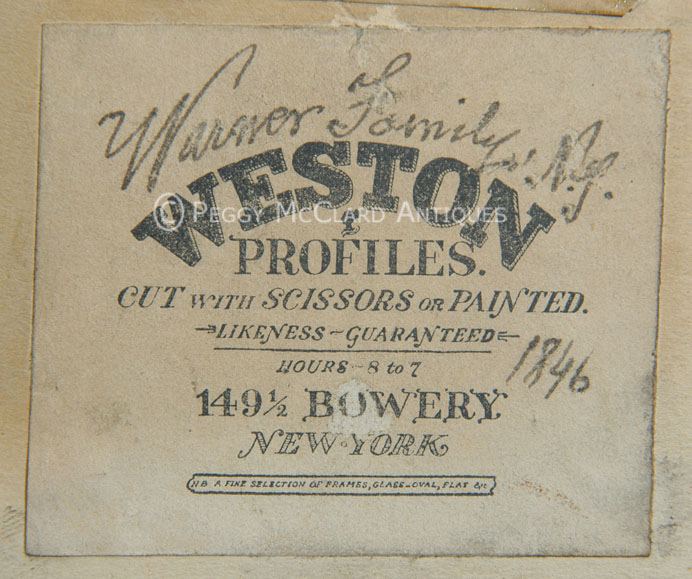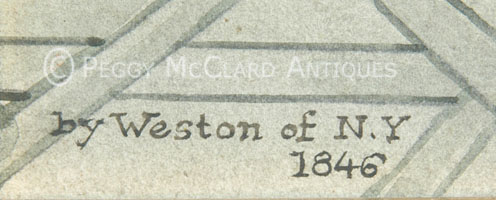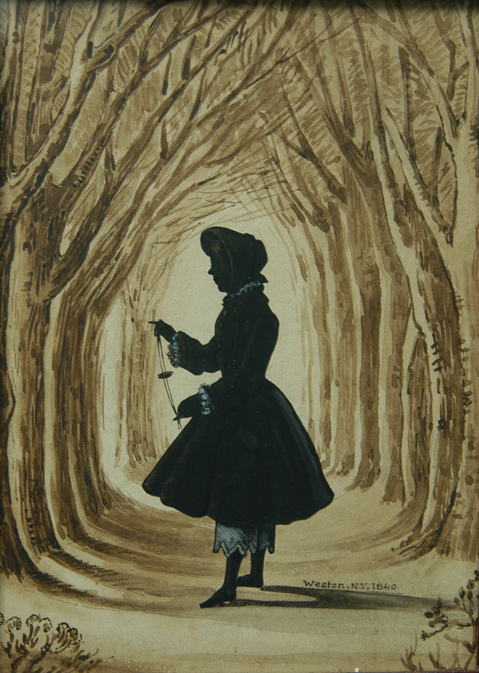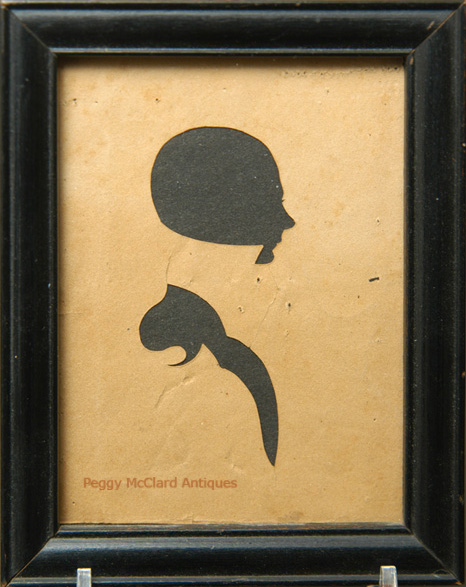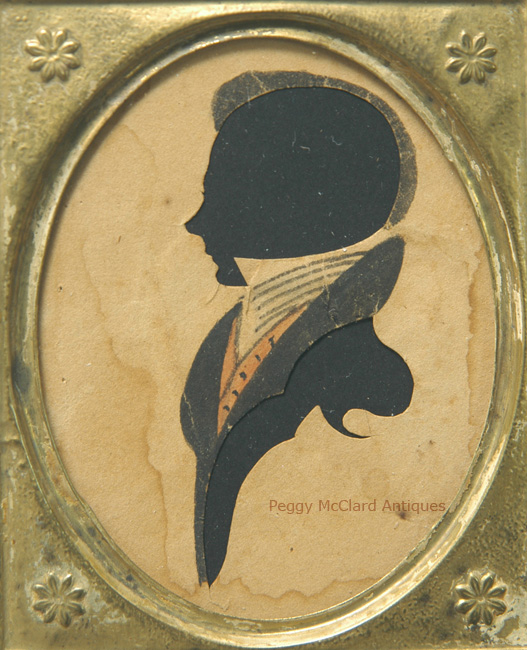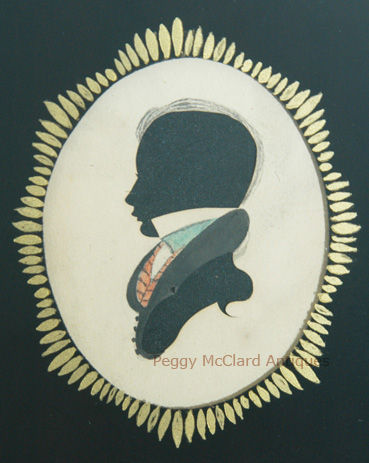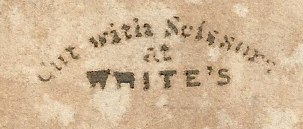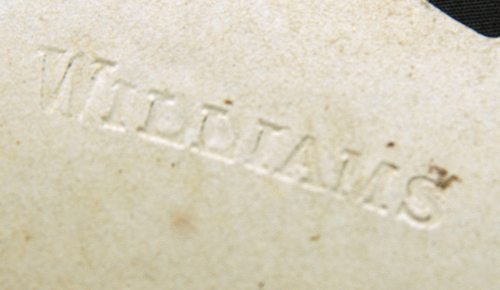Folk Portrait Artists
-

Edgar Adolphe (circa 1807-at least 1879)
Most of what we know about Adolphe comes from his trade labels and profiles. Many of his trade labels refer to him as a a miniature and profile painter. A few full color portrait miniatures are known but most of his work seems to have been silhouettes. The earliest recorded work by him appears to have been done in 1832 and has a trade label proclaiming Adolphe as "Miniature Painter and Profilist to Louis Philippe, Kind of the French." Louis Philippe was King of France from 1830-1848. Since Adolphe appears to have left France for England by 1832 or earlier, Adolphe must have gotten his appointment as artist to the Court fairly soon after the Louis Philippe's accession. It is thought that Adolphe spent some time traveling and painting through England before he settled in Brighton no later than 1838.
In British Silhouette Artists and their Work, McKechnie indicates that Adolphe probably worked in Brighton through the end of his career. He may have, but, if so, he must have changed careers because I found that he married Margaret Phibbs in 1856 in Dublin and still lived in Dublin without his wife in 1879. Since he was only about 50 years old in 1856, he must have still be working at some profession, even if not as an artist. Interestingly, I also found that Adolphe served 3 weeks in jail for libel in 1840 in Sussex.
A previously unrecorded trade label on the back of a circa 1840 silhouette gives the address 4, East St., Brighton, which was the last address that McKechnie found for him. According to McKechnie's book, Adolphe was listed in a business directory showing the East Street address, which was a tobacconist's shop that was managed by his first wife, Eloise. The trade label that I found states that, at 4, East St., Adolphe was working at the Manographic Institute. I have been unable to find any information about the Manographic Institute or of Adolphe's first wife, Eloise.
-
-
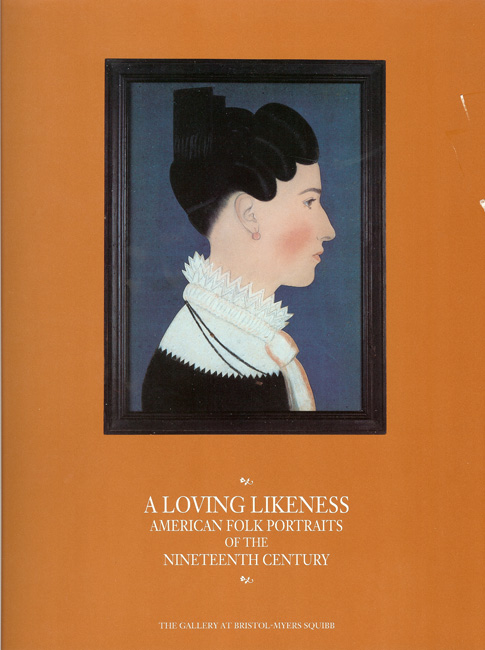
A Loving Likeness American Folk Portraits of the Nineteenth Century
This is one of my favorite books on folk portraits! This book represents the exhibit catalog of the 1992 exhibit of Raymond & Susan Egan's folk art collection at The Gallery at Bristol-Myers Squibb. It includes beautiful photographs of portraits and silhouettes of some of the most important American folk portrait artists of the 19th century. Brief biographical information is given for known artists within the collection as well as characteristics which help identify of the artist's work. The book is thin, but it has 60 information-packed pages and all of the many photos are in color. You will find yourself going back to this book over and over again for reference. If you collect folk portraits, you need this book!
This is a very good copy with a little scuffing to the covers and a slight crease in the top quarter of the back cover. Other than the minor cover scuffs, the book is in great condition with no marks to any pages. It does not have the supplement. Good copies of this book are getting increasingly hard to find and increasingly expensive. It's a great reference book!
(#4316) $70
This is a very good copy with the supplement. It has a mylar cover which is folded over the edges of the covers and taped down on the inside front and back cover. You could cut the tape and remove the cover--but it adds protection to the covers, so I would leave it where it is. The mylar cover has a wrinkle over the back cover. This book is becoming increasingly hard to find. It is nearly impossible to find any copy with the supplement, which is worth the extra money.
(#5549) $95
-
-
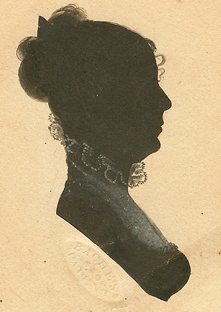
William Bache, American Silhouettist (1771-1845)
William Bache was born in Worcestershire, England but hurried to Philadelphia at the age of 22 years. He became established as a silhouettist almost as soon as he arrived and, later, traveled to the Southern States and West Indies to ply his trade as an itinerant artist. Bache and his partners, Augustus Day and Isaac Todd patented a physiognotrace in Baltimore in 1803. (See information about Day & Todd below.) Bache advertised "Cutting, shading and painting of profile likenesses in a new and elegant style from long experience and great success in business and aided by an improved Physiognotrace, feels confident of rendering general satisfaction." Bache surely delivered great satisfaction with his elegant hollow cut silhouettes, cut assuredly and made elegant with added India ink curls on the border of the cutting and Chinese white highlights added to the background paper. He referred to these stunning silhouettes as "shaded profiles." Bache also showed his artistic expertise with fully painted profiles, many which were reproduced in the 1920s and are now being offered as period silhouettes. We know through his scrapbook which descended through his family that he also cut many cut & paste silhouettes, although some naysayers believe that the silhouettes in Bache's duplicate books are "hole-in-the-donut" silhouettes (the middle "waste" of a hollow-cut silhouette). Scholars have basically debunked the hole-in-the-donut silhouette as mislabeled. Whether or not you believe that it is possible to cut a perfect hollow-cut silhouette and have a perfect image left afterwards without any trace of a scissor entry, the fact is that if a silhouette is cut as a positive image and pasted onto a background paper, it is a cut & paste silhouette. Part of Bache's scrapbook can be seen at the National Portrait Gallery's blog facetoface. The National Portrait Gallery acquired the books, which hold 1,846 images, numbered below each profile and the back of the book contains a partial index of sitters, identified by the numbers placed under the profile. I have also owned one of Bache's cut & paste silhouettes, on the reverse of a painted silhouette. The cut & paste was of the same figure on the obverse of the background card. Bache added his impressed stamp from the painted side, after he had pasted down the figure on the reverse. The impressed stamp is partially through the actual cut figure, showing in reverse.
In his short career, Bache cut or painted profiles of George and Martha Washington as well as Martha's daughter Mrs. Lawrence Lewis (née Nelly Cutis), Thomas Jefferson and Daniel Wadsworth, among others. Bache's career was cut short when, sometime between 1812 and 1822, a tree fell on him while chopping wood. As a result, Bache's right arm was amputated. Bache was appointed postmaster of Wellsboro, Pennsylvania and remained in that position until his death in 1845.
References:
Christman, Margaret C.S., Herein Hang a Tale, The Bache Silhouette Book", facetoface, National Portrait Gallery Smithsonian Institute, August 13, 2008.
Fallon, Rosemary & Lockshin, Nora, "Which Cracked First: The Inkin' or the Egg? Analysis and Treatment of Ink Deterioration in the William Bache Silhouette Album", The Book and Paper Group Annual 27 (2008), 123-24.
-
-
Ruth Henshaw Bascom (1772-1848)
Ruth Henshaw was born the oldest of 10 children, in Leicester, Massachusetts, to William (1735-1820) and Phebe Swan Henshaw (1753-1808). In 1804 at the age of 32, Ruth married Dr. Asa Miles (1762-1805) and moved to Westminster, Mass. He died a year after their marriage and Ruth returned to Leicester to by near to her family. During her time as a single widow, Ruth established a millinery business. Ruth married Rev. Lysander Bascom (1779-1841) in 1806 and moved to Phillipston where Rev. Bascom served as minister of the Congregational Church. Ruth never had children of her own but raised Bascom’s only child by his second marriage, Priscilla and the son of Bascom’s sister Eunice Loveland. In 1820, the Bascoms moved to Ashby, Massachusetts where Rev. Bascom served a church for 14 years. After Rev. Bascom’s retirement, he spent winters in Savannah, Georgia with his daughter for health reasons. Ruth, however, stayed in New England during those winters, visiting with friends and relatives while doing profiles. Around 1839 the Bascoms moved to Fitzwilliam, New Hampshire where the Reverend deems to have served a church on a semi-retired basis. He died in Fitzwilliam in 1841. Ruth spent her remaining years boarding in Ashby and traveling throughout Massachusetts and Maine. Rev. and Ruth Bascom are buried next to each other at Ashby First Parish Burial Ground. On her headstone is engraved the name “RUTHY H. BASCOM” and the note, “wife of Rev. E.L. Bascom, died Feb. 19, 1848, aged 75 years.”
Ruth Henshaw began keeping a diary in 1789 at the age of 14, and continued to do so for the rest of her life. She started a new volume every year and 54 volumes of her diaries were gifted to the American Antiquarian Society by Mary D. Thurston and Caroline Thurston in 1948. (The volumes for a few years are missing.) The diaries have provided scholars with a remarkably detailed description of everyday life of a New England woman in the 19th century and seemingly complete record of Bascom’s remarkably large body of artwork. Her diaries record nearly 1000 works of art.
Ruth’s first entry discussing the profiles that she drew and cut was made in 1801. The frequency of her discussions of profiles increases greatly in the 1820s and 1830s. There are only a few notations of receiving money for her sketches although scholars have written that Ruth stayed in New England during those winters when her husband went south not only to visit friends and relatives but to add to the finances of the family through her artwork.
Ruth’s profiles were made by placing her sitter before a paper and drawing the outline of the shadow. Unlike most silhouette artists of her day, Ruth did not attempt to reduce the size of the drawn profile, opting instead to fill it in with pastels (called crayons in the period). Her profiles have an abstract and soft feel achieved by her use of soft colors to fill in the precise outline and delineation of the ear, eye and a few other facial features. She sometimes added her own special touches such as cutting the profile out and placing it on a colored background or adding bits of tin or beads to the portrait as jewelry or buttons. Most of the backgrounds of Ruth’s work is done with a solid pastel crayon, she did some profiles on an abstract background of crayon. While we associate Bascom with full size pastel portraits, she also did some silhouettes. Of special note are 2 full-length, but reduced in size, cut and paste silhouettes of Chin-Sung, a Chinese teacher who spent several months in 1841 at Leicester Academy where he studied English. Her cut silhouettes of the young Chinese man in his “native costume” are very detailed and the departure from her usual full-size pastel profiles is her interest in his clothing. Chin-Sung captured interest everywhere. He also visited Washington, DC where his silhouette was taken by master silhouettist Augustin Edouart. Bascom’s silhouettes of Chin-Sung are in the collection of Old Sturbridge Village.
References:
Avigad, Lois S., "Ruth Henshaw Bascom: A Youthful Viewpoint", The Clarion Vol. 12, No. 4 (Fall 1987) Museum of American Folk Art,, New York, 1987. 35-41.
Bascom, Ruth Henshaw, Summary of Papers 1789-1848, American Antiquarian Society Manuscript Collections, http://www.americanantiquarian.org/Findingaids/ruth_henshaw_bascom.pdf
Rumsford, Beatrix, American Folk Portraits Paintings and Drawings from the Abby Aldrich Rockefeller Folk Art Center, Boston: Little Brown, in association with Colonial Williamsburg Foundation (1981). 49-50.
Sloat, Caroline F., ed., Meet Your Neighbors: New England Portraits, Painters & Society 1790-1850, Old Sturbridge Village, distr. University of Massachusetts Press, 1992. 74, 81-82, 100, 111, 119.
Please view the Ruth Henshaw Bascom currently in inventory on the Portraits page.
-
-
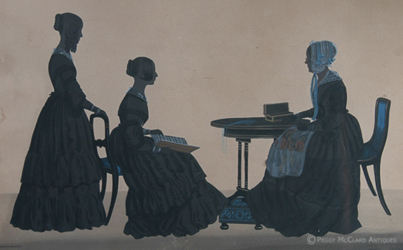
William Dyce (or Dyer) Beaumont (active c. 1833-1850)
Beaumont's work is known for his use of sepia or dark brown paper from which he cut elegant and graceful women which he accented with subtle but highly unusual touches of color. Beaumont is known to have worked since the 1830s although his early work is not as successful as his later work. He cut men as well as women, but it is his women which are the most highly sought. His women were well placed with chairs of the early Victorian period and accessories such as ornate tea tables, stools, books, morocco-bound leather books, music scores, and sewing. Carpets are sometimes shown in color but to date we have no record of further painted backgrounds. His silhouettes of the 1840s and beyond has been called "among the finest of the period." McKechnie, Sue, British Silhouette Artists and their Work: 1760-1860 (Sotheby Park Bernet Publications, 1978) 190. Woodiwiss said, "Beaumont enjoyed using colour and always did so with the blending and discrimation of good taste. He arranged the details of his grouping with infinite care and his silhouettes may fairly be described as perfect examples of Victorian calm and breeding." Woodiwiss, John, British Silhouettes (Country Life Limited 1965) 68. According to McKechine is known to have signed his silhouettes "Beaumont", "W.H. Beaumont", W.H. Beaumont, fecit [date]." See McKechnie at page 190. In 2005, Diane Joll of the Silhouette Collectors Club reported that Christies sold Beaumont silhouettes signed, "W.D. Beaumont" and "Dyce Beaumont" so we all assumed that McKechnie was mistaken in saying that Beaumont signed with "H." Recently, a pair of silhouettes sold on ebay with the signatures "W. Dyer Beaumont, fecit, 1851". Therefore, we must also wonder whether Ms. Joll was mistaken (she included no photo of the Christie's silhouette signatures) or whether the pair on ebay had fake signatures (the signatures of the two pieces bore somewhat different handwriting). The simple neat signature "Beaumont" such as the one photographed on the right is well-recorded on the majority of Beaumont's work. One trade label has been recorded.
-
-

Zedekiah Belknap (1781-1858)
Zedekiah Belknap was born in Ward, Massachusetts (later renamed, Auburn) to Zedekiah (sometimes listed as Hezekiah) and Elizabeth (née Waite). He graduated, in 1807, from Dartmouth College where he studied divinity. The Catalogue of the officers and members of the Society of Social Friends, Dartmouth College, lists him as Reverend Zedekiah Belknap in 1839 and shows his residence as Boston. He married Sophia Sherwin of Maine, but there are no records of them having children. Belknap worked as an itinerant artist, painting portraits in Massachusetts, New Hampshire, New York and Vermont. There is no record of Belknap having received professional art training. His early paintings show an effort to paint in an academic manner. However, like many folk artists, Belknap soon developed a formulistic method of portrait painting that pleased his middle-class clientele. This formula allowed him to paint rapidly and efficiently.
His work is striking in that the mostly full-size images are bold and decorative. His sitters are boldly outlined with little modeling. His work is distinctive in that he always depicted only one side of the nose, outlining its profile with a heavy reddish shadow. The facial features are prominently depicted with full mouths, sharply outlined round eyes and flat, red ears. The women in his portraits are featured with strongly accented corkscrew curls, arched eyebrows, boldly painted lace and jewelry, giving these portraits strong decorative appeal.
Late in his career, Belknap began to depict his sitters in a more realistic, less decorative, manner. It is believed that this change in style was a reaction to popularity of the new daguerreotype which was overtaking the desire for more expensive portraits. His last known dated portrait is 1848, 10 years before his death. He ended his days on his farm in Springfield, Vermont, cared for by his sister and her husband.
Belknap's work is included in the collections of major art museums such as Abby Aldrich Rockefeller Folk Art Museum, Fenimore Art Museum and The Detroit Institute of Arts.
References:
Baker, Mary Eva, Folklore of Springfield, Springfield, Vt.: The Altrurian Club, 1922, online at Ancestory.com.
Krashes, David, "An Appreciation of Nineteenth-Century Folk Portraits", Antiques & Fine Art Magazine online.
Rumsford, Beatrix, American Folk Portraits Paintings and Drawings from the Abby Aldrich Rockefeller Folk Art Center, Boston: Little Brown, in association with Colonial Williamsburg Foundation (1981) p. 57-60.
-
-
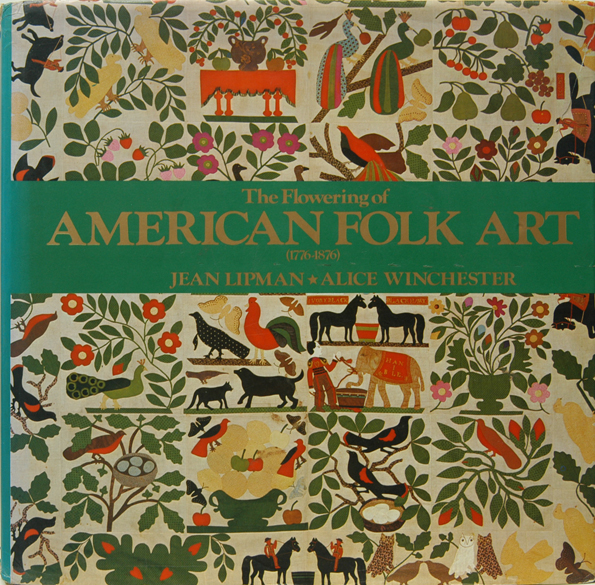
The Flowering of American Folk Art (1776-1876)
This is a landmark book of American folk art illustrating more than 400 outstanding examples of folk art produced during the period of its finest flowering. The objects shown in this book were selected from more than 10,000 examples owned by institutions, collectors, and dealers. This book documents the first major exhibition to survey the entire range of American folk art. Four major categories of works are represented: pictures that are painted, drawn, and stitched; sculpture; architectural decoration; and decorated household objects. Of the 400 illustrations, 100 are in color. Additionally, there are brief essays on each type of object; detailed captions for each work; biographical notes on the artist; and a selected bibliography. This is a go-to reference book for anyone who collects American folk art.
This copy is on fine condition a very good dust jacket. No markings on the pages, tight binding, just a touch of expected yellowing to the pages, especially at the edges. The dust jacket has tears at the binding edges (the dust jacket is not bound, I'm trying to say, the part of the dust jacket that covers the book binding).
(#5260) $25
-
-
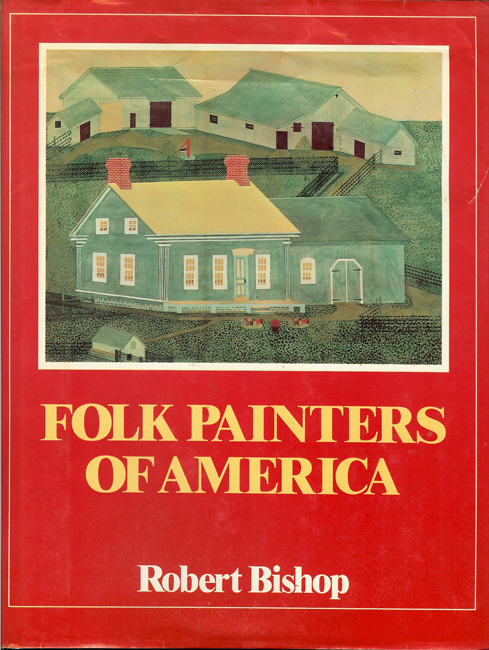
Folk Painters of America
Wonderful reference book of American folk painting of the 18th, 19th and early 20th centuries. Bishop describes and illustrates two broad categories of folk painting: "pictures that recorded people, places, and time, and paintings that decorated essentially utiltarian objects, such as signs, fireboards, mantels, room ends, floors and floor carpets, windowshades, walls, ceilings, and furniture." This seminal book covers those two broad categories with wonderfully written text and more than 400 illustrations (70 in color). Chapters are split into geographical areas to help you identify trends that carried through the centuries in those areas. This is a wonderful book that I go to often in my research. It covers well-known and little-known artists. You'll love having it in your library.
This is a very good copy of the book with no markings on the pages and a good tight spine. The dust jacket is in good condition with scraping on the spine (of the dust jacket, not the book) and small tears and bends along the top and bottom edges.
(#5004) $25
-
-

John Brewster, Jr., (1766-1854)
John Brewster, Jr. (1766-1854) was born in Hampton, Connecticut to Dr. John Brewster and his first wife, Mary Durkee. John, Jr. was born deaf at a time when there was no established, commonly used sign language. This fact certainly made his chosen profession of itinerant painter even more challenging than the norm. But he had been born into a socially-connected family, and descended from Elder William Brewster, who led the Pilgrims to America on the Mayflower. His family connections allowed him to move easily between the socially elite of Connecticut, Maine and New York where he plied his trade as an itinerant artist. Brewster’s deafness certainly colored his world and influenced his art which is exhibited in many major museums. Art historians have labeled his paintings as “masterpieces” and “landmark” of American painting. In his book on Brewster, Harlan Lane argues that “Brewster was not an artist who incidentally was Deaf but rather a Deaf artist, one in a long tradition that owes many of its features and achievements to the fact that Deaf people, are,…, visual people.”1.
Brewster began his career as a painter around 1790, when he painted full-length portraits of his father and step-mother. He studied with a local artist, Reverend Joseph Steward who was influenced by the work of Ralph Earl. It appears that Earl’s work also influenced Brewster, however, Brewster developed a much simpler formula which became a backbone of American folk portraiture.
He moved to Maine with family members in 1796 and painted the majority of his identified portraits there. We know by his newspaper advertisements, that Brewster spent some of the first years of the 19th century in Newburyport, Massachusetts. He interrupted his painting for a time when, at the age of 51 in 1817, he entered the Connecticut Asylum for the Education and Instruction of Deaf and Dumb Persons in Hartford. His year of enrollment was the first year of the opening of the Connecticut Asylum, which was the first American school for the deaf. Brewster remained at the school for three years, during which he paid his own tuition, presumably from money earned with his painting. It was during Brewster’s time at the Connecticut Asylum that American Sign Language was developed.
Brewster’s portraits have long been recognized as some of the strongest likenesses produced by an itinerant artist during this period of the New Republic. His work is known for serene expressions, clearly delineated features and delicate flesh tones. It is said that the expressiveness with which Brewster painted the eyes of his subjects may be due to the great importance of eyes and sight to the deaf-mute artist.
1. Lane, Harlan, A deaf Artist in Early America, The Worlds of John Brewster Jr., Beacon Press, Boston, Massachusetts, 2004, xvi.
References:
American Folk Art Museum, Exhibition, A Deaf Artist in Early America: The Worlds of John Brewster Jr., October 4, 2006–January 7, 2007,
Cotter, Holland, “"Intense Visions by a Painter Who Couldn’t Hear”, New York Times, October 6, 2006,
Lane, Harlan, A deaf Artist in Early America, The Worlds of John Brewster Jr., Beacon Press, Boston, Massachusetts, 2004.
Please view the Brewster portrait miniature currently in stock on the Portraits page.
-
-
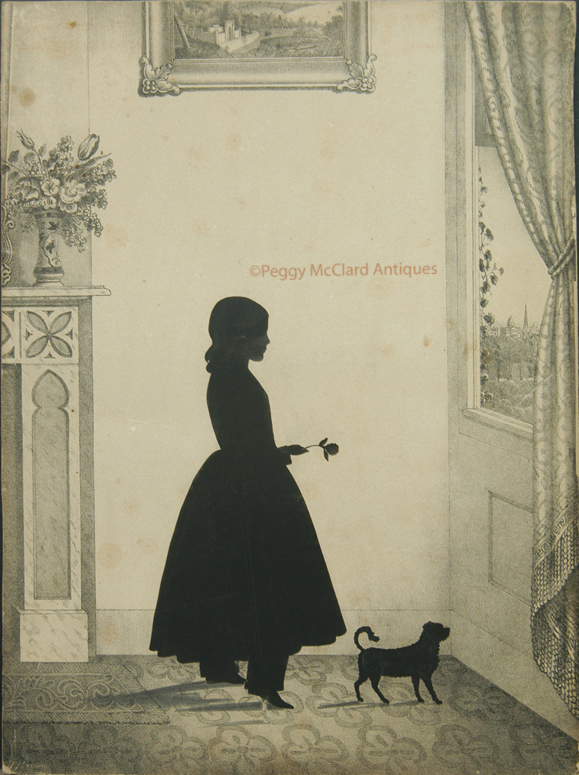
William Henry Brown, American Silhouettist (1808-1883)
William Henry Brown was born and died in Charleston, South Carolina. He worked as an engineer in Philadelphia where he lived from 1824 until at least 1841. He began his career as a silhouettist in the 1830s working first in New England and then traveling widely throughout the South. Brown pursued his career as an artist until at least 1859. After 1859, Brown is known to have resumed his work as an engineer.
Although Brown is often compared to Edouart, he began cutting silhouettes almost 15 years before Edouart ever set foot in America. Brown made his debut as a silhouettist in 1824 with a full-length silhouette of General Lafayette. Brown was a mere sixteen years old at the time. Like Hubard, Brown was considered a child prodigy. Also like Hubard and Edouart, Brown cut his silhouettes freehand with common scissors. His embellishment is subtle and superbly rendered.
Brown often mounted his silhouettes on lithograph backgrounds, made for him by the Kelloggs of Hartford. He is most well known for his book Portrait Gallery of Distinguished Americans published as a collection of full-length silhouettes with biographical sketches and letters written by the subjects. The book was published in 1846 by E.B. & E.C. Kellogg. Almost the entire edition was destroyed by fire and it is rare to find a complete copy of the book. Luckily, the Kelloggs also published the individual silhouettes from Brown’s book as lithographs. This lithography is most often what can be found on the market from Brown’s career. Original silhouettes are difficult to find despite the fact that Carrick believes he was as prolific as Edouart.
Besides the single figures that we most likely think of when hearing Brown’s name, he was a most industrious artist who cut profiles of an entire train, a fire brigade, and even a funeral procession. His silhouette of the St. Louis Fire brigade contained an engine, two hose carriages, and sixty-five firemen. The finished grouping was 25 feet long! Brown’s rendition of “The De Witt Clinton” train is over six feet long and may be viewed in the Connecticut Historical Society where it has hung since Brown presented it to the Society himself.
-
-
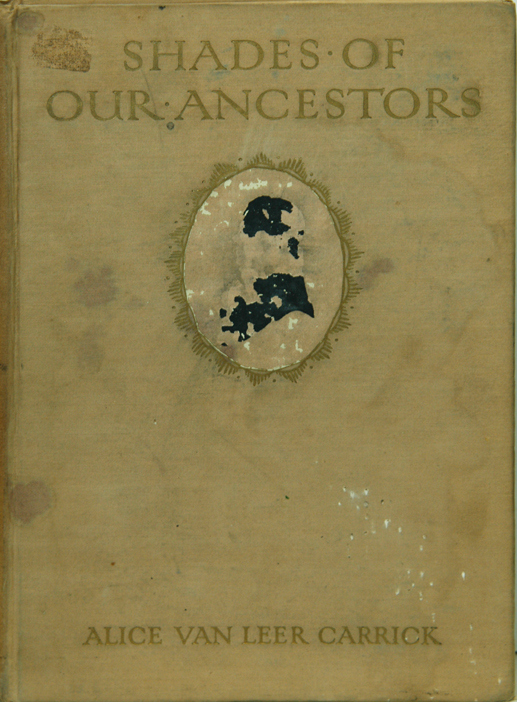
Shades of our Ancestors
One of my favorite books, a great read and a wonderful place to learn about American silhouettes and silhouette artists. Great reference material, lots of good black & white illustrations (plus one beautiful color frontpiece), and the stories will make you fall in love with American silhouettists. This is a very good reference copy with a good strong spine but the cover is not so pretty. The cover (which you see at the left) has most of the cover silhouette rubbed away. The cover is stained and dirty and the back cover has a large waterstain (see below). The pages to the front and rear of the book have expected yellowing but the majority of the pages are surprisingly bright. No markings on the pages that I can find. 1st edition. The book is becoming increasingly hard to find and it really is a good book to read and learn.
Sale Pending-
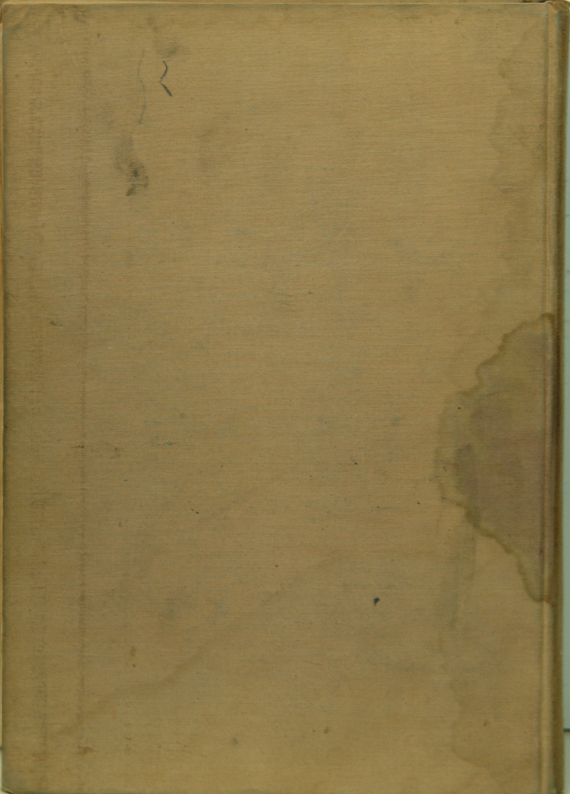 The back cover of the photo above.
The back cover of the photo above.
-
-

William Chamberlain, American Silhouettist (1790-1860)
Little is known about William Chamberlain although his silhouettes epitomize everything that is loved about American folk silhouettes.
Genealogy research tells us that he was born on April 3 (or 13), 1790, in Loudon, New Hampshire, the child of Captain Moses and Rebecca (Abbot) Chamberlain. He married Mary Ann Baker in 1813 or 1814. Together, they had one daughter, Mary Chamberlain, born in Loudon on August 28, 1835. In the 1850 census, Chamberlain listed himself as a chair-maker, leading us to speculate that either the life of an itinerant silhouettist was not profitable or that he wanted to find a way to stay home with his family. Chamberlain died at age 70 on April 13, 1860. He was buried in the Plains Cemetery, Boscawen, NH.
Carrick, in Shades of Our Ancestors tells us that Chamberlain went on a two-year silhouette cutting tour through Massachusetts, New Hampshire and New York. His grand-daughter, Mrs. Frederick McClure of Worcester, Massachusetts, gave to the American Antiquarian Society ("AAS") eighty-nine hollow-cut silhouettes done by Chamberlain and kept for himself. Chamberlain cut the donated silhouettes during a two year period in which he traveled New England in the 1820s, as an itinerant silhouette artist. Mrs. McClure added a note to her donation saying "He made the profiles with the aid of a profile machine. He usually cut his profiles in duplicate, and these are the ones he preserved." It is these eighty-nine silhouettes that allow us to attribute work to Chamberlain because he never signed nor stamped his work.
Chamberlain's work is hollow cut. He cut the heads of his men, left the collar and shirt front as an uncut part of the background paper, then cut the shoulder to the end of the bust-line. He then drew and painted the shirt and collar details. The women in his duplicate folio are completely hollow cut, from the top of the head to the bottom of the bust-line. I set about examining photocopies of the 89 silhouettes in the duplicate folio sent to me by the AAS and found that Chamberlain cut every silhouette in the folio with the same bust-termination line. Every silhouette that we know with certainty was cut by Chamberlain has a convex curve at the front of the bust-line, coming up at a notch, then a concave curve to the back.
Almost every bust-length hollow cut man in which the collar and shirt front are left uncut with drawn-in details has been attributed to Chamberlain by uneducated dealers. Collectors should beware of such misattributions and look for examples of Chamberlain's work before spending a lot of money on a "Chamberlain" from a dealer who does not specialize in silhouettes. Examples may be found in Carrick's book and Silhouettes in America, 1790-1840 by Blume J. Rifken.1 I am currently offering a copy of both of the reference books on the Books page.
1After studying photocopies of the silhouettes in the Chamberlain duplicate book, I must disagree with Rifken's attribution to Chamberlain on pages 50-51. While Chamberlain might have cut those silhouettes, the bust termination is not the same as those in the duplicate book, which are the only ones we know with certainly were made by Chamberlain.
Please view the Chamberlain silhouettes currently in stock on the Silhouettes page.
-
-
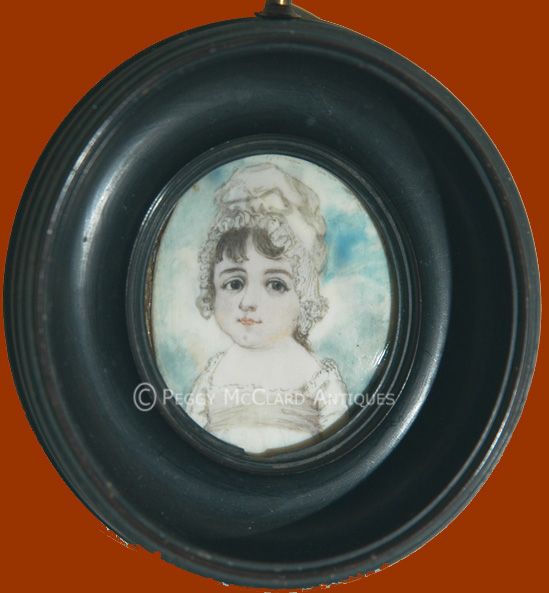
A. Charles (born circa 1768;active 1786-1807)
A. Charles is known for his portrait miniatures and silhouettes, which he painted on card, glass and on ivory. His story is interesting in that he seems to have perpetually elevated his standing in his advertisements. He advertised himself as the "Original Inventor of painting on glass", an endorsement that was, in all likelihood, not true. Although silhouettists and painters of the late 18th century were given to self-endorsement, Charles was a braggart to the point of drawing public criticism. He advertised that he was a Royal Academician, which he was not. He also advertised that he had studied "the Italian, Flemish, and all the great Schools," of which there is no confirming record. When he began to advertise himself as the artist to the Prince (which was a true statement) and raised his prices, a blistering criticism was printed in the London paper...which shows that Charles was definitely a well-known profilist who was in direct competition with the great John Miers and Mrs. Beetham. Had he been an artist who waltzed through life unnoticed, he might have gotten away with his boasts. Since he was obviously in the public eye and compared to his contemporaries, his boasting became a public embarrassment.
-
-
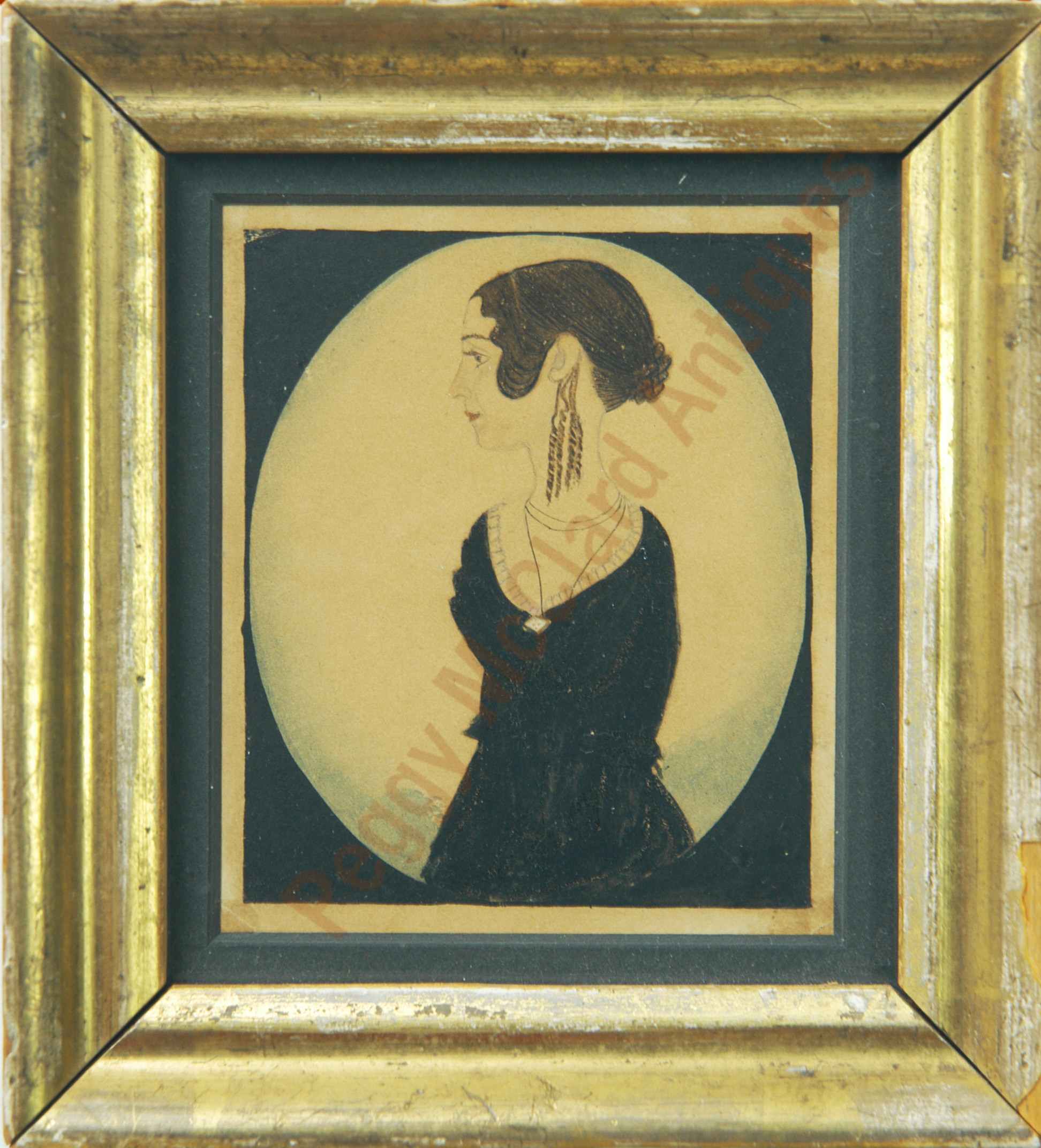
The Da Lee Family: Justus Da Lee (1793-1878), Amon G.J. Da Lee (1820-1879), Richard W.M. Da Lee (1809-1868)
Long recognized as one of the great American folk art portrait artists, reliable information about Justus Da Lee and his family have only recently been published.1 Painstakingly rendered watercolor, pencil, and ink portrait miniatures, such as the one offered, and elaborate family records have long been attributed to Da Lee. Now we know that portrait painting was a family business in which Justus enlisted the help of his son Amon and his brother Richard. Born in Pittstown, New York, the obviously artistically inclined Justus enlisted in the Cambridge militia during the War of 1812, where he served as a musician. After his war duties, the highly educated Justus served as a school teacher until he lost his job for "usurping government." By 1826, Justus exhibited his artistic ability in a sketchbook entitled "Emblematical Figures, Representations & To Please The Eye." Justus referred to himself in the sketchbook as a "professor of penmanship."
Justus' painting career appears to have begun in the early-1830s. He painted a family record printed which he then further embellished with figures, flowers and decorative elements. It is at this time that he also began painting the distinctive small profile portraits for which he is best known. Justus taught his son Amon and his brother Richard to paint portraits. A 1837 letter from Justus to Richard states that painting had become a family business. Justus' own letters tell us that when he arrived in a new town, he distributed advertising cards to homes along a single street. The next day, he returned to the houses, showing samples and taking commissions. His prices were "3 dol. for a single one, set [framed]--or 5 dol. for husband & wife, set,' and a price of $2.50 each if the whole family was painted. Unlike most itinerant watercolor profilists of the era, Justus took his time painting the profiles stating "I detained some of them from 1 or 2 hours being determined to give the very best satisfaction." Perhaps it was the slow, deliberate perfectionist quality of the Da Lee work that brought about the end of the family portrait business.
Letters from Justus and from Richard show that they often complained that, although everyone was pleased with their work, their itinerant trips only took in a small amount of money. In 1845, Justus wrote "Amon . . . has given up going out to take ports anymore, it does not agree with him at all . . . this portrait business is calculated to kill us all." By 1848, two business directories in Buffalo, NY list Justus as an artist but also list Justus & Amon as grocers. Apparently, painting was no longer a full time occupation for the Da Lee family. The 1850 census lists Justus as a teacher and by 1856, records show that Justus was blind and penniless. He died in 1871 while living with his daughter Harriet in Wisconsin.
Thanks to the scholarship of Suzanne Rudnick Payne and Michael Payne, we now know that portraits previously attributed to Justus Da Lee must be attributed to the Justus Da Lee family. The Paynes tell us that known examples of work by Amon are "confusingly similar" to the work of Justus. There are no known signed examples of Richard's work but the portrait of Richard's son indicates that Richard's work was also very similar. Moreover, much of the work seems to have been a collaborative affair as Justus wrote in 1839 that Amon was painting the dresses and Justus was doing the rest of the portrait.
The Paynes describe the Da Lee portraits as follows:
"These small profile portraits were executed in watercolor, pencil, and ink with meticulous detail and delicacy using minute brushwork. A few portraits were painted on paper, but the vast majority was done on stiff bristol board, as it was called when the portraits were made. Ink and pencil were used to delineate the facial features and hair, and then watercolor was used to render flesh tones, hair, and clothing. Gum-arabic glazed highlights were used to further define the details of the clothing. Small details, such as jewelry and hair ornaments, were always so finely rendered that they invite examination with a magnifying glass. The portraits have an unusual delicacy and quality of detail."
The faces in adult portraits were always presented in profile. Men's bodies were always profile. A few of the earliest of the women's portraits were painted with a full frontal pose. By the 1840s the Da Lees were using both a three-quarter frontal and a profile pose for the women. Most of the portraits are contained within solid-black painted oval spandrels and many have blue wash along the inside of the spandrel. Although it has been surmised that the black painted spandrel was in the style of daguerreotypes, the Da Lees were using this format in the 1830s before daguerreotypes were widely offered.
References:
Anderson, Marna A Loving Likeness American Folk Portraits of the Nineteenth Century, Bristol-Myers Squibb Co. (1992) 11-13.
Brownstein, Joan R. & Shushan, Elle, "Side Portrait Painters, Differentiating the DaLee Family Artists", The Magazine Antiques, July-August 2011. Click the link to read the pdf article posted on Elle Shushan's website.
Payne, Suzanne Rudnick and Michael Payne, "To Please The Eye Justus Da Lee and His Family", Folk Art Magazine, 47 (Winter 2004/2005). Pdf copy of article published with permission of the American Folk Art Museum. (The article is contained in a large pdf file and may take a while to load onto your computer. It has beautiful color photos and is worth the wait.)
Rumsford, Beatrix, American Folk Portraits Paintings and Drawings from the Abby Aldrich Rockefeller Folk Art Center, Boston: Little Brown, in association with Colonial Williamsburg Foundation (1981) p. 77-79.
1Biographical information and description of the Da Lee family work gleaned from Suzanne Rudnick Payne and Michael Payne, "To Please The Eye, Justus Da Lee and His Family", Folk Art Magazine, 47 (Winter 2004/2005).
Please view the Justus Dalee portrait currently in inventory on the Portraits pages
-
-
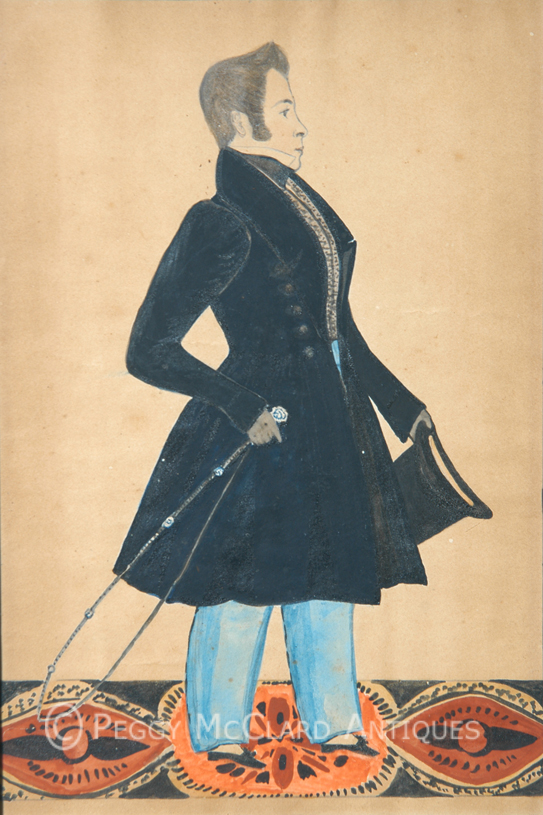
Joseph H. Davis (1811-1865) (active 1832-1837)
Approximately 160 watercolor folk portraits have been attributed to Joseph H. Davis since his work was identified in the 1930s. However, little was known about the artist until the biographical research done by Arthur and Sybil Kern. The Kerns confirmed the common speculation that the artist Davis was the man from Limington, Maine known as "Pine Hill Joe." Pine Hill Joe was remembered as "a farmer inclined to suddenly leave his farm to go wandering from town to town 'painting pictures of people on little sheets of paper.'"2
According to the Kerns, Joseph H. Davis was born on August 10, 1811 to Joseph and Phebe (née Small) Davis in Limington, Maine. He was 21 years old when the first of his known portraits was painted in 1832. Davis is known to have painted in the Lebanon-Berwick area of Maine and Dover-Somersworth area of New Hampshire. Many of his subjects had a connection with the Freewill Baptist Church, leading to supposition that Davis was connected with this church. Davis married Elizabeth Patterson on November 5, 1835. Five days after the marriage, the first of what was to become many land transactions was recorded in what was apparently Davis' new profession as a land trader.
Davis' most prolific years of painting appear to be 1835 to 1837, after which no dated paintings have been found. [The painting pictured here appears to negate the previous statement as the inscription on the verso of the frame dates it at 1838. However, the inscription does not appear to be contemporary with the painting and family history often includes errors.] He may have increased his production of paintings to support his new wife. Both the increase of his success as a land trader and the impending birth of his daughter in 1838 may have contributed to the end of his career as an artist in 1837. Perhaps he felt the need for less travel than was required by an itinerant artist and perhaps the land trading business paid him more handsomely than the art business in which he charged only $1.50 per portrait.3 After the last known portrait was painted in 1837, the Davises moved often, living in Massachusetts, Maine, and New Jersey. His success as a land trader is indicated by numerous recorded deeds. Joseph H. Davis' death is listed in the records of Woburn, Massachusetts as follows: "Davis, Joseph H., son of Joseph and Phebe (b. in Limington, Me.), of disease of liver. May 28, 1865, 53y.9m.18d."
As an artist, the work of Joseph H. Davis stands out as a stunning example of the American Fancy Period of the 1830s even though his work is naïve and obviously self-taught. He depicts his sitters in profile, with their bodies slightly turned to reveal more of their clothing. Single figures generally face the right. Couples generally face each other, whether painted together or in two individual paintings. The great majority of his work depicts sitters in full length, although five half-length recorded portraits have been attributed to Davis. The trademark of Davis' work is his glorious use of color and pattern in the vibrant floorcloths or patterned floor decoration that he placed under most of his subjects' feet and the garishly grained or paint decorated tables and chairs he included in family portraits. These family or couples portraits portray a variety of personal accessories that are likely more symbolic than real. Davis often included the exterior of the couple's homestead in a painting that he placed on the background wall (which was usually elaborately swagged). Women often carried colorful patterned reticules or purses. Several portraits include a cat. Books symbolized the education of the family and the inclusion of a bible represented their faith. Davis' settings are based on an artificial formula that varied little from painting to painting. That said, they are fabulous examples of the exuberance of the American Fancy Period and were surely loved by their consignors because they depicted the sitters in the American middle-class dream parlors of the 1830s. The portraits and accoutrements were drawn on wove paper in pencil and then painted in with watercolor. Some of his work included an inscription across the bottom with the names of the sitters, sometimes their ages, birthdates, and hometown. As of 1992, only six signed works had been found. One of the six was signed "Joseph H. Davis/Left Hand/Painter."
References:
Anderson, Marna A Loving Likeness American Folk Portraits of the Nineteenth Century, (Bristol-Myers Squibb Co. (1992). 16-17.
D'Ambrosio, Paul S. and Emans, Charlotte M., Folk Art's Many Faces: Portraits in the New York State Historical Association, New York State Historical Ass'n, Cooperstown 1987. 58-64
Kern, Arthur B. and Kern, Sybil B., "Genealogy and Historical Research: "On the Importance of Genealogical Methodology in Researching Early New England Folk Portraitists", The Art of Family, Genealogical Artifacts in New England, Ed. D. Brenton Simons & Peter Benes, New England Historic Genealogical Society, Boston 2002. 254-59.
Rumsford, Beatrix, American Folk Portraits Paintings and Drawings from the Abby Aldrich Rockefeller Folk Art Center, Boston: Little Brown, in association with Colonial Williamsburg Foundation (1981). 83-87.
Savage, Gail & Norbert H., and Sparks, Esther, Three New England Watercolor Painters. Art Institute of Chicago, 1974. 22-41.
2Kern, supra at 97, (quoting Sinney, Frank O., Primitive Painters in America: An Anthology by Jean Lipman and Alice Winchester (New York: Books for Libraries Press, 1950).
3D'Ambrosio, supra at 59.
-
-
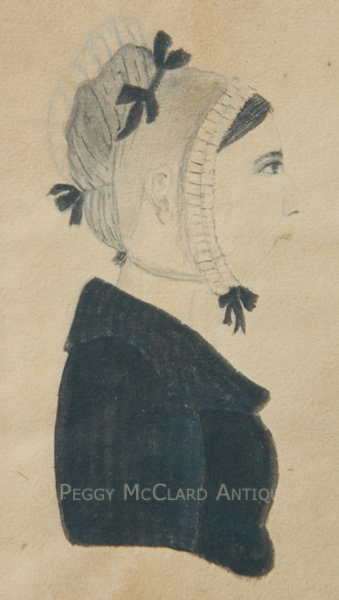
J.A. Davis (1821-1855)
When Jane Anthony Davis signed her work, it was as "J.A. Davis" and until research done by Arthur and Sybil Kern in 1981, she was thought to be a man, probably from Rhode Island or Connecticut. Through meticulous research and the discovery of family descendents, the Kerns learned that Jane Anthony was born in Rhode Island on September 24, 1821, married Edward Nelson Davis of Connecticut in 1841 and died in Rhode Island at the young age of 33 on April 28, 1855. Ms. Davis attended the Warren Ladies Seminary in Warren, Rhode Island for at least two terms in 1838. All of her known dated portraits were painted after her education at the Seminary. This suggests that the seventeen year old Jane may have begun painting seriously while attending the Seminary. From found dated portraits, Ms. Davis appears to have taken two breaks from her portrait painting: first the years 1840 to 1842--a hiatus probably attributed to Jane preparing for her wedding and then moving to Connecticut; second from 1844 to 1848--coinciding with Mr. and Ms. Davis moving back to Rhode Island and the birth of Jane's second child. The last dated portrait found was painted on April 28, 1855, just eight months prior to the death of Jane Anthony Davis. She is buried in Providence, Rhode Island at Swan Point Cemetery.
Davis typically drew the entire composition of her portraits in pencil prior to her thin application of watercolor which she used in a naive style. She painted faces with an opaque bluish-white watercolor and added detailed facial features with graphite. Davis' sitters are almost always costumed completely in black with color only being used to highlight the penciled facial figures and other objects in the composition. She favored a 4" x 5" format of thin paper for her work.
References:
Anderson, Marna A Loving Likeness American Folk Portraits of the Nineteenth Century, (Bristol-Myers Squibb Co. (1992). 14-15.
Kern, Arthur B. and Kern, Sybil B., "Genealogy and Historical Research: "On the Importance of Genealogical Methodology in Researching Early New England Folk Portraitists", The Art of Family, Genealogical Artifacts in New England, Ed. D. Brenton Simons & Peter Benes, New England Historic Genealogical Society, Boston 2002. 248-54.
Rumsford, Beatrix, American Folk Portraits Paintings and Drawings from the Abby Aldrich Rockefeller Folk Art Center, Boston: Little Brown, in association with Colonial Williamsburg Foundation (1981). 79-82.
-
-
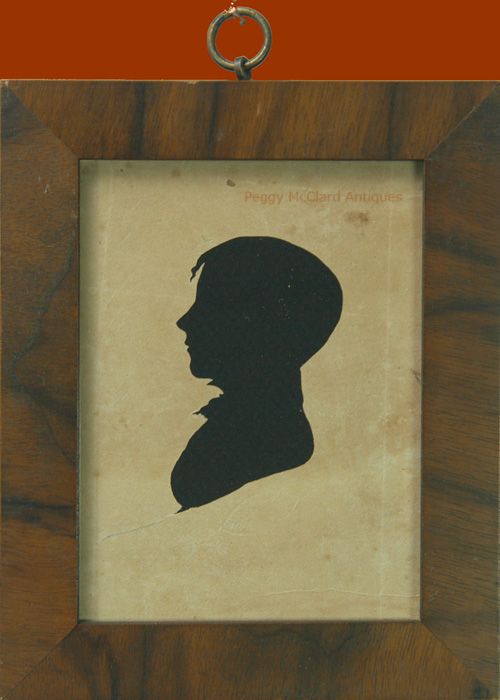
Augustus Day (active 1800 - at least 1845)
Augustus Day was a carver, gilder, portraitist and silhouettist. He advertised as a physiognotrace profilist in Charleston, South Carolina in 1804. Most of his work seems to have been done in Philadelphia where he advertised as carver and gilder (1800-1806, 1814-1821), looking glass maker (1823-1825), and painter (1829-1833). His hollow cut silhouettes are impressed with a stamped signature "DAY'S PATENT" and his painted silhouettes were hand signed "Day Fecit". His very desirable painted silhouettes were either black with soft painted hair tendrils and frilled ladies' collars painted with a soft grey-blue tone; or the more desirable olive-green and elaborately gilt embellished. His hollow cut silhouettes are more scarcely found than his painted profiles and, indeed, are some of the most rare of signed American silhouettes.
-
-
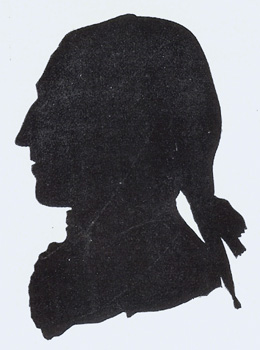
De Hart's silhouette of George Washington
Scan from Van Leer, Carrick,
Shades of Our Ancestors. Little, Brown & Company, Boston, 1928. Plate after Page 18.
Sarah De Hart, American Silhouettist (1759-1832)
Sarah De Hart was one of the first American born silhouette artists and the earliest recorded American woman silhouettist. She was born on February 13, 1759 in Elizabethtown, NJ. (Although Charles Willson Peale is not known to have started cutting silhouettes until 1802, he was born 18 years earlier than De Hart, in Chestertown, MD in 1741.) De Hart’s earliest discovered silhouette was cut when she was twelve years old, in 1771. Unlike the majority of American silhouettists who would come later, De Hart cut her hollow cut silhouettes without the aid of the physiognotrace devices that were so popular in the 19th century. To date, no evidence has been discovered showing that De Hart cut silhouettes for profit, but she certainly captured the heart of George Washington for whom she cut several likenesses after visiting Mount Vernon with Washington’s sister Abigail Mayo in 1786. De Hart’s work is extremely rare (possibly because she only cut silhouettes for her own pleasure and the pleasure of friends and family). A group of about 130 of her works descended through her family until 1946 when the collection was sold to a collector. The collection was ultimately disbursed through auction in 1997.
-
-
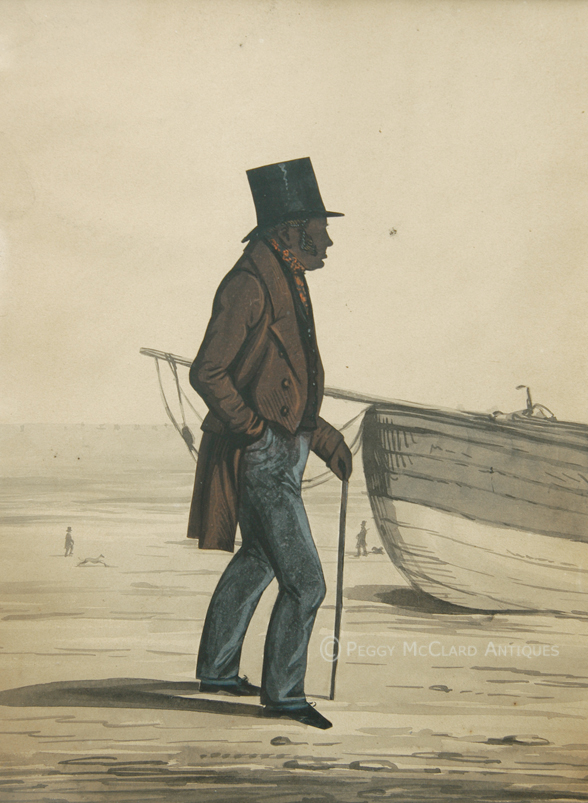
John Dempsey (active circa 1822-1844)
Little is known of John Dempsey's life. We know, through one of his advertisements, that he worked as an itinerant silhouettist beginning in the 1820s and that by 1840, he had cut silhouettes in England, Ireland and Scotland. He advertised that he took "Likenesses in Shade 3d./Bronzed 6d./Coloured Is. 6d and upwards. . . . ." He is best known for his full-length colored silhouettes, such as this one offered, in which his skill as an artist shines. McKechnie tells us "Dempsey's work in this field is so cleverly cut and pasted down that it is sometimes almost impossible to see the cut edge. The edge is concealed not by painting, but simply by skilled craftsmanship." McKechnie, Sue, British Silhouette Artists and their Work: 1760-1860. Sotheby Park Bernet, 1978 at 202. Indeed, this lady looks fully painted. The edges of the pasted paper are so skillfully painted that you almost need to remove the silhouette from the frame so that you can feel the raised edge. Dempsey kept a sample book showing his silhouette-making techniques. This was not a duplicate book, like Edouart, Bache or Chamberlain kept, but a book from which customers could pick the style of silhouette they preferred. The book included India ink painted bust profiles as well as full length painted profiles pasted to painted landscape backgrounds. Perhaps Dempsey's most important work is a large conversation silhouette titled, Liverpool Exchange showing eight-five figures upon a painted background showing the Exchange Buildings of Liverpool. Edouart apparently felt somewhat threatened by Dempsey's beautiful work. Edouart wrote that the use of color in silhouettes was "harlequinades" and he could not "understand how persons can have so bad and I may say, a childish taste!" August Edouart, A Treatise on Silhouette Likenesses, London, 1835. 24. It is generally understood among silhouette scholars that Edouart was referring to Dempsey's work. Edouart was always quick to lash out at those he felt most threatened by. Obviously, he felt threatened by Dempsey's beautiful work.
-
-
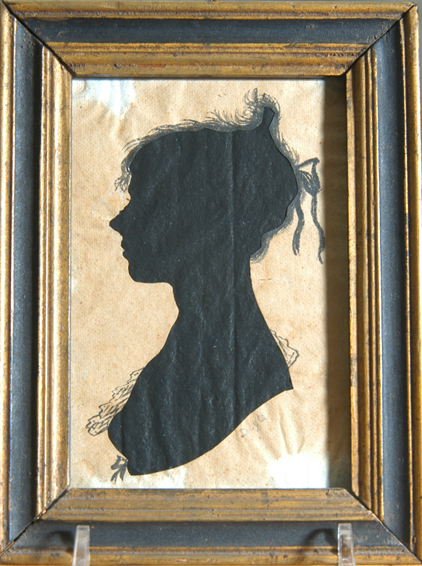
William M.S. Doyle, American Silhouettist (1769-1828)
William Massey Stroud Doyle was born in Boston, Massachusetts in 1769. His father was a British soldier, but Doyle seems to have lived and worked his entire life in Boston. Doyle was a silhouettist, artist of portraits of both full-size and miniature. He worked in silhouette cutting, watercolor, oil and pastel. His silhouettes were beautifully rendered in hollow cut or paint (sometimes painted on plaster in the manner of Miers).
Doyle did not confine himself to his artistic endeavors. Indeed from 1806 until his death in 1828, Doyle, in partnership with Daniel Bowen, was one of the owners of the Columbian Museum. Together, the two men built a five story building in 1806 to house the museum. The five story building in 1806 towered over the surrounding landscape like a skyscraper! Unfortunately, the building burned to the ground in 1807, and the two men built a smaller building which they used for the museum until 1825.
In 1811, Doyle placed the following advertisement:
Wm. M.S. Doyle
Miniature and Profile Painter
TREMONT STREET, BOSTON, next House north of the Stone-Chapel, the late residence of R.G. AMORY esq. Continues to execute Likenesses in Miniature and Profiles of various sizes (the latter in shade or natural colors) in a style peculiarly striking and elegant, whereby the most forcible animation is obtained.
Some are finished on composition in the manner of the celebrated Miers of London.
Prices of Profiles—from 25 cents to 1, 2, & 5 dollars.
Miniatures—12, 15, 18 and 20 dollars.
Doyle’s silhouettes certainly live up to his salesmanship in that they are “peculiarly striking and elegant” and “the most forcible animation” truly is obtained. Rarely do they real ones come onto the market (although it is quite common to find 20th century fakes). What few there were (for Doyle did more portrait painting that silhouette cutting or painting) have all been snapped up into private collections and museums.
Please view the Doyle silhouettes currently in stock on the Silhouettes page.
-
-
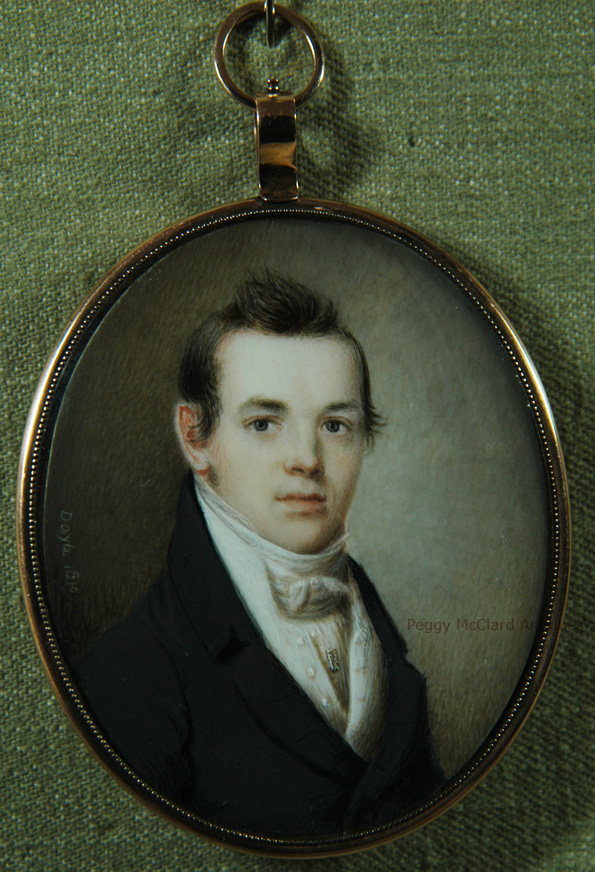
William M.S. Doyle, American Silhouettist (1769-1828)
William M.S. Doyle was born in Boston, Massachusetts in 1769. His father was a British soldier, but Doyle seems to have lived and worked his entire life in Boston. Doyle was a silhouettist, artist of portraits of both full-size and miniature. He worked in silhouette cutting, watercolor, oil and pastel. His silhouettes were beautifully rendered in hollow cut or paint (sometimes painted on plaster in the manner of Miers).
Doyle did not confine himself to his artistic endeavors. Indeed from 1806 until his death in 1828, Doyle, in partnership with Daniel Bowen, was one of the owners of the Columbian Museum. Together, the two men built a five story building in 1806 to house the museum. The five story building in 1806 towered over the surrounding landscape like a skyscraper! Unfortunately, the building burned to the ground in 1807, and the two men built a smaller building which they used for the museum until 1825.
In 1811, Doyle placed the following advertisement:
Wm. M.S. Doyle
Miniature and Profile Painter
TREMONT STREET, BOSTON, next House north of the Stone-Chapel, the late residence of R.G. AMORY esq. Continues to execute Likenesses in Miniature and Profiles of various sizes (the latter in shade or natural colors) in a style peculiarly striking and elegant, whereby the most forcible animation is obtained.
Some are finished on composition in the manner of the celebrated Meirs of London.
Prices of Profiles—from 25 cents to 1, 2, & 5 dollars.
Miniatures—12, 15, 18 and 20 dollars.
Doyle’s silhouettes certainly live up to his salesmanship in that they are “peculiarly striking and elegant” and “the most forcible animation” truly is obtained. Rarely do they come onto the market. What few there were (for Doyle did more portrait painting that silhouette cutting or painting) have all been snapped up into private collections and museums.
In 1806, Henry Williams joined the business with Doyle and Bowen. Advertisements soon afterwards placed by Williams and Doyle announced “Miniature and Portrait Painters at the Museum: where profiles are correctly cut.” Doyle and Williams collaborated until at least 1815. Doyle became the sole proprietor of the Columbian Museum in 1808 and continued until his death.
Doyle’s style in portrait miniatures varied considerably over time. It is said that Doyle greatly benefited from working with Williams on his painting skills. Fortunately, Doyle signed and dated many of his miniatures so that they can be identified despite his varied styles. His early work is characterized by strong use of line to draw the hair and facial features and distinctive diagonal striations in the background. Doyle’s later work shows paint applied in broad washes and shadows and folds emphasized with gum arabic. His subjects, usually male, are placed left of the center, facing right.
References:
Falk, Peter Hastings (ed.), Who Was Who in American Art 1564-1975. Sound View Press, 1999. 955.
Foskett, Daphne, Miniatures Dictionary and Guide. Antique Collectors Club, Suffolk, England, 1987. 531.
Johnson, Dale, American Portrait Miniatures In The Manney Collection. Harry N. Abrams, Inc., New York, 1990. 114 & Plates 76, 77.
Strickler, Susan E., American Portrait Miniatures The Worcestor Art Museum Collection. Worcester Art Museum, Worcester, Massachusetts, 1989. 52-54.
-
-

Charles Allen DuVal (1808-1872)
Charles Allen DuVal was born in Ireland in 1808 (see below for an update on his date and place of birth). He took up painting after a jaunt at sea. Around 1833, Duval moved to Manchester, England where he developed a large following for his paintings. In Miniatures Dictionary and Guide, Daphne Foskett called him a “witty writer” and I found evidence that Duval contributed articles for North of England Magazine and authored pamphlets about the American Revolutionary War. He exhibited at the Royal Academy from 1836-1872 and also in Manchester and Liverpool. Duval had a large audience for his paintings in London where he also worked and was said to be “a good artist.” He painted portraits, figure subjects, and portrait miniatures. He was an engraver and lithographer.
In 1865, Duval lent a miniature portrait to the South Kensington Museum for exhibit. The catalogue for that exhibit incorrectly recorded his name as Du Val – a mistake that is often repeated.
Duval’s work currently resides in the collections of the British Museum and the National Portrait Gallery in London.
Note--I received an email from DuVal's great-great-granddaughter who says she has a copy of a document in DuVal's own handwriting in which he gives his date of birth as 19th March 1810. She also tells me that although his parents were Irish and DuVal spent his early years in Ireland, in the censuses he gave his place of birth as Beaumaris, Anglesey, Wales. He resided in Manchester, England starting in his early twenties. Thanks so much to his descendent for the information!
See website Charles Allen Du Val His Life and Works for more information.
-
-

Emily Eastman (1804 -?) (active 1820s & 1830s)
Emily Eastman’s work represents the best of early 19th century American folk art. She worked in watercolors and graphite on paper or Bristol board. Her paintings are delightfully naïve, mostly representing stylishly dressed young women with carefully delineated details such as jewelry, lace, hair curls and hair adornments. It has long been thought that Eastman’s work was based on fashion plates of the time period, although no specific prints have been identified as the foundation for her work. Like so many folk artists of the period, Eastman rarely signed her work. Her paintings are attributed based on her use of pencil or thin watercolor to draw the outlines of her subjects which she then filled with washes of rich color. Precise lines form delicately and highly arched eyebrows, small bowed mouths, the outline of noses and tight hair curls. Eastman used sophisticated poses with bodies and heads slightly turned for an elegant effect. Her work is stylized, simple, highly decorative and shows a repetitive use of poses, formats, styles of dress, hair and facial features: all hallmarks of American folk art in which these repetitive or formulistic portraits were desirable and represented the sitters' social and economic standing. The ladies portrayed are, by all appearances, wealthy and would have had a strong social standing in their communities. There is one known portrait of a child attributed to Eastman. All other known pieces are of young women.
Emily Eastman was born in 1804 in Louden, New Hampshire. She married Dr. Daniel Baker in 1824. She was actively painting during the 1820s and 1830s. Virtually nothing else is currently known about her life.
Eastman’s work is included in collections of great museums across the country.
Emily Eastman Works in the Following Museum Collections (click the link for online images and/or information):
American Folk Art Museum:
Woman in Veil This portrait was a promised gift of Ralph Esermian. Because of his legal difficulties, I’m not sure whether the painting is still part of the museum collection, but an image is available at the link.
Boston Museum of Fine Arts:
Lady’s Coiffure with Flowers and Jewels
Lady’s Coiffure with Spray of Wheat and Wild Flowers
Young Girl Bedecked with Flowers
National Gallery of Art:
Curls and Ruffles (no online image available)
Smithsonian American Art Museum:
Woman with Roses in Hair (no online image)
Terra Foundation for American Art:
Young Woman with Flowers in her Hair
Please view the Eastman portrait currently in inventory on the Portraits pages
-
-
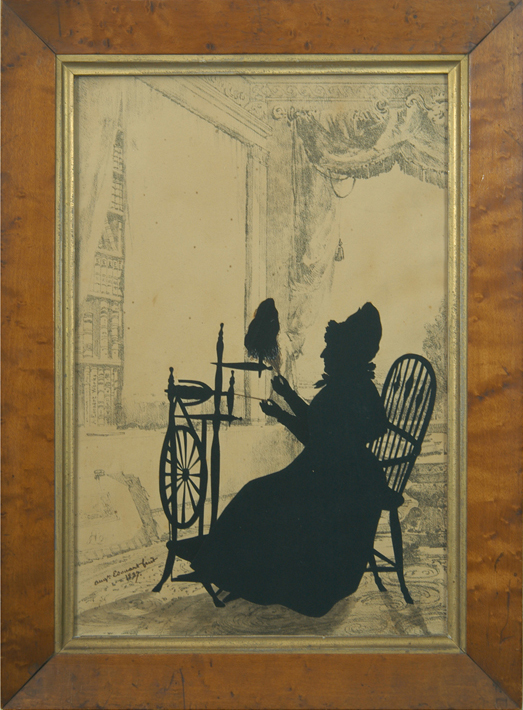
Augustin-Amant-Constan-Fidèle Edouart (1789-1861)
Edouart, born in the French harbour-town of Dunkerque, was a decorated member of Napoleon’s army. After the war, he was forced to move to England when he lost most of his property during the Evacuation of Holland. Like many French émigrés of that day, Edouart first tried to make a living teaching French. Finding too many rivals to excel as a teacher, this gifted artist turned his attention to hair art. Edouart made the intricate hair pictures that we are familiar with as mourning art, the plaited and floral ornaments which are commonly seen, and also wax portraits in which he embedded the natural hair to give a natural appearance. He excelled in the field of hair art in the same way as he would later exceed in silhouette cutting.
Edouart began silhouette cutting as the result of a heated argument with a friend who wished to commission a silhouette by an artist who used a mechanical contraption to cut profiles. In an effort to show that mechanics were inferior, Edouart sat the gentleman down, seized a pair of scissors from a nearby desk, blackened a quickly torn piece of paper with candle snuffers and snipped a silhouette of superior quality to that which the family had planned to commission. Edouart is said to have cut perfectly executed silhouettes in less than 2 minutes.
Edouart spent 24 years cutting what has been estimated as more than one hundred thousand silhouettes. He have believed that Edouart coined the term “silhouettist” because he was insulted by the then-common term “black-shade man.” By 1826, Edouart was cutting silhouettes exclusively of his hair work. He cut two original profiles of every sitting and kept one of each of the originals, named and dated, in his many folios. In 1835, Edouart wrote and published a book, A Treatise on Silhouette Likenesses.
Edouart traveled throughout England, continuously cutting silhouettes before first coming to America in 1839. He stayed in this country for ten years, cutting and cataloging silhouettes of the most important Americans of the time. Edouart cut silhouettes of six Presidents and ex-Presidents, Henry Wadsworth Longfellow, Supreme Court Chief Justice Joseph Story, and Madame Jumel who became the model for Charles Dickens’ mad Mrs. Havisham in Great Expectations to name a few.
In 1849, Edouart set out to return to England on the ill-fated ship, Oneida, which wrecked off the island of Guernsey. Although all of the passengers and crew were saved, only fourteen of Edouart’s folios were rescued. Broken-hearted by the loss of his life’s work, Edouart abandoned his profession and returned to France where he died at the age of 72. Edouart gave the rescued folios to the Lukis family, who had cared for him during the months following the shipwreck. There the folios stayed until, in 1911, Mrs. F. Nevill Jackson advertised to buy silhouettes for research she was conducting. The Lukis family sold the precious folios to her. Mrs. Jackson meticulously cataloged each silhouette. Where the background paper was waterlogged, she carefully removed the silhouettes and placed them on new background paper. Upon removal, she was delighted to find that Edouart had written the name of the sitter and date on the back of each silhouette as well as the bottom of each page. Mrs. Jackson cut keyholes into the new background paper so that Edouart’s written description could be seen. Where possible, she also cut his written descriptions from the bottom of the original folio pages and pasted them to the bottom of the new pages.
Mrs. Jackson eventually sold the six folios with American silhouettes to Arthur Vernay of New York. Mr. Vernay sold the majority of the American duplicates at a 3-week sale in 1913. One remaining unbroken American folio was kept by Mr. Vernay and made the subject of Auguste Edouart's Silhouettes of Eminent Americans, 1839-1844, by Andrew Oliver. Eight hundred sixty-two individual American duplicates were eventually sold to renown silhouette collector Reverend Glenn Tilley Morse.
Edouart is known for his simple and lifelike full-bodied silhouettes which are ripe with action. He used no colored embellishment, denouncing gilding, coral necklaces, and colored dresses as harlequinades. Although Edouart pronounced that “the representation of a shade can only be executed by an outline,” beginning in 1842, he sometimes penciled or chalked indications of hair, the lines of a coat, buttons and fingers. His ultimate surrender to the use of some embellishment was probably a nod to the overtaking of his profession by the daguerreotypists. However, he always refused to use bronzing or any other color in the embellishment of his figures.
Edouart cut and assembled compositions of entire families, often backing them with stock lithographs of room or outdoor settings. Less common are his watercolor backgrounds in sepia tones. What is expected and delightfully delivered in the Edouart silhouettes are accessories such as hats, canes, letters--even family pets. His silhouette of Mrs. Mary Appleton depicts her cutting a silhouette herself. The tiny additional profile is said to be remarkably recognizable as Mrs. Appleton’s husband.
A new and exciting discovery recently surfaced from a Parisian bookseller: Edouart’s personal folio of “Scraps” in a book labeled “Animaux”. This is the most Edouart exciting discovery in a century! Mrs. Jackson discovered the duplicate folios in the first decade of the 20th century. It appears that Edouart took this scrapbook with him to Calais. It was filled with figures of dogs, horses, toys, mythical characters, floral sprays, and on and on. It looks like Edouart used the book to keep practice figures of unusual forms that he might have been commissioned to add to conversation silhouettes as well as figures that he cut for his own amusement and for his traveling exhibition. Animaux was a treasure trove of incredible pieces. I have been so lucky to acquire more than 200 figures removed from this book. In the coming months, I will be offering these mind-boggling silhouettes for sale. They will always be lightly mounted on acid-free materials and framed in period frames. The reverse of the mountings will always be stamped with a specially made stamp for items from this book and also with my collection stamp. The reason for my insistence on mounting and stamping is because these figures are so unusual (although distinctly from Edouart’s hand) that I want to help future generations authenticate them because they can be traced back to me.
The most complete information about Edouart can be found in the following reference books:
Jackson, E. Nevill, Silhouettes: A History and Dictionary of Artists, Peter Smith Publisher, Incorporated, 1979. Plate 14.
McKechnie, Sue, British Silhouette Artists and their Work: 1760-1860, P. Wilson for Sotheby Parke Bernet, 1978 at plate 360, page 299.
I usually have a copy of both offered for sale on my Books
page.I am very pleased to be able to show you an Edouart silhouette, complete with watercolor, graphite and ink background as commissioned by the James R. Westcott family of Saratoga Springs alongside Edouart's duplicate silhouette of the Westcott family as taken from the rescued folios. You will notice that the commissioned silhouette (to the immediate left) includes (from left to right) daughter Marie, wife Mary, son James Gardner Westcott, and father James Randell Wescott. The duplicate (to the immediate right) includes Marie and Louisa (or Louise) P. Westcott, wife Mary and James R. Wescott. Remember that when Mrs. Jackson bought the rescued folios from the Lukis family, many of the silhouettes were missing from the pages as a result of their trip to the bottom of the bay. Apparently, James Gardner Westcott was one of the missing folio silhouettes. The commissioned silhouette of the Westcott family is dated 1840 and Marie, Mary and James R. are dated 1841 in the folio. I have absolutely no explanation for why the dates are different on the commissioned silhouette and the folio silhouettes. Louisa is dated 1843 in the folio and only she bears the faint chalk line embellishment that Edouart used starting in 1842. I surmise that Louisa was a member of James Randell Westcott's extended family who had her silhouette cut later. Edouart often went back in the folio to add a later-cut family member or add a notation about a death or marriage of a sitter. It would not have been unusual for him to have added Louisa to the Westcott family page later. We know she was placed on the same folio page as Marie before Mrs. Jackson restored the silhouettes because their names are written together on the inscription that Mrs. Jackson cut from the damaged folio page and pasted to the bottom of the later paper. Many thanks to the Musée national des beaux-arts du Québec for granting permission to display a photo of the commissioned silhouette for this website.
Please view the Edouart silhouettes currently in stock on the Silhouettes page.
-
-
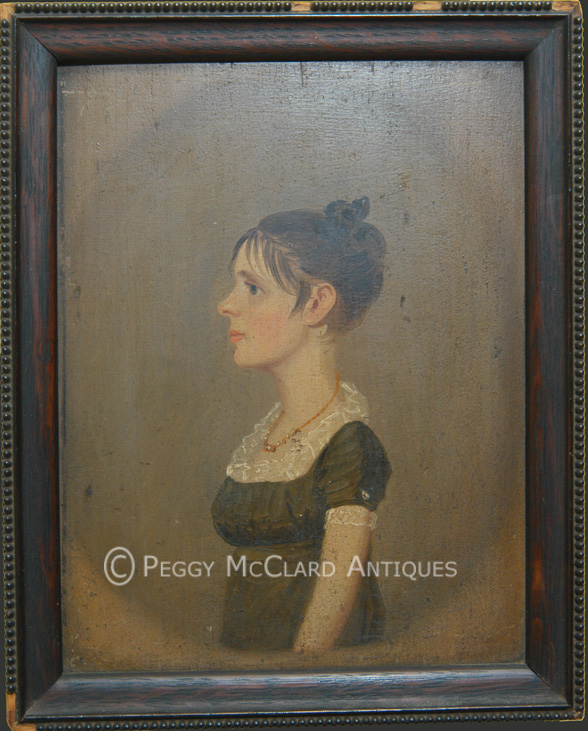
Jacob Eichholtz (1776-1842)
Jacob Eichholtz was born in Lancaster, Pennsylvania November 2, 1776. He started his professional life as a coppersmith. He took painting lessons from Thomas Sully at least as early as 1808, but he was unable to devote himself to art until 1811. In 1812, he studied under Gilbert Stuart in Boston. Eichholtz was a regular exhibitor at the Society of Artists and the Pennsylvania Academy. Although he made occasional visits to Baltimore and Washington, Eichholtz lived and worked primarily in Lancaster and Philadelphia.
Eichholtz was recently the subject of an exhibition held concurrently at three institutions: the Lancaster County Historical Society (project headquarters), the Heritage Center Museum of Lancaster County (now the Lancaster Cultural History Museum), and the Phillips Museum of Art at Franklin & Marshall College. A catalog of that exhibition was written by Thomas R. Ryan.
Eichholtz' wood panel portraits tended to be small, painted inside a faux oval and painted in profile. His canvas portraits tended to be larger, painted more academically with sitters facing the viewer. The small, wood panel portraits are favored by collectors of folk art who like the naïveté which he tends to exhibit less in his larger portraits. Only one Eichholtz-signed wood panel portrait is known to exist. All other known Eichholtz wood panel profile portraits are attributed on the basis of that one signed profile. Each sitter in Eichholtz' wood panel portraits is painted in profile, half length and without hands showing. His earliest wood panel profiles have a somber shaded background within an oval surround. By 1810, Eichholtz had pretty much discountinued the shaded backgrounds, instead using more monochromatic backgrounds painted in browns and black. The wood panels are always close to 7" x 9". Eichholtz is known to have painted these wood panel profiles from 1801 until about 1818.
References:
Rumford, Beatrix T. (ed.) American Folk Portraits Paintings and Drawings from the Abby Aldrich Rockefeller Folk Art Center. New York Graphic Society, 1981. 91-92.
Ryan, Thomas R. (ed.) The Worlds of Jacob Eichholtz, Portrait Painter of the Early Republic, Lancaster Country Historical Society, 2003.
-
-
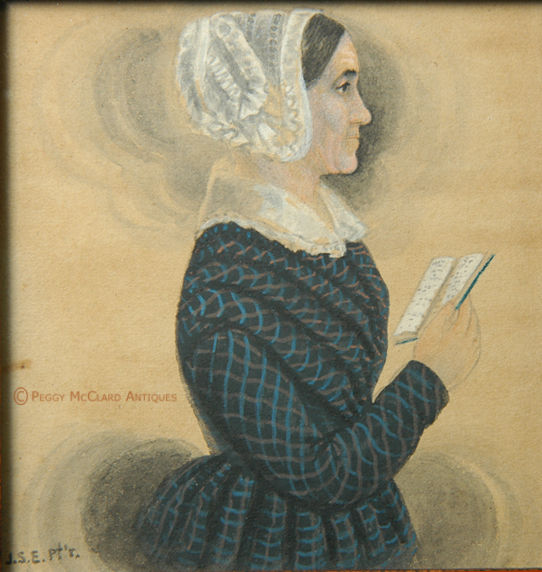
James Sanford Ellsworth (1802/03 - 1874)
James Ellsworth was born to John and Huldah Ellsworth somewhere in Connecticut in either 1802 or 1803. On May 23, 1830, Ellsworth married Mary Ann Driggs in Harford, Connecticut. The couple had a son (rather scandalously it must be presumed), William Leyard Ellsworth, on November 15, 1829. In 1831, James and Mary had a second son, Edward Ellsworth. In 1839, Mary Ann Driggs Ellsworth obtained a divorce from the painter, claiming James deserted the family in 1833.
James Ellsworth painted miniature watercolor folk portraits from about 1835 to 1855. He worked primarily in Connecticut and Massachusetts but is also known to have traveled to Pennsylvania and Ohio (where he complained to have been shot at by a mob who suspected him of being a Confederate). As of 1980, there were 263 known miniatures by Ellsworth and eight oil portraits. He is known for his remarkable talent for portraying the character of his sitters in their portraits. Faces are skillfully modeled. The color of eyes and shape of brows are expertly rendered. Likenesses are presumably very accurate as they are uncompromising so as to depict some of his sitters as plain, homely and even toothless. Hairstyles and dress document the actual country fashions of the period and places where he worked. Ellsworth had a problem depicting hands and so often hid them entirely or showed the hands folded or holding an object. Books, flowers, fans, handkerchiefs, birds are all props that can be found in his works. All but seven known Ellsworth miniatures are painted in profile. He depicted his figures with more negative space left behind the figure than in front.
Ellsworth's backgrounds produce a most clever device that one has come to expect from an Ellsworth miniature. His sitters are placed in front of cloverleaf clouds which wisp behind their heads and seem to support them in air. "His scalloped clouds support almost all of the sitters so that, though only some are chairborne, almost all are airborne." See Lipman at 71. The clouds give an illusion of depth. Men usually emerge from the support clouds at their waist while women rise from their hips. Some of his figures are seated in one of six basic patterns of chairs. The chairs are whimsical, unreal and never completely shown. They are all upholstered and have natural, stained or painted wood chairs. Ellsworth may have seen these chairs as his trademark because the majority of the portraits with chairs are left unsigned.
The usual size for his miniatures was 2 7/8" x 2 1/2" and painted on thin paper mounted to a heavier stock. He also did some larger miniatures, about 3 1/2" x 4 1/2". He painted a few miniatures on embossed paper or envelopes used for Valentines. He often framed his miniatures in a narrow, half-inch mahagoney veneer, fitted with blown glass, secured at the back with glazier's points and hung with a wire ring at the top of the frame. Ellsworth is known to have used 13 different whimsical signatures, including: "ELLSWORTH PAINTER"; " J.S. Ellsworth, Painter"; "J.S.E. Ptr."; "J.S.E. Pr."; "J.S. Ellsworth, Portrait Painter"; "Ja. S. Ellsworth, Portrait Painter"; "James S. Ellsworth, Painter"; "James S. Ellsworth, portrait painter" with a flourish beneath; "J.S. Ellsworth, px."; "J.S. Ellsworth, pinx"; "James Sanford Ellsworth", "Sanford Ellsworth", and "J.S. Ellsworth, del.".
Exhibits: "The Paintings of James Sanford Ellsworth, Itinerant Folk Artist 1802-1873", Abby Aldrich Rockefeller Folk Art Collection, October 13 - December 1, 1974.
References:
Lipman, Jean & Armstrong, Tom, eds., American Folk Painters of Three Centuries. Whitney Museum of American Art, New York, NY, 1980. 70-73.
Mitchell, Lucy B., The Paintings of James S. Ellsworth, Itinerant Folk Artist 1802-1873, Exhibition Catalog. The Colonial Williamsburg Foundation 1974.
Rumford, Beatrix T. (ed.) American Folk Portraits Paintings and Drawings from the Abby Aldrich Rockefeller Folk Art Center. New York Graphic Society, 1981. 92-93.
-
-

John Field (1772-1848)
Much of his career was spent working for John Miers Studio. Please see the entry for Miers below.
Please view the Field silhouettes currently in stock on the Silhouettes page.
-
-
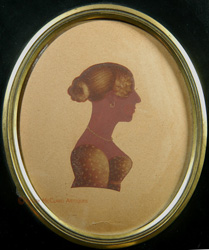
Edward Foster (1762-1864)
Edward Foster was born November 8, 1762, two years into the reign of the monarch who would become his most important, George III. Foster's father was a gentleman land-steward and mother was the child of nobility. He joined the Derbyshire militia at the age of 17 and remained in the military for 25 years. Once Foster retired from the military at age 42, he turned his attention to his artistic talents where he earned a fine reputation as a painter of miniatures and profiles. King George III appointed Foster the "Official Miniature Painter to the Royal Family" and moved him into lavish apartments in the Round Tower of Windsor Palace. Foster set up his business as a professional silhouettist in London around 1811 on The Strand. It was around the year 1811 that Foster began using papier mâché frames with a special brass hanger bearing his name above the Royal crown, meaning his appointment as Offical Miniature Painter must have been made by at least this date. In addition to working from his studio, Foster traveled as an itinerant artist. It appears that Foster returned to Derby in about 1832, during which year he was seventy-two years old. Never one to rest on his laurels, Foster began drawing and printing educational maps and charts for school use. He was married five times and had at least 17 children, only one of whom survived his death at 102 years old in 1864.
Foster's silhouette profiles were fully painted (not cut). His work is generally categorized as two types: "black profiles" with which he appears to have launched his career and later "red profiles." For his black profiles, he used thin black paint with detail added with pigment added to gum arabic and, sometimes, Chinese white. His "red profiles" are created with Venetian red and reddish-brown to which he added touches of gold and Chinese white. He used a three-dot technique to depict the transparency of the fabrics of women's dresses. Neck and shirt frills were generally left without color.
Peter Seddon, Derbyshire Life Magazine, July 2009 at 170-173.
Also see a great article about Edward Foster by Brett Payne at Photo Sleuth-blog
-
-
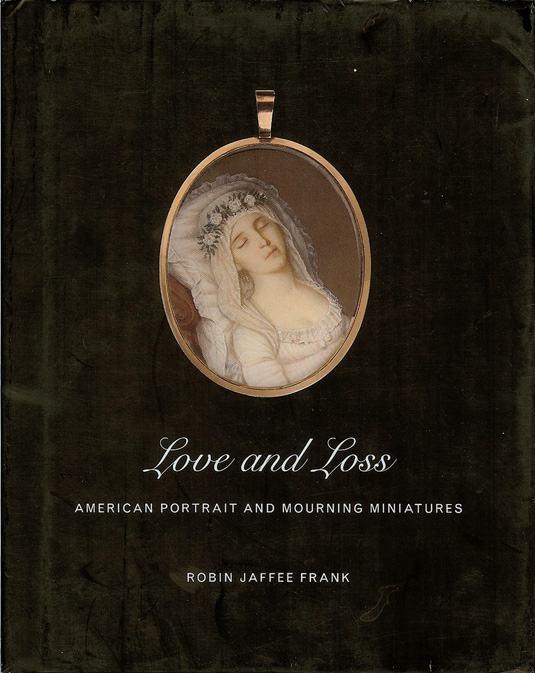
Love and Loss: American Portrait and Mourning Miniatures
I've read this book cover to cover, several times. I find it fascinating and thorough in its information about portrait miniatures and mourning miniatures in America. The book is only 7" x 5" in outside dimensions but is packed with 376 pages of text and 189 illustrations (166 of them in glorious color). The text is well-written and authoritative and the color images are plentiful, beautiful and of great use for comparisons. This is a wonderful reference book and a fun read. Excellent copy with with just a bit of bumps to the dust cover (you can really barely see). Like new condition.
(#5231) $50
-
-
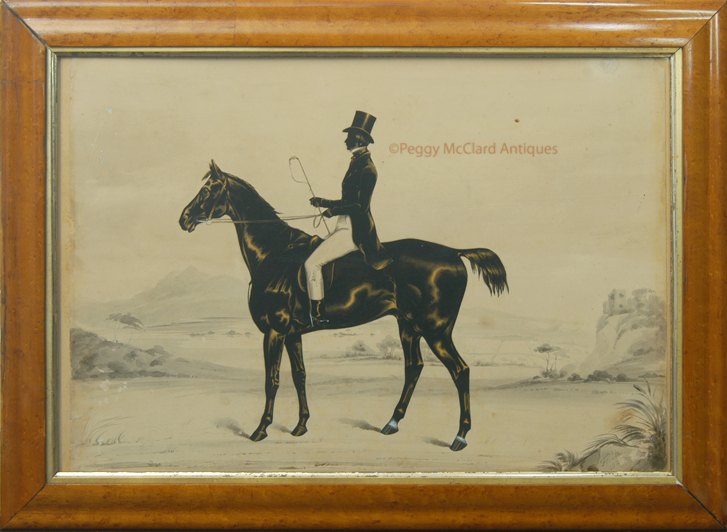
F. & H.A. Frith (after 1837-1854)
These brothers worked for much of their career as the Royal Victoria Gallery. Please see Royal Victoria Gallery below for information about the Frith Brothers.
Please view the Frith silhouette currently in stock on the Silhouettes page.
-
-
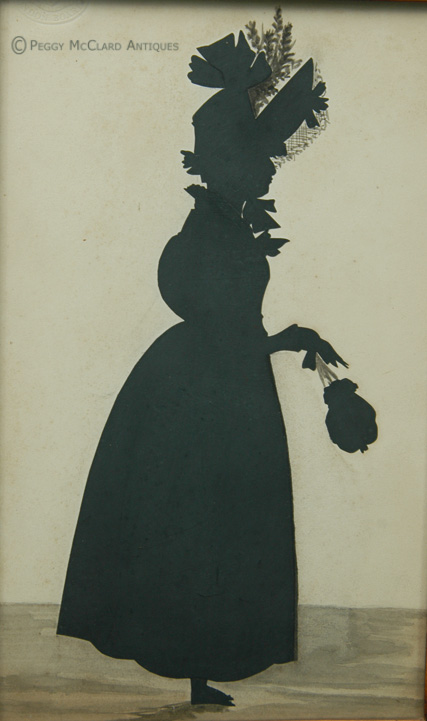
John Gapp (active 1823-1839)
The Royal Suspension Pier (aka The Royal Chain Pier) was the first major pier built in Brighton, England. When built in 1823, it was intended as a landing stage for incoming ships. But Brighton provided a variety of amusements to draw tourists and the spaces between the cast-iron towers from which the chains were suspended soon attached profilists to set up shop in order to provide tourists with a memento of their visit to Brighton. John Gapp set up at the Third Tower in 1828 or earlier and seemed to have an ongoing rivalry with another silhouettist, Edward Haines, who had a similar style and had a gallery in the First Tower.
Gapp’s trade labels announce that he produced “likenesses from the scissors only” and that he captured “the expression and peculiarity of character are brought into action in a very superior style.” By 1830, Gapp’s trade label proclaimed “that he has no connexion with any other Person”. This is the first notice of his rivalry with Haines. Gapp’s price list is given as follows:
- Full-length Likeness 2s 6d. each
- Two Full-length Likenesses 4s. 0d. for two
- Likeness in Bronze 4s. 0d.
- Profile to the Bust 1s. 0d.
- Two of the same as above 1s. 6d.
- Ladies and Gentlemen on Horseback 7s. 6d.
- Single Horses 5s. 0d
- Dogs 1s. 6d.
Gapp's naïve cut & paste silhouettes are almost always full length and his subjects almost always have something in their hands. He seemed to have trouble depicting two legs without having the legs look too thick, so, early in his career, he started perching his sitters on what appeared to be one leg with two feet. The cut details of his clothing has been called "spikey" because of the very definitive corners that he cut. His figures are mounted on card with either a simple watercolor wash ground or no background at all. He seldom embellished his work.
-
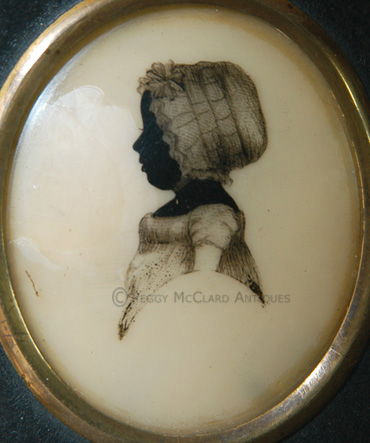
Hinton Gibbs (active late 1790s - c. 1822)
Hinton Gibbs (incorrectly recorded by Jackson as "Hintor Gibbs") spent most of his profilist career in the militia. His army career appears to have started as a drummer in 1793 while he was probably a teenager. Gibbs appears to have reached the rank of corporal, apparently leaving the army shortly before the Battle of Waterloo. At least four if Gibbs' known trade labels appear to have been used during his military career. After leaving the army, Gibbs seems to have worked in London.
Gibbs painted silhouettes on the reverse of convex glass using two different methods. One style was almost entirely in solid black while the other was done with the finest detail leaving a transparent look to the black paint. He produced incredible detail by scratching the surface of the finger-painted black base with a needle and appears to have rendered detail outside the basic profile with a fine brush. Gibbs appears to have saved this highly detailed style for the profiles of women and children. The accuracy of Gibbs' depiction of women's clothing has given us great insight into the styles of the period.
Generally, Gibbs backed his work with wax. Most of the wax has become damaged or has been removed. Gibbs painted his early work on thick glass and framed them in oval turned wood frames. He painted his later works on convex glass of normal thickness and set them in papier mâché frames.
Please view the Hinton Gibbs silhouette currently in stock on the Silhouettes page.
-
-

Style3J.H. Gillespie, Profile Artist (1793-after 1849)
James H. Gillespie started his career as a painter of miniature portraits and silhouettes in England as early as 1810, although the earliest known dated example of his work was done in 1816. He crossed the globe to enter Nova Scotia in the 1820s. From Canada, he migrated into the United States where he is known to have worked in Baltimore, Philadelphia, New York, and Maine. His advertisements tell us that he charged 25 cents for plain black profiles, 50 cents for profiles shaded in black, 1 dollar to finish the silhouettes in bronze and 2 dollars for “Features neatly painted in colours.” The outlines for his silhouettes and portraits were achieved by means of “several mechanical and optical instruments.” His demand was so great that, to save time that the sitter needed be present, he took outlines of the sitters in the morning and completed the rest of the portrait later that same day. The demand for Gillespie's work also allowed him to increase the price of his color portraits from $2 to $4 by the time he hit Baltimore in 1837. By 1842, Gillespie's U.S. tour was finished and he was working in Toronto, where he stayed until at least 1849.
Gillespie painted miniature portraits and silhouettes with a practiced and careful hand. The features are crisply delineated and his painting style is similar to the work of an artist who painted portraits on ivory. I am, however, unaware of any portraits on ivory that have been attributed to him. His silhouettes are generally found painted in shades of dark grey with black pigment added to show clothing details. His use of gum Arabic to heighten detail is masterful and subtle. Several monotone portraits backed by dark grey painted background have been found and are quite distinctive.
As a result of their recent research into the life and work of Gillespie, Suzanne and Michael Payne note that Gillespie worked in six distinctive styles:
Style 1: Simple silhouette--profile head and neck painted in grey-black with gum arabic highlights of the ear, eye, and the hair. Not watercolor detail added. The Paynes tell us this was his 25-cent portrait.
Style 2: Silhouette face with painted body--profile face painted grey-black with body carefully outlined and then painted in dark colors. No gum arabic detailing the face or hair, but painted hair strands added. Eyelashes are drawn with delicate brushstrokes. Neck between face and body is outlined, with details added. Extensive use of gum arabic to highlight the clothing. According to the Paynes, this was his 50-cent profile.
Style 3: White face on black background--profiled face shows the features carefully modeled using pencil, ink, and grey wash watercolor details. The painted grey-black (carefully painted with no brushstrokes) provides contrast. Sitter's clothing is depiected in a grey-black that is either slightly lighter or darker than the background. Thick gum arabic highlights the clothing with a very think line of gum arabic defining the bust. This monochromatic style appear to be the portrait that Gillespie advertised as "in imitation of Copper-Plate busts." These portraits sold for 5 shillings while he was working in England. My own notation to the Paynes' descriptions of this style is that I have seen several on which the background and features are painted a brownish-copper color that closely seems to imitate the sepia tones of many copper plate prints of the period. To the left you can see an example with the grey-black and one with the brownish-copper painting.
Style 4: Silhouette with bronzed highlights--profile painted grey-black with bronze paint highlights used for hair, ear, necklace, and dress. According to the Paynes, Gillespie charged $1 for this portrait style.
Style 5: Watercolor profile portrait--profile painted with watercolor, ink and pencil used to model the features. A distinctive background shading provides what Gillespie advertised as "drapery". This background provides a good means for identifying his work. Shading around the perimeter of the portrait is achieved with large dabs of dark browns and blues concentrated on the lower right and left sides of the figure and a light blue color applied with minute brushstrokes on the top. The darker drapery catches the viewer's eye first and draws it towards the face. A few examples have only light blue coloration around the entire perimeter of teh portrait. Clothing usually painted in dark tones of black or blue, with colored buttons or jewelry and gum arabic highlights. These oval portraits have been found in lockets, wood frames, and stamped brass frames. It appears that Gillespie produced more of this style in the U.S. than the other five styles. The Paynes tell us that this is the style that Gillespie first offered for $2 and later for $4.
Style 6: Less detailed watercolor profile portrait--profile face is less modeled and simpler than style 5. The body is less elaborately drawn and there is no background shading. This style has only been found framed in a square format. This style has been found with sitters from Maine and Canada. Gillespie's price for this style is unknown.
Payne, Suzanne Rudnick and Payne, Michael R., "Six Choices for the Sitter, James H. Gillespie (1793-after 1849), Antiques & Fine Art, 200 (Summer/Autumn 2008) (online article at incollect.com).
-
-
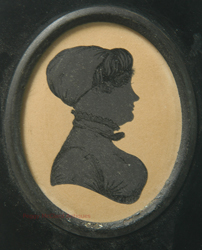
Style 1J.H. Gillespie, Profile Artist (1793-after 1849)
James H. Gillespie started his career as a painter of miniature portraits and silhouettes in England as early as 1810, although the earliest known dated example of his work was done in 1816. He crossed the globe to enter Nova Scotia in the 1820s. From Canada, he migrated into the United States where he is known to have worked in Baltimore, Philadelphia, New York, and Maine. His advertisements tell us that he charged 25 cents for plain black profiles, 50 cents for profiles shaded in black, 1 dollar to finish the silhouettes in bronze and 2 dollars for “Features neatly painted in colours.” The outlines for his silhouettes and portraits were achieved by means of “several mechanical and optical instruments.” His demand was so great that, to save time that the sitter needed be present, he took outlines of the sitters in the morning and completed the rest of the portrait later that same day. The demand for Gillespie's work also allowed him to increase the price of his color portraits from $2 to $4 by the time he hit Baltimore in 1837. By 1842, Gillespie's U.S. tour was finished and he was working in Toronto, where he stayed until at least 1849.
Gillespie painted miniature portraits and silhouettes with a practiced and careful hand. The features are crisply delineated and his painting style is similar to the work of an artist who painted portraits on ivory. I am, however, unaware of any portraits on ivory that have been attributed to him. His silhouettes are generally found painted in shades of dark grey with black pigment added to show clothing details. His use of gum Arabic to heighten detail is masterful and subtle. Several monotone portraits backed by dark grey painted background have been found and are quite distinctive.
As a result of their recent research into the life and work of Gillespie, Suzanne and Michael Payne note that Gillespie worked in six distinctive styles:
Style 1: Simple silhouette--profile head and neck painted in grey-black with gum arabic highlights of the ear, eye, and the hair. No watercolor detail added. The Paynes tell us this was his 25-cent portrait.
Style 2: Silhouette face with painted body--profile face painted grey-black with body carefully outlined and then painted in dark colors. No gum arabic detailing the face or hair, but painted hair strands added. Eyelashes are drawn with delicate brushstrokes. Neck between face and body is outlined, with details added. Extensive use of gum arabic to highlight the clothing. According to the Paynes, this was his 50-cent profile.
Style 3: White face on black background--profiled face shows the features carefully modeled using pencil, ink, and grey wash watercolor details. The painted grey-black (carefully painted with no brushstrokes) provides contrast. Sitter's clothing is depicted in a grey-black that is either slightly lighter or darker than the background. Thick gum arabic highlights the clothing with a very think line of gum arabic defining the bust. This monochromatic style appear to be the portrait that Gillespie advertised as "in imitation of Copper-Plate busts." These portraits sold for 5 shillings while he was working in England. My own notation to the Paynes' descriptions of this style is that I have seen several on which the background and features are painted a brownish-copper color that closely seems to imitate the sepia tones of many copper plate prints of the period. To the left you can see an example with the grey-black and one with the brownish-copper painting. Recently, I have acquired a portrait done in imitation of copper plate print but with a touch of color added in the young girl's red hair.
Style 4: Silhouette with bronzed highlights--profile painted grey-black with bronze paint highlights used for hair, ear, necklace, and dress. According to the Paynes, Gillespie charged $1 for this portrait style.
Style 5: Watercolor profile portrait--profile painted with watercolor, ink and pencil used to model the features. A distinctive background shading provides what Gillespie advertised as "drapery". This background provides a good means for identifying his work. Shading around the perimeter of the portrait is achieved with large dabs of dark browns and blues concentrated on the lower right and left sides of the figure and a light blue color applied with minute brushstrokes on the top. The darker drapery catches the viewer's eye first and draws it towards the face. A few examples have only light blue coloration around the entire perimeter of the portrait. Clothing usually painted in dark tones of black or blue, with colored buttons or jewelry and gum arabic highlights. These oval portraits have been found in lockets, wood frames, and stamped brass frames. It appears that Gillespie produced more of this style in the U.S. than the other five styles. The Paynes tell us that this is the style that Gillespie first offered for $2 and later for $4.
Style 6: Less detailed watercolor profile portrait--profile face is less modeled and simpler than style 5. The body is less elaborately drawn and there is no background shading. This style has only been found framed in a square format. This style has been found with sitters from Maine and Canada. Gillespie's price for this style is unknown.
Payne, Suzanne Rudnick and Payne, Michael R., "Six Choices for the Sitter, James H. Gillespie (1793-after 1849)", Antiques & Fine Art, 200 (Summer/Autumn 2008) (online article at antiquesandfineart.com).
Please view the Gillespie profile currently in stock on the Silhouettes page.
-
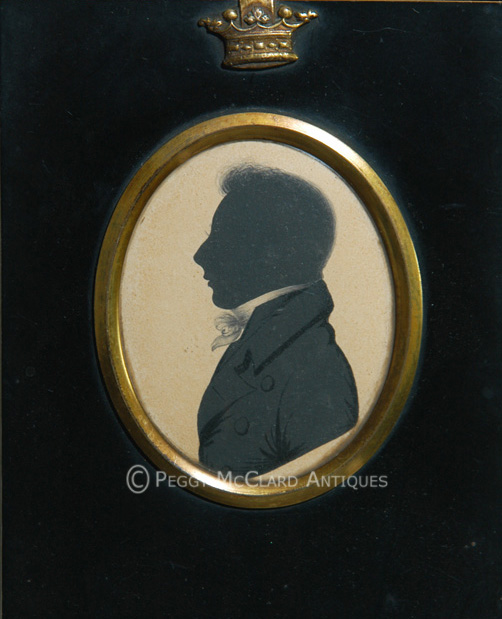 Style 2
Style 2
-
 Style 3
Style 3
-
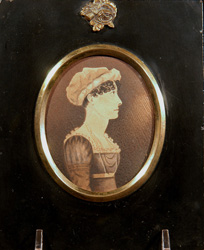 Style 4
Style 4
-
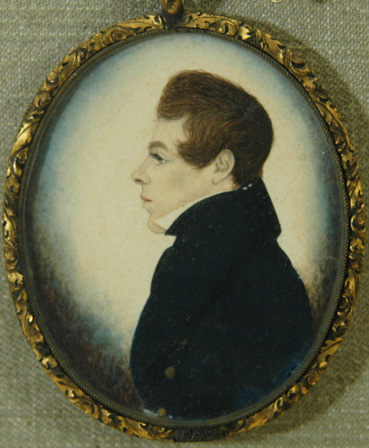 Style 5
Style 5
-
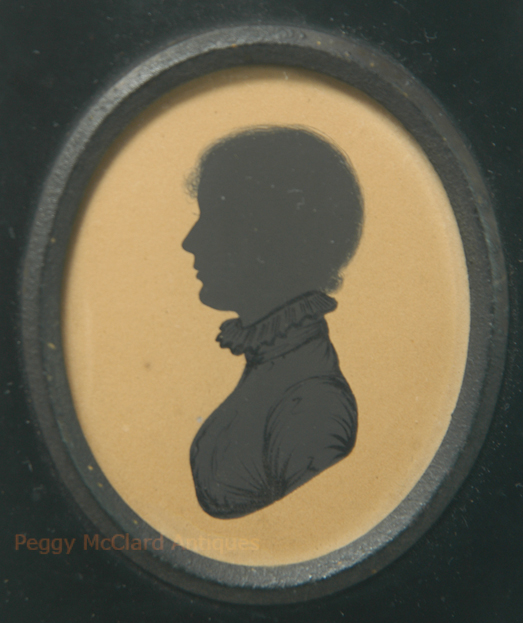
-
-
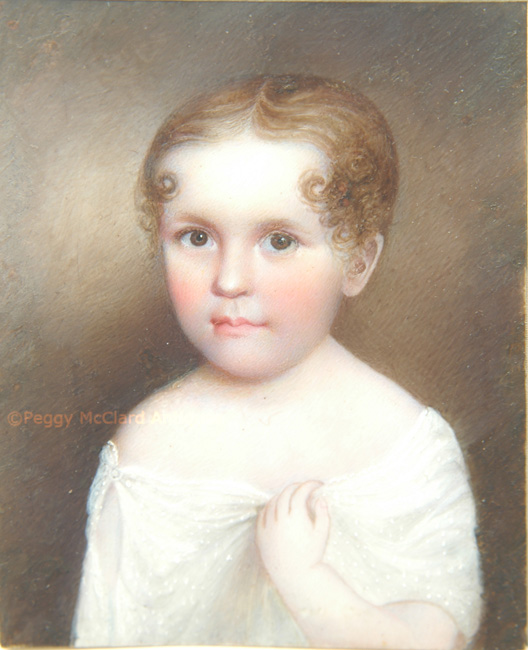
Sarah Goodridge (or Goodrich) (February 5, 1788—December 28, 1853)
Sarah Goodridge was the sixth of nine children born to Ebenezer Goodridge and Beulah Childs. She was born in Templeton, Massachusetts, growing up on a farm. She developed an interest in drawing at a young age, but having little money to buy paper, she taught herself to draw on the sanded kitchen floor with a stick or on sheets of peeled birch bark with a pin. At seventeen, Goodridge moved to Milton, MA to live in her brother’s household as his housekeeper. Sarah returned to Templeton during the summers to teach at the schools where she had been educated. Largely self-taught, Sarah began her professional career as a portraitist in Templeton in 1812. Her first professional portraits were taken in pastel (red, white and black chalk) for 50 cents and, later, in watercolor on paper for $1.50. She later moved to Boston where she lived with other family members. Sarah listed herself in the Boston directory as a miniature painter in 1818 and opened her own studio on 1820. In Boston, she was exposed to other artists and was mentored by Gilbert Stuart. Sarah visited Stuart’s studio often for critiques and to copy his oil paintings as miniatures. Stuart sat for Sarah in 1825, a portrait miniature which is included in the collection of the Metropolitan Museum of Art.
Sarah never married although she had a special relationship with Daniel Webster which lasted for many years. Webster sat for his portrait while he was married to his first wife and had three children. He sat for eleven more portraits by Goodridge over the next twenty-five years. The pair wrote each other frequently—Sarah carefully preserved his letters while he seems to have carefully destroyed the letters he received from Sarah. After Webster moved to Washington DC to serve the government, Sarah visited him twice, her only forays outside of the Boston area. After Webster’s wife died in 1827, Sarah painted her most poignant portrait for him—a stunning and sensual portrait of Sarah’s breasts surrounded by a diaphanous white fabric. The stunning Beauty Revealed shows that the boundaries of conduct were not as narrow as we believe today. At forty years old, an early 19th century woman could enjoy her sexuality and share it with her loved one. Even though Webster took another, wealthier woman as his second wife to help him preserve and promote his extravagant lifestyle and his unrealized hopes to become president, he kept Sarah’s touching self-portrait along with her paint box and easel which Sarah left to him upon her death. These items were found by Webster’s heirs after his death.
Sarah’s professional career continued until 1851 when her eyesight failed her. Her success enabled Sarah, a single womn, to support her mother for eleven years, raise an orphaned niece and purchase a home. Sarah died of a stroke in 1858. It is interesting to note that although today she is mostly known by the name Goodridge and her parents went by that name, Sarah made clear that she wanted her last name spelled “Goodrich” and always used that spelling in her directory listings. Her sister Elizabeth was also a noted portrait miniaturist.
Sarah’s signature characteristics include a background of blue diagonal hatches, the scribed (scored or scratched into the paint) highlights in the hair, heavily outlined irises of the eyes. She also used a shadow under the nose and lower lip, delicate flesh coloring in the face and a finely drawn mouth with a hint of a smile. Holton and Gilday described Sarah’s work very well in their recent article about this important artist, “Possessing a heart attuned to tenderness, Goodrich limned small miracles of illumination, transcendent reckonings of wistfulness and desire that go beyond mere biography. Her miniatures live on as silent messengers of human beauty, reanimating a vanished world.”1
Sarah's work is held by many of the finest museums of the United States including: The Metropolitan Museum of Art; Museum of Fine Arts, Boston; Smithsonian American Art Museum; Yale University Art Gallery, and others.
1. Holton, Randall L. & Gilday, Charles A., “Sarah Goodrich: Mapping places in the heart”, The Magazine Antiques online, http://www.themagazineantiques.com/articles/sarah-goodrich-mapping-places/.
-
-
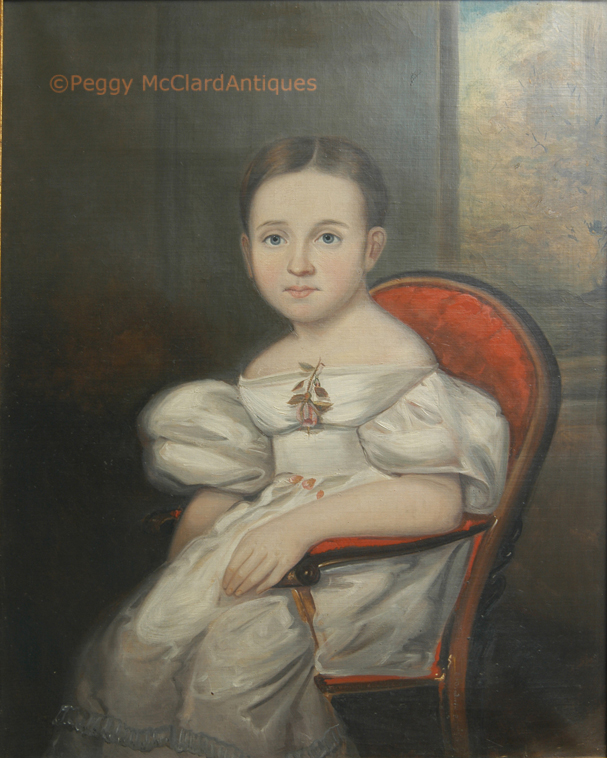
Edwin Weyburn Goodwin (1800-1845)
Edwin Weyburn Goodwin (1800-1845) was born in Ovid, New York. He first married Almira Ives and, after she died in 1837, he married his second wife, Almira LaBarre. Goodwin was mostly self-educated and became a painter in his twenties. He studied painting under Anthony Lewis DeRose in New York City and first exhibited at the National Academy of Design in 1836. Goodwin painted portraits of President Martin Van Buren, William H. Seward, DeWitt Clinton, James G. Birney, Gerrit Smith and many others. It has been said that he captured the likenesses of both ordinary citizens and prominent figures.
Goodwin was a staunch abolishionist who lectured on emancipation and temperance. His home was one of the Underground Railroad depots for fugitives on their way to freedom. He owned and edited the anti-slavery newspaper, “The Tocsin of Liberty”, in Albany. It is said that he was a bit of a workaholic and his work with his art, his church, emancipation and temperance just “wore out his life at the age of forty-five.”
His son, Richard LaBarre Goodwin (1840-1910) became an accomplished landscape, still life and trompe l’oeil painter. The paintings of both Goodwins are highly collectible and hang in many museums.
-
-
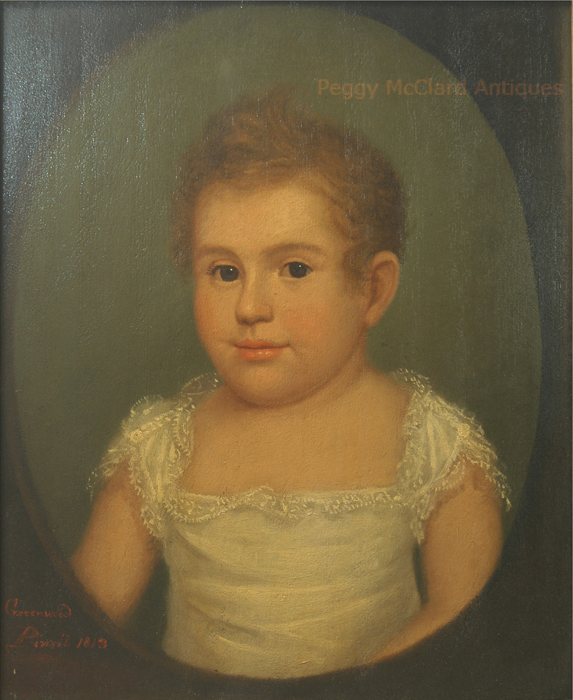
Ethan Allen Greenwood (1779–1856)
Greenwood was a lawyer, portrait painter, and entrepreneurial museum proprietor in Boston, Massachusetts in the early 19th century. He was born in Hubbardston, Mass to Moses and Betsey Dunlap Greenwood on May 27, 1779. His father was a farmer and Ethan worked on the farm until he was nineteen. In 1798, Greenwood entered the Academy at New Salem and then attended Leicester Academy. In 1806 he graduated from Dartmouth College. Greenwood studied law with Hon. Solomon Strong and was the first practicing lawyer in Westminister, Mass.
Greenwood first started painting portraits in 1801. In 1806, he studied painting under Edward Savage in New York. In 1812, Greenwood was living in Boston, working at the Linen Spinner Company, of which he was co-owner. He also taught school, all while painting. But in 1813, he turned to portrait painting as a profession, opening a studio at what is now Scollay Square, near the State House in Boston. In 1812, the New York Museum was founded at Boylston Market, Boston by Greenwood’s mentor and teacher, Edward Savage. In 1818, Greenwood opened the New England Museum on Court Street. Greenwood’s New England Museum soon absorbed the New York Museum from his mentor. Greenwood continued to buy the collections of other Boston Museums and by 1825, the New England Museum and Gallery of Fine Arts was housed in eleven large halls and apartments. Greenwood also established museum branches in Portland, Maine, and Providence, Rhode Island. However around 1834-1839 he experienced financial difficulties, and as a result "his assignees conveyed the collections [of the New England Museum] to Moses Kimball." Kimball would then found the Boston Museum and Gallery of Fine Arts, a theatre and exhibit hall, featuring a portion of Greenwood's collection; Kimball sold the other portion of Greenwood's collection to a museum effort in Lowell, Massachusetts, in 1840.
Between 1801 and 1825, Greenwood painted as many as 800 works. Like many artists of the early 19th century, Greenwood utilized the physiognotrace technique (or camera obscura) to obtain what he considered a perfect likeness. He kept a studio in Boston, circa 1813; and associated with other artists, including Gilbert Stuart. He joined the Ancient and Honorable Artillery Company in 1814. He married Caroline Carter Warren in 1829. After the death of his parents, he moved back to the farm in Hubbardston and built a large home. He became active in public and business affairs of Hubbardston.
Throughout his life, Greenwood kept a diary. On reviewing some of the diary entries, one scholar observed: "[he] each day recorded both the weather and the title of the book he was reading ... and occasionally noted the library from which the volume was borrowed—the Adelphi Fraternity Library, the Social Friends Library [of Dartmouth College], or the unnamed circulating library he joined in 1806." Greenwood’s diaries now reside in the collection of the American Antiquarian Society. Entries from 1824 capture the details of Greenwood's life as a museum director:
"June 1st, 1824. A Mermaid arrived here last week & I agreed to exhibit it. Busy setting up Shark. -- 2nd. Purchased some Indian Curiosities. -- 3rd. Bought four figures of an Italian $4.00. -- 5th. Bought four Busts of Voltaire, filling up jars of reptiles.... -- 7th. Artillery Election good run of business & in the eve a 'Glorious House' $342.75. Best day since the Museum began. -- 10th. Bought a young Shark."
Greenwood’s portraits are included in numerous museum collections, including the Worcester Art Museum and the Brooklyn Museum.
Bumgardner, Georgia Brady, "The Early Career of Ethan Allen Greenwood", Itinerancy in New England and New York: Annual Proceedings of the Dublin Seminar for New England Folklife, Peter Benes, ed. Boston. 1984.
Greenwood, Ethan Allen, Papers, 1801 - 1839, American Antiquarian Society Manuscript Collections. Worcester, Massachusetts.
Please view the Greenwood portrait currently in inventory on the Portraits pages
-
-
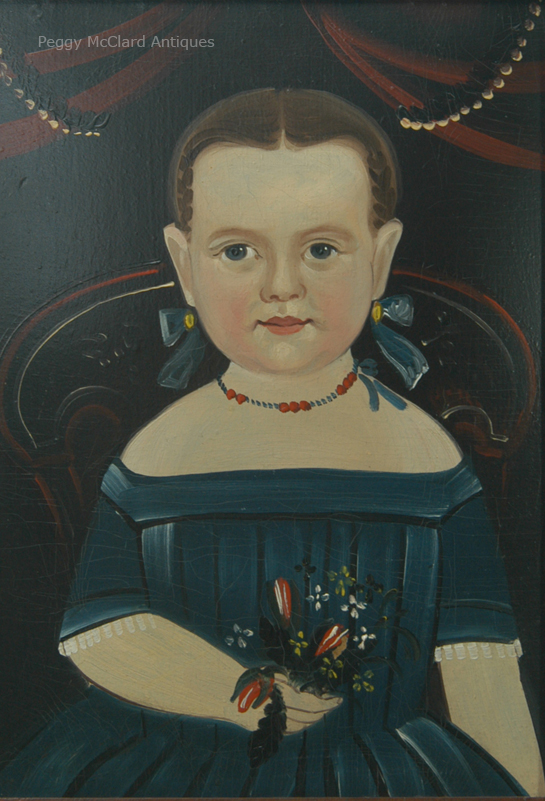
Sturtevant J. Hamblin (or Hamblen) (1817-1884) Prior-Hamblen School of Artists
Sturtevant J. Hamblin was born to Almery and Sarah Clark Hamblen in Portland, Maine in 1817. Almery (born Almory) was a a mechanic and painter. Almery & Sarah's first child was named George Hamblen, but by the birth of their second son in 1801, they seem to have decided to change the spelling of their last name to Hamblin. All located records for Sturtevant, list his last name as Hamblin, although some list his first name as Sturdivant (christening record, marriage record, 1850, 1860, 1870 census records). The Hamblin/Hamblen family was well known for their painting and glazing. In 1828, Hamblin's sister Rosamund Clark Hamblin married William Matthew Prior and the newly wed couple moved in with brothers Nathaniel, Joseph and Sturtevant. Thus, the Prior-Hamblen School of painting was born. In 1839, the entire family (including the Priors) moved to Boston. Of the Hamblin brothers, only Sturtevant considered himself a portrait painter.
The portraits of Hamblin have often been attributed to Prior. A recent article by David Krashes has provided us with solid clues to attributed Hamblin's work correctly. Mr. Krashes says:
There seem to be only seven known signed portraits by Sturtevant Hamblen.11 One has been sold twice by Sotheby's, and the other is in the collection of the Museum of Fine Arts, Boston. A notable characteristic of each painting is the fairly well-known Hamblen indicator of the pointed hand. The fourth finger is the longest; the next three fingers are progressively shorter down to the pinky.
Not so well known is the visual symmetry about a vertical centerline that is a feature of these two signed paintings and many other Hamblen portraits. In figure 6, imagine a centerline from the top of the painting through the part of the hair, through the nose, and down to the waist and see how everything painted to the left of the centerline seems symmetrical to everything on the right. Even the angles at which the ears protrude from the head seem equal. In figure 7, there is a similar symmetry about a vertical centerline through the child. In some cases, the symmetry exists except for the hair or may exist vertically only partway down the painting.
A typical Hamblen chin, which may not be visible in the pictures shown here, is an almost imaginary circle with its top an inverted arc visible beneath the lower lip. If a portrait suspected to be by either Prior or Hamblen contains no hands but shows a significant symmetry about the vertical centerline of the figure, or possibly the inverted arc chin, it may well be by Hamblen.
Krashes, David, "Understanding the Prior-Hamblen School of Artists A Little Bit Better", Maine Antique Digest, July, 2011. Click this link for the online article at maineantiquedigest.com.
Like Prior, Hamblin's naïve portraits are often painted on paperboard, a homemade version of artist's board made by layering paper atop pasteboard.
References:
Chotner, Deborah, American Naive Paintings, The Collections of the National Gallery of Art Systematic Catalog, National Gallery of Art, Washington, Cambridge University Press 1992. 164-171.
Hickman, Madelia & Pratt, Wayne, "The 'Celebrated' William Matthew Prior (1806-1873)", Antiques & Fine Art Magazine, online article at www.antiquesandfineart.com.
Krashes, David, "Understanding the Prior-Hamblen School of Artists A Little Bit Better", Maine Antique Digest, July, 2011, attached pdf graciously presented courtesy of Maine Antique Digest.
Rumford, Beatrix T. American Folk Portraits Paintings and Drawings from the Abby Aldrich Rockefeller Folk Art Center. New York Graphic Society, 1981. 112-117.
-
-

Sarah Harrington (active about 1774-1787)
Sarah Harrington is an enigma to say the least. Her successful career as a silhouettist might lead one to believe she was an 18th century proponent of women’s rights, but that does not appear to be the case. Mrs. Harrington (for I would not expect her to approve if I referred to her as Ms.) began her notoriety by authoring a book of instructions of ladies’ virtues. Her book, which was published in at least 4 editions was dedicated to Princess Amelia Sophia Eleanor. The dedication reads (in part)
Your ineffable mildness, and amiable disposition, accompanied by a noble and generous expansion of heart, are virtues that will naturally encourage and invite the timorous; attracted by those realities, with deference and respect I approach your Highness, . . . , upon consideration of with the Author has done her best for the service of her sex; I have endeavoured (as far as my weak abilities would permit) to contribute my mite in the promotion of sound and useful Knowledge, with an humble endeavour to point out the most effectual means of rendering permanently happy, not my own sex in particular, but the whole nation in general. . . . .
Mrs. Harrington’s book discussed the permissible amusements of an 18th century lady: 1. The Use of the Globes (which Mrs. H. taught—to ladies only); 2. Geography and Maps (part of the above described lessons); 3. Astronomy; 4. Reading; 5. Epistolary Correspondence, or Letter Writing; 6. Poetry; 7. Music; 8. Drawing. The book also described the proper Entertaining Amusments: 1. Dancing; 2. Theatrical Entertainments; and 3. Singing, etc.
The proper Mrs. Harrington later published a treatise on the knowledge and use of maps as well as a second treatise of proper womanly amusements. In this second treatise, she deplored “the amazing increase of Dissipations of almost every kind, at present seems to fascinate our minds, and occasion an almost total neglect of those Refinements so necessary to real happiness of human beings.”
In light of Mrs. Harrington’s concern of the properness of ladies’ activities, it seems out of character that she became so successful in her profession as a silhouettist, that in 1775, Sarah Harrington applied to patent her method of producing profiles. Her patent was accepted and she became a very successful itinerant artist.
Apparently, Mrs. Harrington’s silhouette business was extremely lucrative in university towns. Numerous advertisements aimed at “the Gentlemen of the University” show that she worked in Oxford and Cambridge often and that, as time advanced, her lodgings (where she also accepted customers) were found at more distinguishable addresses.
Hollow-cut silhouettes are rare from the British Isles after 1790. During the period that Mrs. Harrington cut her lovely hollow-cut silhouettes, few others joined her (the most notable exceptions are Mrs. Beetham and Mrs. Collins). Mrs. Harrington did not use trade labels until after 1782. Her earlier silhouettes are rarely inscribed with her signature on the back of the frames. It is believed that since she was one of the earliest silhouettists, she did not have sufficient competition to warrant labeling her work until the 1780s.
Mrs. Harrington’s work is recognized by the roughly textured black paper she used to back her exquisitely cut silhouettes. Also, while most 18th century silhouettists of the hollow-cut method often left a slash from the base of the paper to the base of the bust-line showing the knife entry to the paper, Mrs. Harrington took great care in making the entry of her knife as little noticeable as possible. She also took great care when rendering eyelashes and cut bows very simply and cleanly. She represented men’s shirt frills as scallops and cut the buttons on a man’s shirt as triangles.
-
-
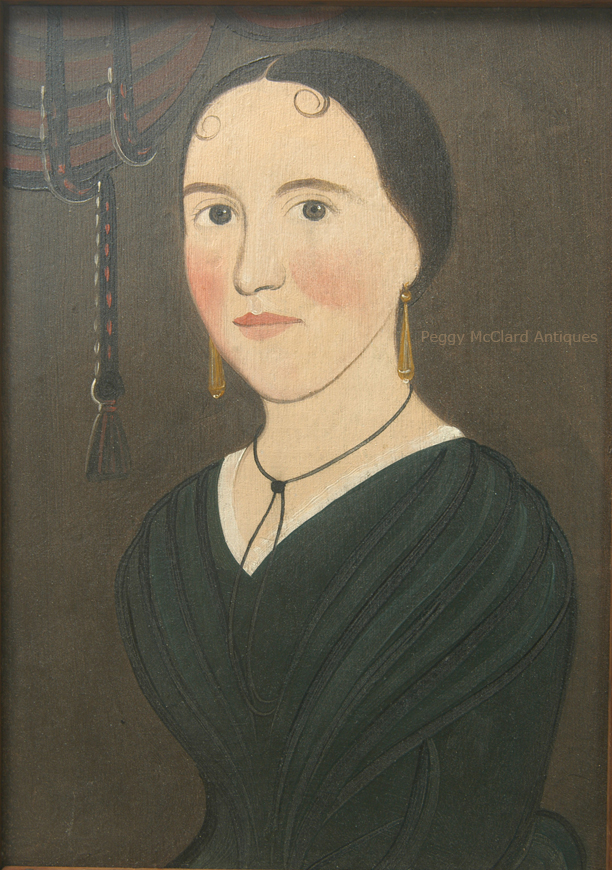
George Hartwell (1815-1901) Prior Hamblen School of Artists
Most details of the life and George Hartwell are unknown. However, we do know that his niece, Elizabeth Hartwell, married one of Sturtevant Hamblin's brothers (variously named James or Joseph G.--I found two federal census records that list him as Joseph G. Hamblin, 1850 as a painter and 1860 as a master builder). We know that Elizabeth and her Hamblin husband lived in Boston at the time that William Matthew Prior lived there. Thus, the connection of George Hartwell with the rest of the Prior-Hamblen School of artists is established.
David Krashes tells us that the main distinguishing features of Hartwell's portraits are the lips and the fingers. The lips are noted by their tonality, in which the upper lip is a fairly dark red field and the lower lip is a lighter reddish-white. The two lips are generally separated by a dark brown line. Each lip is painted with a single brushstroke. Hands of Hartwell and Hamblin can be quite similar but Hartwell is known for painting fingers with a single brushstroke, separated by strong brown lines, each finger being tapered and often showing fingernails.
References:
Krashes, David, "An Appreciation of Nineteenth Century Folk Portraits", Antiques & Fine Art Magazine, online article at www.antiquesandfineart.com.
Krashes, David, "Understanding the Prior-Hamblen School of Artists A Little Bit Better", Maine Antique Digest, July, 2011, attached pdf graciously presented courtesy of Maine Antique Digest.
-
-
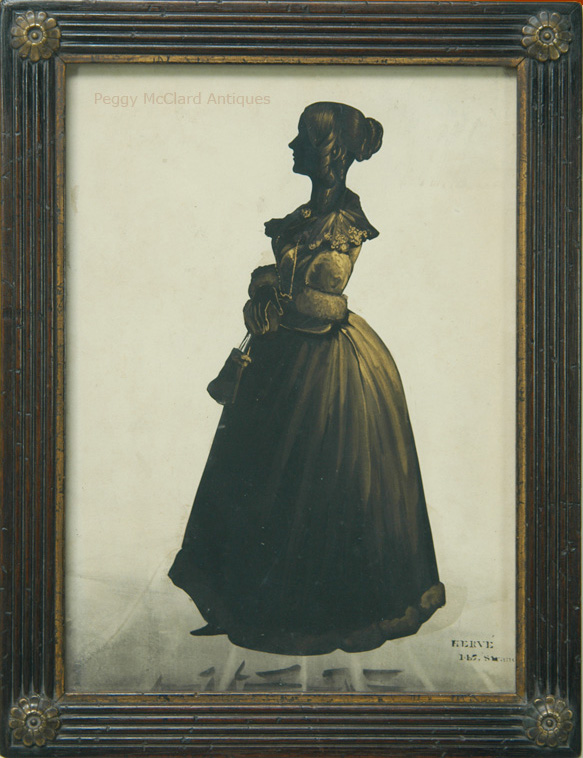
Charles Samuel Hervé II (1785-1866)
Charles Samuel Hervé II was a miniature painter, silhouette artist, professor of music, manager of the Prosopographus gallery and a fruit farmer. He worked at various addresses in London under his own name and with his nephew, Alfred Hervé, Count de la Monnière.
Recent research shows that Hervé was probably the mysterious “Prosopographus, the Automation Artist.” Handbills have been found showing that Hervé managed the mysterious gallery which appears to have been active from 1818 until the end of the 1820s. In fact, the found handbills advertised that Hervé invented the illustrious “Prosopographus,” a machine that drew the basic outline of the sitter’s profile. It is believed that Hervé’s assistants procured the basic outline via the machine, but Hervé cut and painted the silhouettes.
Hervé also worked for William Miers for a period of about 5 years. William Miers was the son of the great silhouettist John Miers. William was a profilist in his own right, but concentrated his work primarily on frame-making. It appears that Miers hired Hervé to produce copies of John Meirs’ great work for later orders. Hervé is known to have been an exceptional artist at copying other’s styles and works as well as producing extraordinary silhouettes from life in his own great style.
When working from his own gallery, Hervé used stencils to identify his work, as did his nephew Alfred. Stencils showing only the Hervé surname must be assumed to be Charles. As the elder family artist, he would have the right to the surname. Alfred’s stencils, while similar in style and fonts, identify the artist as “A. Hervé.”
Please view the Hervé silhouettes currently in offered on the Silhouettes page.
-
-
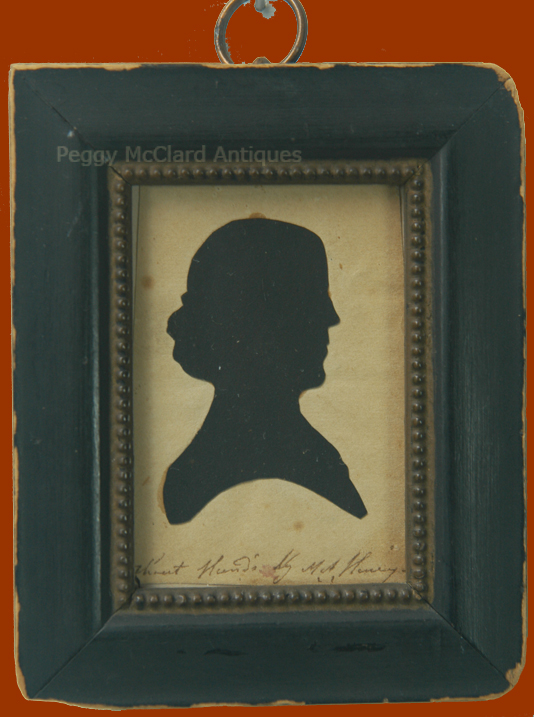
Martha Ann Honeywell (about 1787-after 1848)
Like Hubard, Martha Ann Honeywell was a child prodigy. While her silhouettes are more naïve, even a bit clumsy than Master Hubard’s, part of the charm of Miss Honeywell’s silhouettes is the triumph to human accomplishments that she could even produce them at all. Miss Honeywell was born around 1787 in Lempster, New Hampshire with only the first joints of both arms, and one foot with only three toes. The first broadsides announcing her profession of profile cutting appear in 1806 and continue until 1848. The signature on Miss Honeywell’s cut & paste silhouettes proclaims either “Cut without hands by M.A. Honeywell” or "Cut with the Mouth by M. A. Honeywell". Most of the silhouettes are plain, but a few gilded examples have been recorded.
While Miss Honeywell was traveling along the Eastern shore board of America and to Europe to cut her silhouettes, she also offered finely stitched needlepoint watch papers, wrote tiny verse with her mouth and did Scherenschnitte (scissor-cuttings). Pictured are examples of both—the needlepoint is wonderfully executed and the verse is so tiny it requires a magnifying glass to read. With magnification, one sees that it is the entire Lord's Prayer, written within less than three-quarters of an inch of paper.
Please view the Honeywell silhouette currently in offered on the Silhouettes page.
-
-
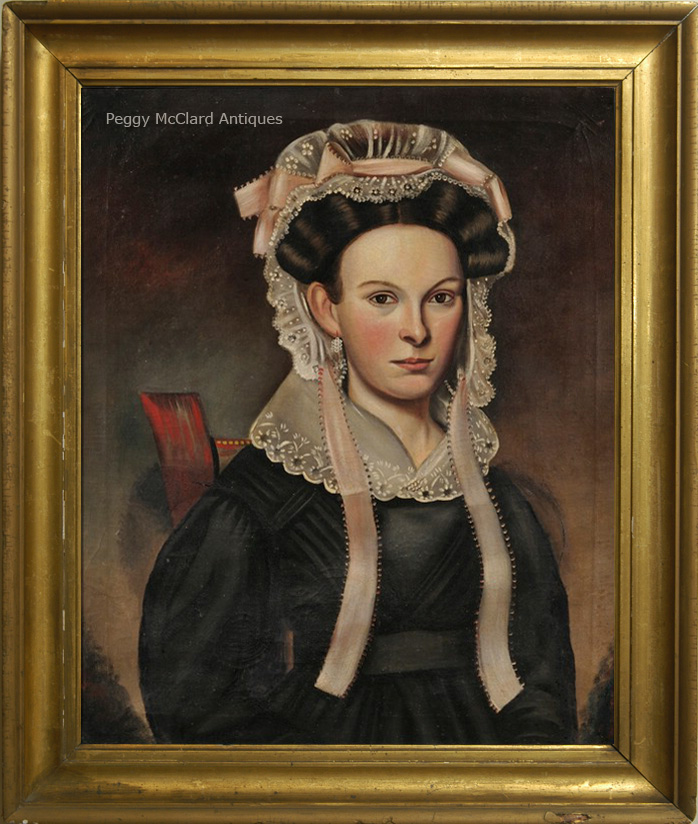
Milton William Hopkins (1789-1844)
Milton Hopkins was born to Hezekiah and Eunice Hubbel Hopkins on August 1, 1789 in Harwinton, Litchfield County, Connecticut. He moved with his parents and seven siblings to Pompey Hill, New York in 1802. Hopkins married his first wife, Abigail Pollard about 1809. Hopkins and Abigail had one son. After Abigail's death, sometime before 1817, Hopkins married his second wife, Almina Adkins and moved with his wife and son to Evans Mills, New York. Hopkins and Almina had nine children. Although his occupation during his late teens and early twenties is unknown, his purchase of several acres of land suggests that he may have been a farmer.
In 1823, Hopkins moved his family to Newport, New York (renamed Albion in 1826). Hopkins 1824 advertisement in the Newport (New York Patriot) states that he was painting houses and signs, gilding, glazing, chair-making, and selling painting supplies. For part of the year 1828, Hopkins served as captain on an Albion canal boat, but by December of that year, he had moved to Richmond, Virginia. His 1828 advertisement in the Richmond Constitutional Whig says that he was instructing women in Poonah (also known as theorem painting). He probably assisted a "Miss Turner" who ran an academy for drawing, penmanship, "Music, Painting on Velvet, Wood and Paper and Fancy Work."
Hopkins moved his family back to Albion in 1829 and, in 1833, he advertised in The Orleans Advocate and Anti-Masonic Telegraph that he was both a portrait painter and a teacher. It is now believed that Hopkins taught fellow portrait artist, Noah North, whose earliest known works date from 1833. Hopkins likely worked as a portrait artist prior to 1833, but his earliest known works are dated 1833.
In 1826, Hopkins renounced his Masonic affiliation and became a spokesperson for the anti-Masonic movement. By 1830, he was a leading spokesperson for the Orleans County Temperance Society, traveling and speaking throughout the Rochester area. It is likely that is involvement in the abolition movement associated with the anti-Masonic views prompted him to move to Ohio where he was an important supporter of the Underground Railroad in Cincinnati and Columbus. It appears that his portrait commissions from supported his participation in abolitionist activities. Most of Hopkins sitters were active participants in a flourishing rural society whose focal point for many reform movements.
Hopkins New York works are characterized by a labored modeling of the face with fine strokes of paint, contrasted with a flatter, more awkward treatment of the body. The sitters from this period all share long, narrow lips, squared-off fingernails, indications of creases on finger joints and meticulous attention to the laces and accessories of women.
In 1836, Hopkins and his family moved to Ohio where he bought a farm in Williamsburg, near Cincinnati. Between 1836 and 1838, Hopkins was apparently exposed to academic portraiture because his portraits dated 1838 show greater sophistication in the heads but still have flatly painted bodies, sometimes appearing too small for the head size.
Hopkins 1839 advertisement in The Ohio Statesman shows that he had set up a studio in Columbus, but he was painting portraits in Jackson, Mississippi and other southern states in the early 1840s. Hopkins died of pneumonia while visiting his farm in Williamsburg on April 24, 1844. He was buried in Williamsburg until about 1863 when his children moved his remains to Spring Grove Cemetery in Cleveland.
For many years, Hopkins unsigned works were attributed to his probable student, Noah North. In the 1980s the discovery of a portrait nearly identical to those of North but signed and dated "M.W. Hopkins 1833" prompted a reevaluation of the entire body of work. The careful painting and graining of chairs upon which sitters pose shows that both Hopkins and North were active ornamental painters and that Hopkins was a chair-maker and gilder. Hopkins' well-modeled faces give his work a more three-dimensional, naturalistic quality than North's portraits exhibit. Other distinguishing traits of Hopkins' work include: broad, arching eye-brows; indented temples; slightly oversized ears with a C-shaped inner ears; softly modeled eye sockets; highlighted eye pupils and interior corners of the eyes; salmon colored lips; shading to the side of sitters' noses; and greatly detailed lace and accessories for women sitters.
Chotner, Deborah, American Naive Paintings, The Collections of the National Gallery of Art Systematic Catalog, National Gallery of Art, Washington, Cambridge University Press 1992. 206-210.
D'Ambrosio, Paul S. and Emans, Charlotte M., Folk Art's Many Faces: Portraits in the New York State Historical Association, New York State Historical Ass'n, Cooperstown 1987. 99-102.
Oak, Jacqueline, Face to Face: M.W. Hopkins and Noah North, Museum of our National Heritage (exhibit catalog), Lexington, Massachusetts, 1988.
Oak, Jacqueline, "Milton W. Hopkins Pierrepont Edward Lacy and His Dog, Gun (1835-36), Seeing America: Painting and Sculpture from the Memorial Art Gallery, http://mag.rochester.edu/seeingAmerica/essays/5.swf
-
-
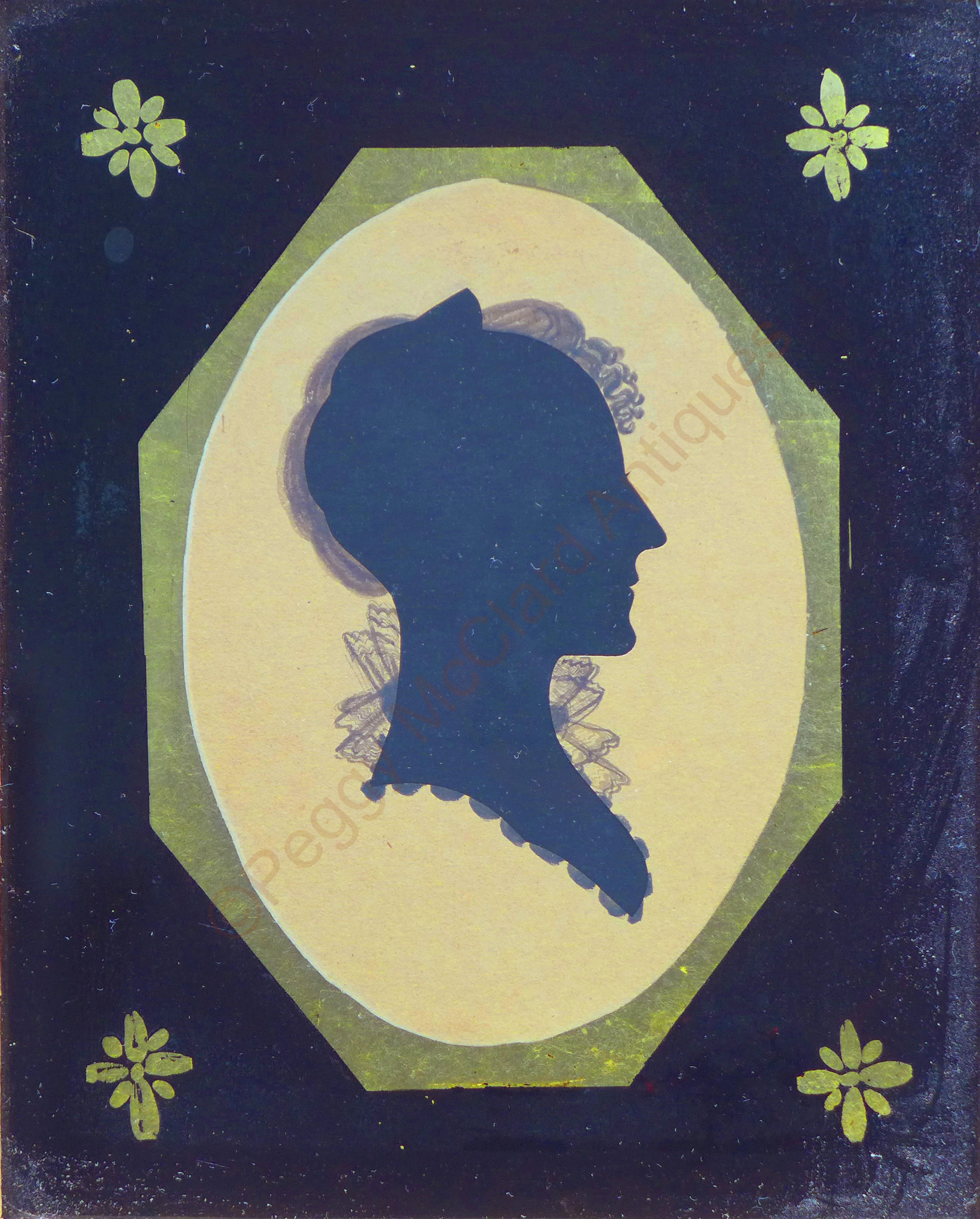
Everet Howard, American Silhouettist (1787-1833)
Everet Howard, my favorite American silhouette artist, was born in Bridgewater, Massachusetts, November 22, 1787. His family moved to Leeds, Maine in 1801. He taught school for a time but, tired of teaching unruly young scholars, he quit his job and began to look for something else to do. Always a budding artist, Howard loved to “draught likenesses” of friends and dabbled in landscapes. In April, 1807, Howard “got a good horse to ride to the Westward” and commenced making preparations to journey west, through New Hampshire, Vermont and New York. It isn’t clear what Howard intended to for money—perhaps he would find another schoolmaster position or visit with relatives as his brother had done. But, a few days before his scheduled departure, Howard decided to “invent” a profile machine and become a profile artist. He worked on his “invention” for half of a day and then proceeded to take profiles. Howard improved on the machine’s design over the next week then, happening upon an itinerant profilist, replaced his own homemade machine by making a trade for the machine of the other artist. Then he set out to make his fame and fortune as a silhouettist. Howard did quite well as a last minute artist. He traveled and worked in much of Maine and showed up in the New York City Business Directory for the years 1813 and 1816. We have no records for other cities, but we assume he worked in other parts of New England. There are no known silhouettes by Howard with a handwritten signature, but a few of his silhouettes have been found with 2 different embossed signatures, EVERET HOWARD. We know that he bought one signature stamp in Brunswick, Maine. We are aware of one pair of watercolor profile portraits by Howard. They are signed with one of two impressed signature stamps that we know existed.
Everet Howard’s silhouettes are wonderful examples of just how creative a machine-traced silhouette can be. The profiles are sharp and lifelike—indeed technically very well-done. But what creates the great distinction in Howard’s silhouettes are the flourishes he used as additions within and outside of the cut profile. We have solid evidence of three bust-line terminations used by Howard. The most common (which I will call Type 1) includes part of the sitter’s arm to which the front of the bust-line curves up to meet the front of the arm. The Type 1 bust-line essentially has a half-moon cut upward at the arm and one cut downward at the front. The second bust-line (Type 2) has two half-moons cut so that they might be compared to a cursive “w”. The bust-line used in the watercolor profiles we know of is also Type 2. The third (Type 3) is comprised of 2 half-moons curving upward—basically the opposite of Type 2. Type 3 is often found with drawn circles or dots below the bust. Howard varied the depth of the half-moons so that, with the drawn dots, one might miss the middle point of the cut when viewing.
Howard added painted and drawn flourishes such as hair, shirt fronts, and lace collars that are eye-catching and well-done. He was a master at these flourishes. We know of two silhouettes in which Howard cut an embellishment below the bust-line for no other purpose than a bit of lagniappe for the viewer. Howard sometimes, by seldom, cut hair by slashing strokes of a pen-knife. Howard often painted or drew circles or dots around the profile of women. Sometimes the circles were only below the bust-line and other times he completely edged the profile with circles. As odd as it sounds, the circles really complement the profiles. He drew hair and clothing details, sometimes in ink or watercolor and often in pencil.
Howard's style shows how a machine-traced silhouette can be enlivened after the tracing with creativity and artistic flourish. The lucky few who own the rarely found silhouettes by Everet Howard own American folk art treasures. Rarely are they found with the embossed signature, but much of Howard’s work is so distinctive that with study, it can be easily attributed.
References:
Payne, Suzanne Rudnick & Michael R. and McClard, Peggy, “Shadow & Scissors”, The Magazine Antiques, Jan. 19, 2018, online article at https://www.themagazineantiques.com/article/shadows-and-scissors/.
Lester Ward Parker, “Diary of a Young Man, 1807– 08”, The New-England Galaxy, vol. 7, no. 1 (Summer 1965), pp. 31–42. Article based on diary of Everet Howard.
Please view the Howard silhouette currently in offered on the Silhouettes page.
-
-

Master William James Hubard, Child Prodigy Silhouettist (1807-1862) and The Hubard Gallery (active 1823- circa 1845)
Born in Whitchurch Shropshire, England Master Hubard began cutting silhouettes at 12 years of age. He was a celebrated silhouette artist (some say an exploited child prodigy) even before he came to America in 1824 at the ripe old age of 17. By the age of 15, Master Hubard had been called upon to cut the silhouettes of the Duchess of Kent and Queen Victoria (who was still a slender little princess at the time). In 1823, the editor of a newspaper in Norwich exclaimed “We do not hesitate to pronounce Master H. the greatest phenomenon of art that this city ever witnessed, . . .”
In 1824, he landed on American soil in New York at the ripe old age of 17. In New York Hubard set up the Hubard Gallery at 24 Coney Street and charged 50 cents per profile. I've only seen one silhouette which Master Hubard hand-signed ("James Hubard"). His silhouettes are generally stenciled “Hubard Gallery” onto the back, use an impressed mark stating simply “Hubard”, or either the silhouette or frame is backed by one of numerous printed trade labels. After Hubard left, the Gallery used impressed stamps saying “Hubard Gallery” or “Taken At The Hubard Gallery” and also numerous trade labels continuing to tout the talent of Hubard even though the silhouettes were being cut by other artists.
Full-length silhouettes cut by Hubard are more commonly found than busts. Although the earliest were not embellished, Hubard became a master at gilt embellishment before the end of his silhouette career. Unlike many of his contemporaries, Master Hubard never relied upon contraptions or machinery for aid in cutting his silhouettes—only common scissors. His silhouettes are always cut & paste.
In 1827, Hubard broke from his manager (known only as "Mr. Smith") and took up portrait painting under the tutelage of Gilbert Stuart. We know from his letters that he occasionally continued to cut silhouettes even after becoming an accomplished portrait artist. During the 1850s, Hubard became interested in sculpture and established a foundry in Richmond, Virginia for casting bronzes. When the Civil War started, Hubard turned his attention to inventing and producing an explosive for use by the Confederate Army. He was killed at his foundry by an exploding shell.
McKechnie tells us that Hubard's early manager, Mr. Smith, continued to run the Hubard Gallery as a going concern until about 1845. We know that Master Jarvis (or Jervis) Hankes (or Hanks) was cutting silhouettes for the Hubard Gallery before Hubard broke with Smith. McKechnie believed that Hankes continued with the Gallery for some years after Hubard left. McKechnie also found evidence that Samuel Thomas Gill advertised himself as having at onetime worked for the Hubard Gallery. The fact that the Hubard Gallery employed several artists and the fact that Hubard continued to occasionally cut silhouettes both in America and abroad makes it very difficult to determine the origins of silhouettes cut after 1823.
References:
Hansen-Knarhoi, Megan, "'Silhouette of man 1' - Taken At The Hubard Gallery", NelsonMuseum.co.na
Please view the Hubard and Hubard Gallery silhouettes currently in stock on the Silhouettes page.
-
-
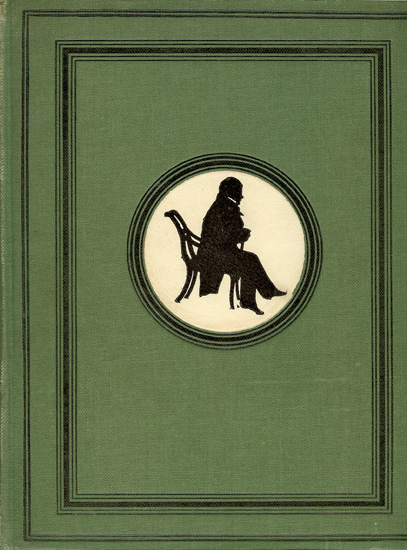
Ancestors in Silhouette by August Edouart
If you are a collector of Edouart or just love his work, this book is a must for you. Mrs. Jackson's ground-breaking work after she uncovered his rescued folios and cataloged everyone that she had possession of. This is the most complete work on Edouart (other than, perhaps the treatise he wrote himself). It contains detailed information about Edouart's life, his work, his recordkeeping (the duplicate folios and detailed receipt books), and the most complete list of Edouart's sitters that is currently available. It is filled with approximately 230 black & white images showcasing his work. I refer to this book every time I acquire another Edouart. I want to see whether that sitter was recorded in the rescued folios (and remember that some were never rescued and some turned up after Mrs. Jackson published this book). This book has become harder and harder to find. This copy has clean and unworn green cloth boards, with gilt spine titles and a circular silhouette on front (some loss to the white edge). Top edges gilt, other edges un-trimmed. A small blank bookplate on front pastedown (with no name). First and last pages slightly browned, otherwise a Fine copy, with no inscriptions or foxing. Please note that the photo to the left is a stock photo and not of this copy. The copy offered has some loss to the circular white silhouette background. Please ask me for a photo of this particular copy of some loss on the silhouette might bother you. I want you to know exactly what you are buying.
(#5219) $275
-
-
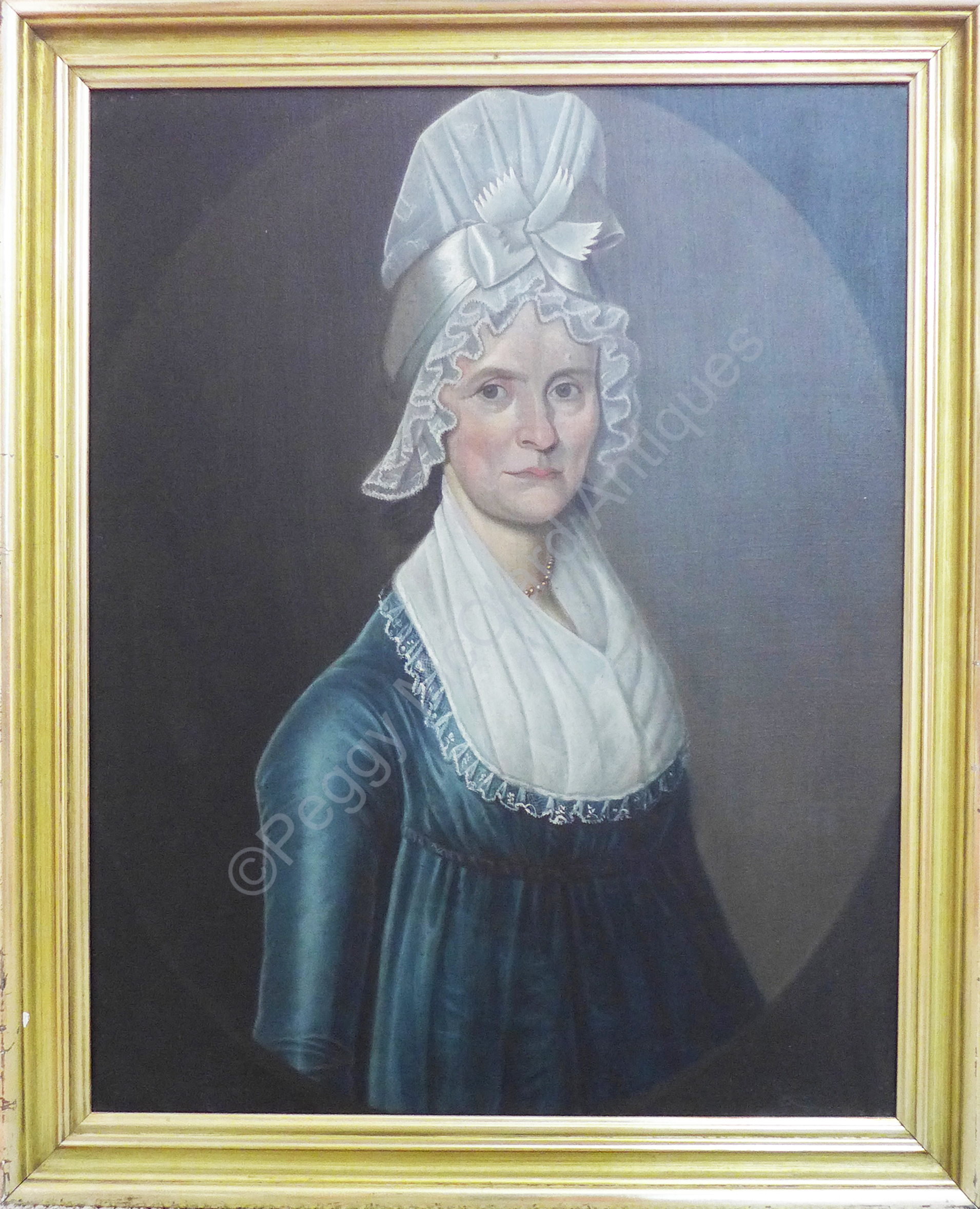
Richard Jennys (ca. 1734-after 1809) & William Jennys (1774-1859)
Richard and William Jennys are some of the earliest Colonial American portrait painters. Richard Jennys Jr was born in London, circa 1834 and immigrated to Boston around 1841. Richard Jennys Sr was a notary public and the family apparently had some wealth and social standing. The first record of Richard Jr was when he was admitted to Boston Latin School in 1844. A classmate was Nathaniel Smibert, son of artist John Smibert. Although we do not know what artistic training Richard might have had, he may have been mentored by other important artists of Boston such as John Smibert and Peter Pelham (engraver and step-father to John Singleton Copley). The first documentation showing that Richard was an artist was in 1764 when Paul Revere’s records note that Revere sold a gold frame and glass which was probably used to frame a portrait miniature. (It is noteworthy that although no portrait miniature by Richard have been found, he advertised that he painted portraits and miniatures, once describing himself as a portrait painter “Chiefly in Miniatures”). Around 1765 the young artist received a commission for a mezzotint of the great theologian Reverend Jonathan Mayhew. The mezzotint shows Richard’s talent at depicting faces with strong modeling and shading. Paul Revere admired Jennys’ mezzotint so much that he it as a model for his own rather crude engraving of Mayhew.
In 1770, Richard married Sarah Ireland, with whom he had five children, including second-born William Jennys, born January 1774 in Boston. Richard’s marriage was not a success and the couple divorced sometime between 1787 and 1800 when Sarah appeared in Nassau, Bahamas, married to Peter Ogle, a liquor dealer.
Unfortunately, Richard does not seem to have been a great financial manager and by 1768 was describing himself as a merchant. He seems to have been mostly engaged as a merchant until around 1776 when he advertised that he was continuing his profession as a portrait painter. Jennys’ initial problems in pursuing a career as a portraitist may have been due to the overshadowing of the great John Singleton Copley who was the darling of Boston society for portraits at this time. Copley left Boston for England in 1774 which may have encouraged Richard to return to his artistry. While both Richard and William Jennys’ portraits are evidence that they had great skill in portrait painting and that they were commissioned by leading citizens in the New England towns in which they worked, Richard seems to have been unable to support himself. We do not know whether his financial problems were because of lack of well-paid commissions or inability to handle his finances—although I suspect it was the later. Just prior to leaving Boston for Charleston, South Carolina, Richard’s landlady sued to evict him for failure to pay rent. Richard lived in Charleston and Savannah, Georgia from 1783 to 1792 and defaulted on his taxes at least three times during that period.
In 1792 Richard left the South for New Haven, Connecticut and this is the first time that we know that father and son William were working together as portrait artists. William’s first known advertisement as a portrait artist was in 1793 in Norwich, CT. Beginning in 1793, both Jennys experienced a sixteen year period of success as itinerant artists. Richard was fifty-eight and making a living as an artist for the first time. Nineteen-year-old William was at the beginning of what appears to have been a much more successful career than his father. The two men crisscrossed New England, limning in 55 towns. They mostly seemed to travel and work separately but there are five known instances during which they worked in the same town at the same time. During two of these meetings, they worked jointly on signed portraits. In 1805, at 78 years old, Richard was still advertising as a painter. The date of his death is unknown. The last word from Richard is an 1809 letter to his son, William.
William Jennys married Mary (Polly) George in 1806. They had two sons before Polly died. Sometime after Polly’s death, William married her younger sister, Laura Columbia George. William added silhouette cutting to his artist endeavors sometime around 1805 when his first known advertisement for profile cutting with a physignotrace appeared in a New Hampshire newspaper. We aren’t sure when William abandoned his career as an artist, or if he ever did. He did continue to buy and sell real estate (at which he was very successful) and also worked as a comb-maker, florist, farmer, tavern keeper and traveling dry goods merchant before his death in 1859 at the age of 85.
The styles of father and son are very similar and it is clear that Richard tutored William in painting. Sitters are depicted at half-length, turned three-quarters toward the viewer. Shoulders droop dramatically and neither artist were skilled at drawing arms and hands, which they generally hid from view. The Jennys are known for their skillful depiction of their sitters’ faces. Richard is said to take a more academic approach while William used heavy modeling that gives his faces a sculptural quality. William often used a painted oval portal in which to place his sitters. By contrast, his father is rarely used this artistic device. Canvases for both artists are approximately 25” x 20” unless they were painting portraits of children for which they used smaller canvases. Paint is thinly applied. The color palette tends to be muted although William added brighter colors to his palette as he developed his own style, especially when painting children. William’s portrait style varied a bit during his career, sometimes depicting facial features with great skill and care but sometimes appearing to have rushed through his commission quickly with the result being flatter, more two-dimensional facial features. Whether he was practicing the marketing ploys of the later artist, William Matthew Prior, and giving his sitters a portrait according to what they wanted to pay, we will never know. We do know that for some years William made more money buying and selling real estate—probably more money than an artist in his day could ever hope to make. It has been suggested that he was perhaps so busy with real estate that he spent less time on his commissions. Whatever the reason for William’s variance in his portraits, the flat, more naïve portraits are every bit as charming and desirable as his more complete pieces.
The Jennys did not flatter their patrons in portraiture but it is likely that these crusty New Englanders did not want to be flattered. Their portraits are lifelike and often dramatic. They depict strong souls with determined goals. Their sitters were from the successful families of hard Colonial times and the Jennys made sure to show their sitters’ strength in their portraiture.
References:
Jones, William Bright. "The Portraits of Richard & William Jennys and the Story of their Wayfaring Lives." Ed. Peter Benes. Painting and Portrait Making in the American Northeast. N.p.: Boston U, 1994. 64-97. Print. The Dublin Seminar for New England Folklife Annual Proceedings 1994.Payne, Michael R. , Ph.D., and Suzanne Rudnick Payne, Ph.D. "The New "Delineating Pencil" Silhouettes by William Jennys." Antiques & Fine Art, Jan. 2011: 320-27. Print.
Museums Exhibiting Works by Richard & William Jennys include: Metropolitan Museum of Art, NY; Museum of Fine Arts, Boston; National Gallery of Art, Washington D.C.; Currier Gallery of Art, NH; Farnsworth Art Museum, Rockland, ME; Harvard University Art Museums, MA; Mattatuck Museum, Waterbury, CT; Middlebury College Museum of Art, VT; Minneapolis Institute of Arts, Minnesota, MN; Wake Forest University, Winston-Salem, NC; Chrysler Museum of Art, Norfolk, VA, Litchfield Historical Society, Litchfield, CT.
Please view the Jennys portraits currently in stock on the Portraits page.
-
-

T.P. Jones (active First Quarter 19th Century)
Little is known about the American silhouettist T.P. Jones. He may be the artist that Mrs. Jackson refers to as "F.P.Jones" in her book Silhouettes A History and Dictionary of Artists. In 2007, ebay sold a pair of silhouettes clearly stamped "F.P. JONES / FECIT". Since I did not see the F.P. Jones pair in person, I can not vouch for their authenticity as a 19th century pair. It is possible that a company such as Foster Brothers created the pair as a reproduction, using Mrs. Jackson's reference as their example. Dictionary of Artists in America 1564-1860 by Groce and Wallace says of T.P. Jones, "Silhouetteist working in the vecinity of Schenectady (N.Y.) in 1808. Cf. F. P. Jones ¶ Baker, "The Story of Two Silhouettes," repro." Of F.P. Jones, Groce says, "Itinerant silhouettist of early 19th century, New England. Cf. ___ Jones, portrait painter at NYC in 1818 and T.P. Jones, silhouettist at Schenectady (N.Y.) in 1808. ¶ Carrick, Shades of Our Ancestors, 120." Are T.P. and F.P. Jones the same person? I do not yet have the answer to that.
Thanks to the research of Sue Anderson, we do now know that T.P. Jones and Isaac Todd worked together in New York City from at least April through June 22, 1805. They advertised on April 1, 1805, in the American Citizen that they had united for profile likenesses on William Street. On June 22, 1805, the two artists advertised in the Republican Watch Tower, that they had removed to Maiden Lane. By August 13, 1805, Jones advertised alone in the Evening Post of NYC.
According to the family history passed along with one of the silhouettes that I once owned, T.P. Jones was still working in New York City in 1826 when he cut the silhouette of Elizabeth Read(e), second cousin, once removed, to General George Washington.
T.P. Jones work beautifully executed hollow cut bust length profiles with a sloping bust termination. His sitters have a small cut eyelash and his women usually display a delicate lock of hair above the forehead. They are quite scarce and heavily sought by collectors.
-
-
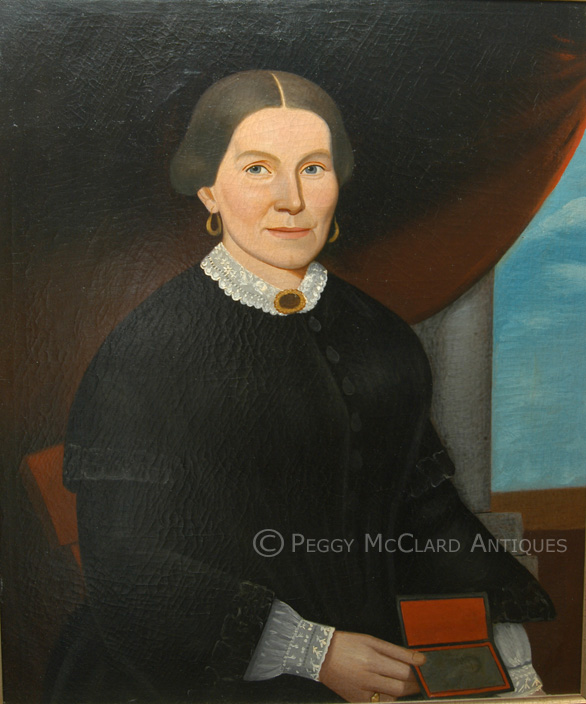
William W. Kennedy (1818-after 1870) Prior-Hamblin Group of Artists
From American Folk Portraits Paintings and Drawings from the Abby Aldrich Rockefeller Folk Art Center, we learn the following about William Kennedy:
"Kennedy is perhaps the least well known of the portraitists referred to as "Prior Hamblin" artists. To date no contact between him and any other member of this stylistically linked group of painters has been documented. The opportunity for exposure to William Matthew Prior's work certainly existed, however, as is readily apparent upon comparing recorded dates and locations of activity for the two artists in both New England and Maryland. Especially noteworthy is the fact that Prior's signed Baltimore works bear an East Monument Street address only a few doors from where Kennedy worked from 1856 to 1859."
"Recent [pre-1981] research by the Folk Art Center has revealed fourteen signed examples of Kennedy's work, which provide the stylistic basis for an additional thirty-nine attributions. Peculiarities of his anatomical descriptions include exaggerated shading around the nose, a U-shaped configuration connection the eyebrows and nose of the subject, a dark line between the lips--often with T formations at each corner of the mouth--and a particularly distinctive curvature of the extended fingers of the subject's hands. Occasionally Kennedy's portraits incorporate devises like a landscape view through a window or door, or objects such as a rattle, flute, stick and hoop, drumsticks, or a basket of flowers. But the props he used most frequently were a rose in the outstretched hands of female subjects, and a book in the hands of male sitters. Although he sometimes depicted children full length, either seated or standing, his portraits on canvas generally show a half-length subject seated in a side chair against a background that is either draped of shaded half light and half dark. Kennedy painted likenesses on canvases of standard sizes and of the small academy board variety frequently associated with artists of the Prior-Hamblin group."
William W. Kennedy (1818-after 1870) is one of the six artist known as the Prior-Hamblen School of artists. Although no direct connection has been found between Kennedy and either Prior or Hamblin, Kennedy's advertisements, city directory listings and painting inscriptions place him in the same locales as Prior during the 1840s and 50s and Kennedy lived a few houses away from William Matthew Prior during the 1850s. It is obvious that Kennedy was aware and studied the works of the Prior Hamblin group of artists as his work is similar in style and technique. In 1845, Kennedy advertised that he was painting "A New Style of Portrait" which seems to refer to the flat style of portraiture that Prior advertised could be accomplished quickly and inexpensively. The wording of Kennedy's ad is very similar to the wording of Prior's advertisements and Kennedy states that he is "of Boston", lending more credence that the two artists were connected by more than style.
Rumford, Beatrix T. American Folk Portraits Paintings and Drawings from the Abby Aldrich Rockefeller Folk Art Center. New York Graphic Society, 1981. 136-137.
Wertkin, Gerald C. & Kogan, Lee, Encyclopedia of American Folk Art. Routledge, New York, 2004. 272.
-
-
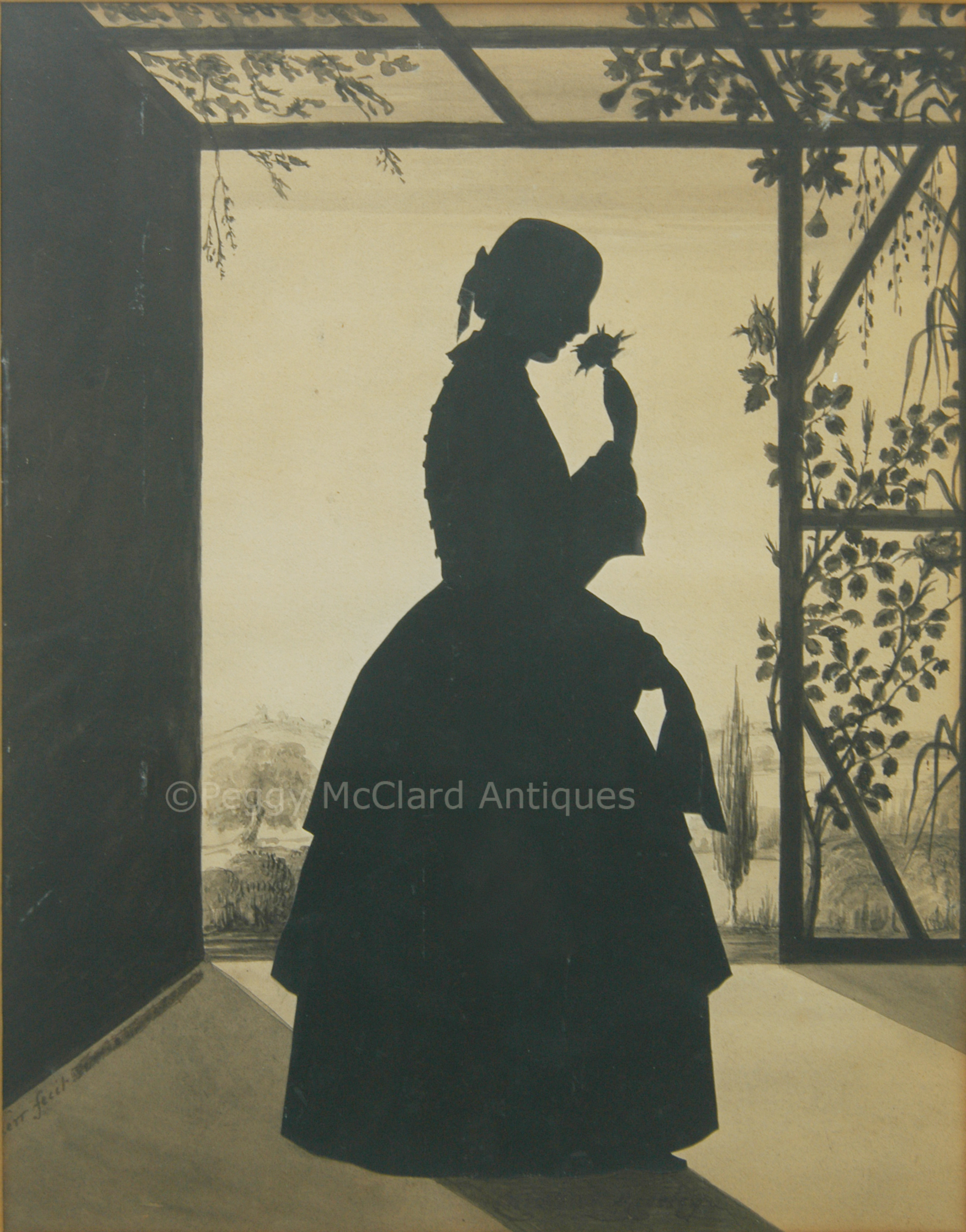
Lady Louisa Kerr (active 1825-1868)
Lady Letitia Louisa Kerr was born in London in 1800 and baptized in Marylebone as Letitia Margaret Kerr, the name chosen for her by her aristocratic parents, Lord Mark Robert Kerr (third son of the Marquis of Lothian) and Charlotte MacDonnell (daughter of the Earl of Antrim and later the Countess of Antrim). It was the artist, herself, who later changed her name to Letitia Louisa Kerr. Lord Mark Kerr was a gifted amateur artist, painting watercolor landscapes and caricature drawings. Louisa had seven brothers and five sisters. Two of her brothers inherited the title of Earl of Antrim after their mother died and both changed their last names to MacDonnell, their mother’s family name. The title exists through today in the McDonnell family (note that the family has dropped the “a” from the spelling of their name) and family members continue to live at the family home Glenann Castle in Northern Ireland. Artistic talents still run in the family. One descendent, Hector McDonnell is a well-recognized artist.
Growing up during a time when most girls were educated at home, it is not surprising that we have found no evidence that Lady Louisa ever went to school. But her great love of and talents for art were seen early. We know that she was cutting silhouettes by the time she was 18 years old (in 1818) and that she was painting in watercolors at least by 1821. Lady Louisa remained unmarried (and took care of her aging parents until their deaths) until 1871 when she married widower Capt. Cortlandt George MacGregor Skinner. Lady Louisa never sold her artwork but she seems to have cut or painted profiles at most gatherings of her aristocratic friends and family. She painted wonderful watercolor backgrounds on which to place her full-length silhouettes and did us the honor of naming each sitter along with her signature and where the piece was created. There are a very few known examples of fully painted silhouettes, one being a self-portrait that also includes her step-uncle riding horses. Almost all of Lady Louisa’s sitters were either women or children. This fact fits with the time when men left the women to visit with each other after formal dinners. Lady Louisa cut silhouettes until at least 1868. She died in 1885. Her silhouettes are greatly sought-after and extremely scarce on the market.
Please view the Kerr silhouette currently in stock on the Antique Silhouettes page.
-
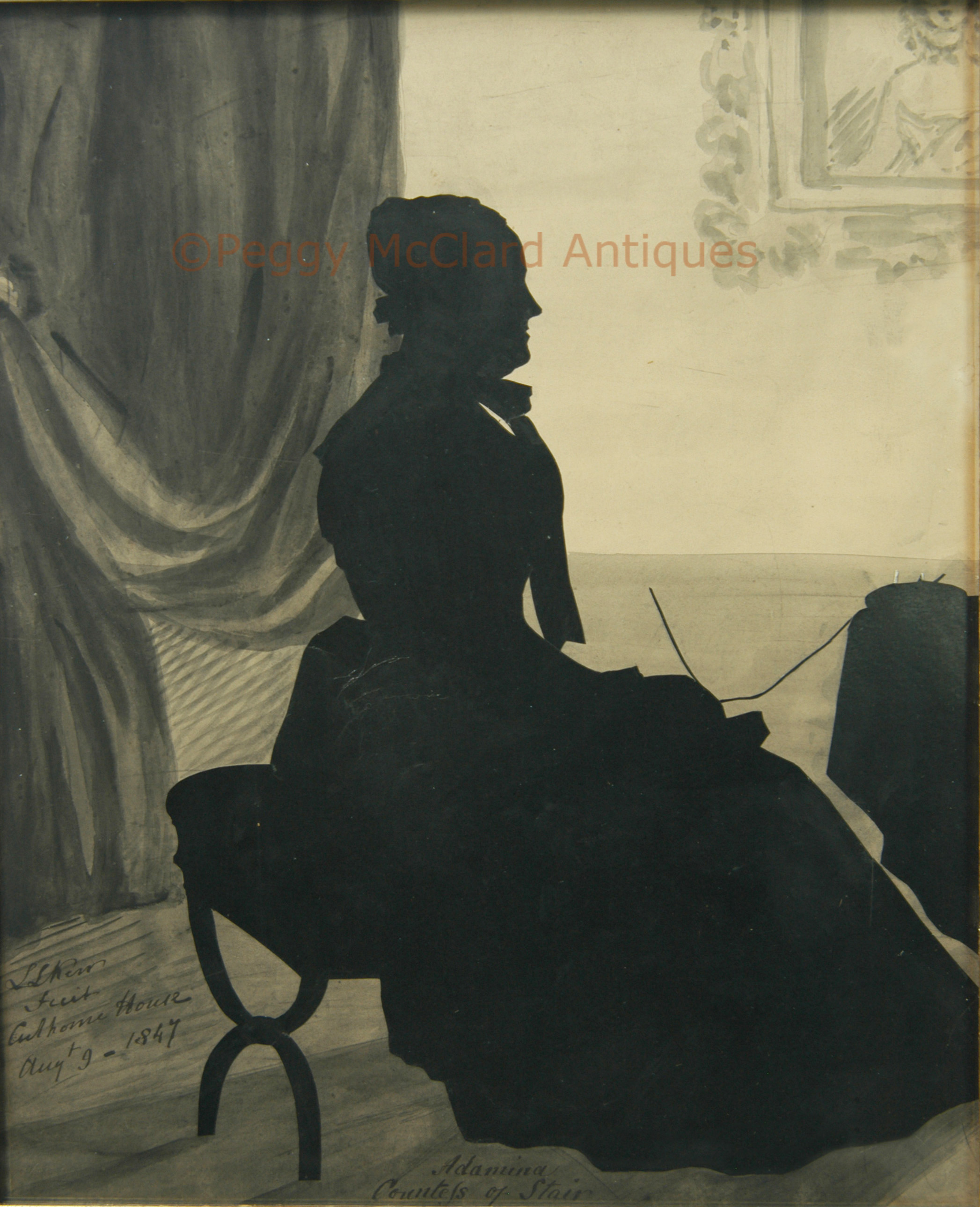
-
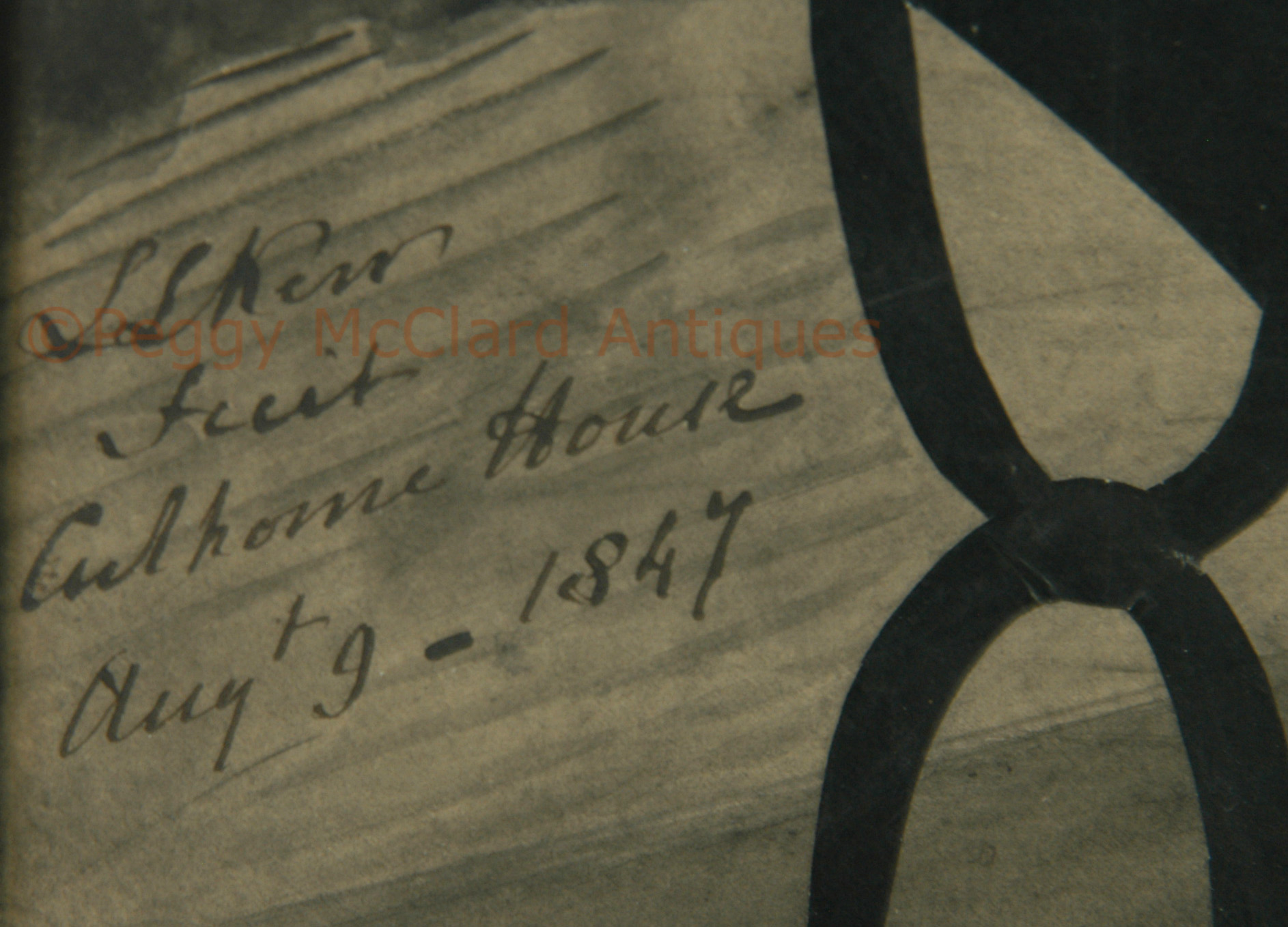 Lady Louisa's Signature
Lady Louisa's Signature
-
 Lady Louisa's Inscription Identifying the Sitter
Lady Louisa's Inscription Identifying the Sitter
-
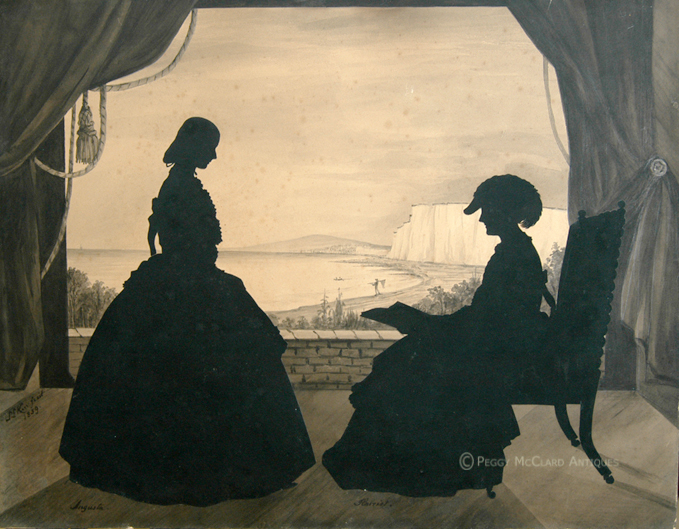
-
-
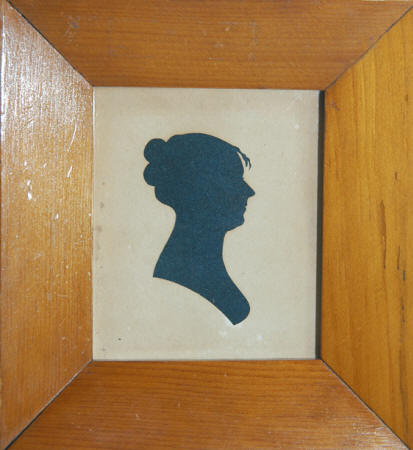
William King (known activity 1804-1806)
William King was a man of many talents but, as some might say, with a wayward disposition. We know King as a cabinet maker, turner, and profilist. He was born sometime in the last half of the 18th century in Salem, Massachusetts. While considered by many to be a genius, he also bore the qualities of a scamp.
In 1785, King was mentioned in the diary of Reverend William Bentley as living with King’s father-in-law, Deacon Phippen. A 1787 diary entry by Rev. Bentley stated:
A William King related to the family of Hodges, Webb, Stone & Mason by their wives, after having been long absent in the West Indies, about four years ago returned, and married a daughter of Deacon Phippen, by whom he had one child & the prospect of another. This W.K. being very capricious left his family, without any warning wrote a letter of his intentions to abscond, without be pressed for debt, or other visible reasons. He was pursued, apprehended near East Haven in Connecticut, by the owner of his Sulky & Horse, gave his note for 16 pounds damage, and has returned again after a fortnight’s absence.
Alice Van Leer Carrick, Shades of our Ancestors, pgs. 46-47.
In 1789, King was apparently still living with his family since he was advertising in the Salem Mercury as an ivory-turner selling canes, dice, backgammon boards, billiard balls and the like.
Then in 1796, Rev. Bentley wrote:
News from Philadelphia, that Wm. King, belonging to a good family in this Town, after having dragged his family from Town to Town, left a note that he meant to drown himself and disappeared. It is supposed that he means to ramble unencumbered. The family are to return to Salem.
Through known advertisements, it appears that King began cutting profiles around 1804. In that year, his advertisements also mentioned his turned works of ivory, wood and iron. In 1805, King advertised in Boston and no longer mentioned his turnings. In 1806, he was in Hanover, NH and claimed to have cut more than 20,000 silhouettes in Salem, Newburyport, Portsmouth, Portland and all of their adjoining towns.
Despite King’s boast of cutting so many silhouettes, examples are difficult to find and much sought after. In her important book Shades of Our Ancestors, Ms. Carrick called him one of her favorite hollow-cutters. As she said, King had a knack of “seeing people agreeably.”
-
-
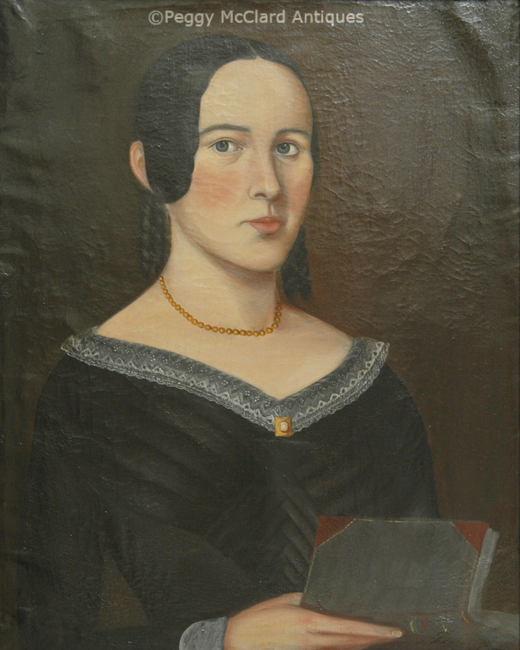
Joseph H. Knowlton (June 21, 1821 – February 2, 1880)
We know little about the painting career of J.H. Knowlton. We know that his father, Joseph Knowlton was born to Thomas Knowlton and Betsey Giles on January 27, 1794 and married Susan Dearborn. Joseph Senior’s father, Thomas, was born in Kensington, Massachusetts and served in various companies of the Revolutionary army as private, sergeant, ensign and lieutenant. Joseph Snr. was a soldier in the War of 1812 and he died on May 31, 1865. His wife, Susan was a descendent of General Dearborn who served at Bunker Hill. Joseph and Susan had 6 children, the first child was named Joseph but died in infancy. They named their second son Joseph H. (we still have not found his middle name). He was born June 21, 1821. Joseph H. served in the Civil War and married Clara Butler. The couple had 4 children, including a son named Joseph who was born in 1857. See Stocking, Rev. Charles Henry Wright, The History and Genealogy of the Knowltons of England and America, The Knickerbocker Press, New York, 1897. 73 & 153. Through a short biography of Joseph Snr. & Susan’s daughter, Julia Knowlton Dyer, we know that Joseph Knowlton (senior) moved his family to Manchester, N.H. in 1839 and was connected with the Land and Water Company for twenty years. See How, Julia Ward, ed., Representative Women of New England, New England Historical Publishing Co., Boston 1904. 127-28.
The 1844 Manchester City Directory lists both Joseph Knowlton living at 4 Machine Shop Block (also says “see A.C. Corp.”) and J.H. Knowlton, “portrait painter”, with an office address of G. Union Building, and his home listed as that of his father, 4.M.S.B. (Machine Shop Block). From this listing and later information, we know that Joseph Snr. & Susan’s son, Joseph H. was the portrait artist. Joseph H. was 23 when he listed himself in the city directory as a portrait painter and at the time period that he painted this portrait. Joseph H. was chosen clerk of the Manchester Fire Department in 1841. According to the Manchester Historical Society, Joseph H. was City Clerk in 1859. The historical society has a political cartoon by Joseph H.
In 1859, The Farmers’ Cabinet newspaper of Amherst, NH printed the following article:
The splendid Flag staff on Merrimack Square runs high up again into the blue ether. The “top-gallant mast” was erected this morning by John H. Maynard Esq., and is mounted by a copper figure of a Fireman, manufactures by Darling & Varney from a design by Joseph H. Knowlton, and gilded with gold leaf, by Capt. J.H. Bruce. It is a natural representation having a speaking trumpet to his mouth, and one arm extended, pointing forward, as if calling to the Firemen to come on, its height is five feet six inches, its weight 28lbs, and was ordered and purchased by the Firemen at a cost of about $100. The perilous feat of placing this figure upon the pole was performed by Frederick Walker, Amos Dow, and Putnam Heath. The staff now, with its figure, is 210 feet high.
The Farmers’ Cabinet, Vol. 58, Issue 5, P. [2], August 31, 1850. See http://www.cardcow.com/75752/firemans-muster-merrimac-common-massachusetts/ for an image of the flagstaff designed by J.H. Knowlton
In the 1860 Federal Census, Joseph H. Knowlton (Knoulton) is listed as a mechanic and still living with wife Clara and 4 children.
Joseph H. enlisted as a private in Company K, New Hampshire 4th Infantry Regiment on October 7, 1862 at the age of 39. In 1865, Joseph H. Knowlton was listed as justice of the peace in Manchester. Lyon, G. Parker, New Hamphire Annual Register 1865, Concord, G. Parker Lyon. 76.
Joseph H. Knowlton died on February 3, 1880 at 58 of consumption. The occupation listed on his death certificate is painter.
"J. H. Knowlton had a studio in Union Block in 1843, and many of his portraits are found among the families of our older residents. He soon drifted into other fields of enterprise, to neglect has native art gift, which was of an unusually high order." Art and Artists of Manchester, Manchester Historic Association Collections Volume IV, Part One, Manchester Historic Association, 1908. 112, Art and Artists in Manchester. Unfortunately, between 1908 when the Historic Association noted that many of his portraits could still be found within old Manchester families and the beginning of the 21st century, almost all of Knowlton’s portraits have been lost. The portrait shown at the left is the only currently known signed portrait by J.H. Knowlton. Additionally, the Manchester Historical Society owns an unsigned portrait which they have attributed to Knowlton based on the characteristics of theportrait shown. Both portraits are registered with the Smithsonian's Art Inventories Catalog. The portrait owned by the historical society can be seen at Knowlton portrait of Miss Alice Moore.
-
-
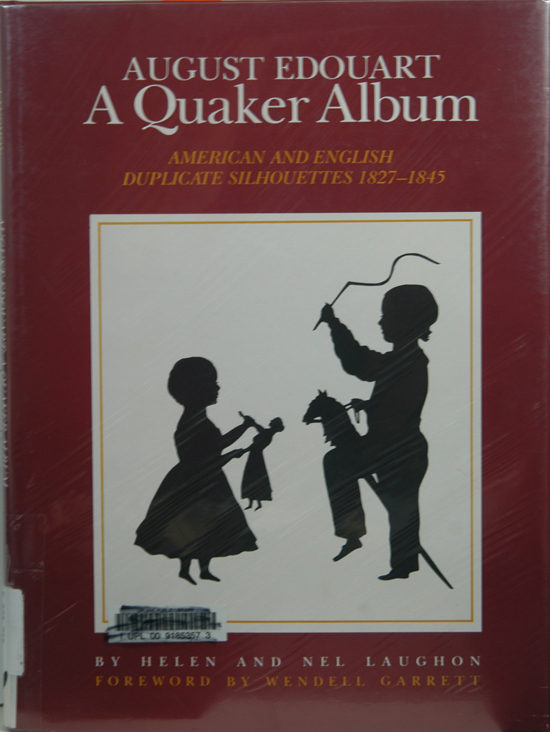
August Edouart A Quaker Album: American and English Duplicate Silhouettes 1827-1845
As those of you who have read my biographies page about Edouart know, Augustin Edouart kept a duplicate of every silhouette that he every cut, placed them in folios with sitters names and dates written below each silhouette and, as Mrs. F. Nevill Jackson discovered in the early years of the 20th century, inscribed the back of each figure with the name and date of the sitter. He used these duplicate folios for his own records and to use as marketing for his profession. In 1849, Edouart boarded a ship to return to England with all of his folios. The ship sank off the Bay of Guernsey and only some of his folios were recovered from the sea floor. He gifted all of the folios that were returned to him to the Lukis family who cared for him after the shipwreck. After Mrs. Jackson purchased all of the folios that were given to the Lukis family, a few continued to surface (apparently "salvaged" by the salvagers who claimed to turn over the lost goods to the proper owners). One such folio surfaced in France and was donated to the Friends' Library, Friends House, London, England in 1969. That folio, artist at that time unknown, eventually made it to the Friends Historical Library in Swathmore, Pennsylvania who showed it to the Laughon sisters. The Laughons immediately recognized the folios as Edouart's work. They wrote this book which has good information about Edouart, the Quakers, and illustrates every silhouette still within the folio after rescue from the ocean floor. This is a fascinating and important book. This copy is in excellent, unmarked condition. The dust jacket is in great condition with a minor amount of wear and a few tiny edge tears. The image that you see to the left is not the copy being offered today. This copy is not ex-library, as the image to the left is. There are no labels on this book. A great copy of a fun book.
(#5162) $35
-
-
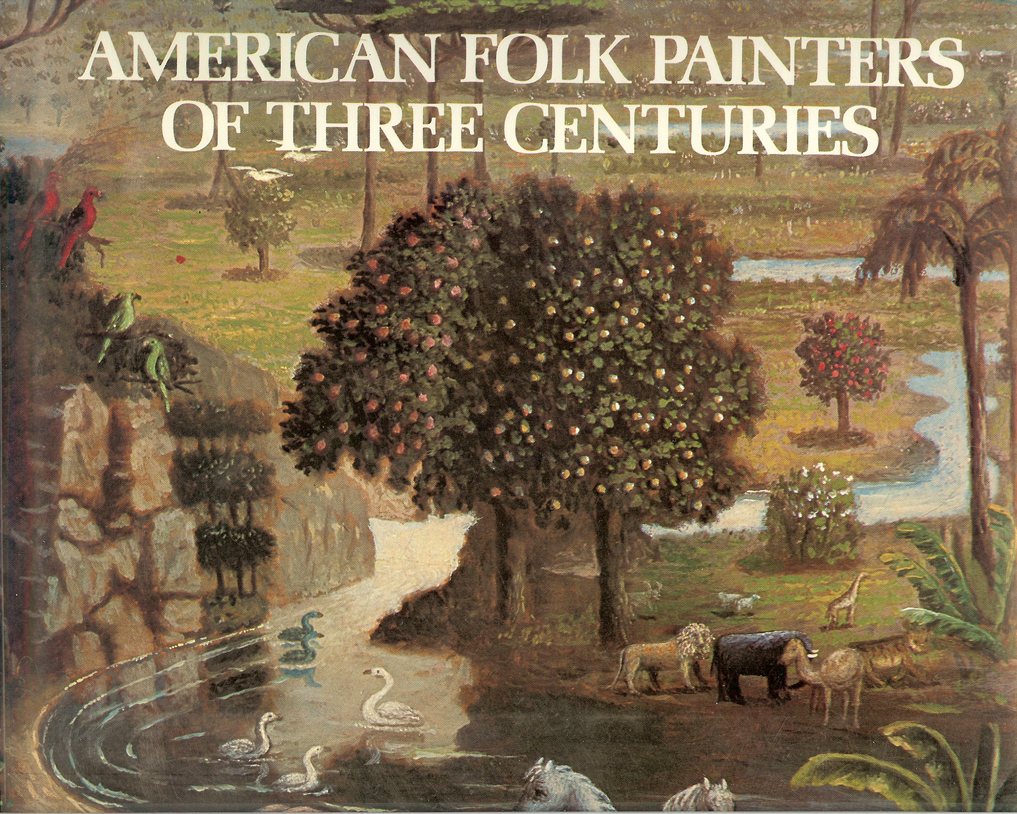
American Folk Painters of Three Centuries
This is a near mint copy of a beautiful and very useful reference book. This great book is divided by centuries and has great color illustrations and biographical essays covering the lives the most important American folk artists of the 18th, 19th and 20th centuries, such as John Brewster, Jr., Rufus Hathaway, Joseph H. Davis, James Sanford Ellsworth, Ammi Phillips, Rufus Porter, and Horace Pippin to name just a few of the 37 chronicled artists. The 150 color illustrations include American folk masterpieces that were included in a major exhibition at the Whitney Museum of American Art. The book also includes additional black & white illustrations of great paintings. This is an indispensable reference and pictorial source for everyone who loves American folk art.
This is a very nice copy, looks like it has never been read. Good tight spine, no markings that I can find inside. The dust jacket is in really good condition except for a long scratch and small scrape at about 9 o'clock.
(#5002) $25
-
-
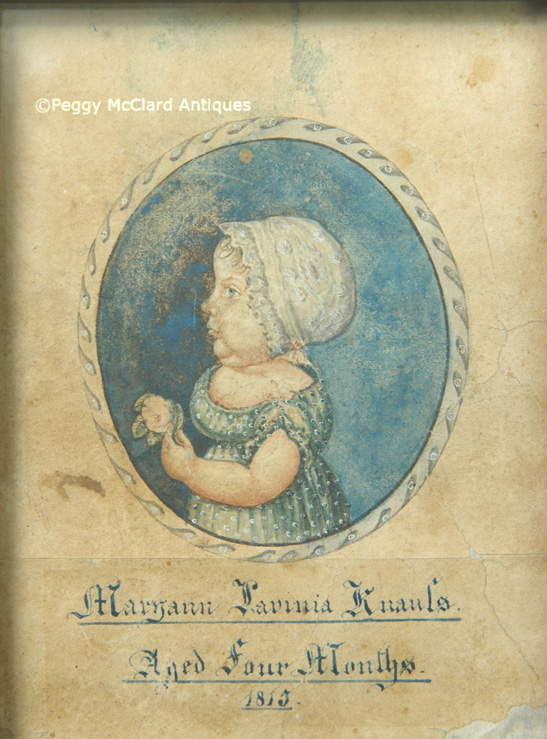
Jacob Maentel (1778-1863)
Johann Adam Bernhard Jacob Maentel was born in Kassel, Germany in 1778. He may have immigrated to Baltimore sometime between his father’s death in 1805 and the appearance of a Jacob Maentel, “Portrait painter,” in the Baltimore directory of 1807. Maentel married Catherine Weaver of Baltimore about 1821, but he had probably already been living or traveling in Pennsylvania by about 1807. Maentel is listed in the 1820 census for Dauphin County, Pennsylvana where he painted many of the citizens standing in grassy landscapes. By 1830, Maentel was living in Schaefferstown, Lebanon County, where two of his children were born and where his name appears with many of his portrait sitters—Zimmerman, Bucher, Haak—in the parish register of the Saint Luke’s Evangelical Lutheran Church. His name also appears until 1833 in the Zimmerman ledger books for purchases of paint and confectioners’ supplies. But by 1838, Maentel is listed in the Indiana tax rolls for New Harmony Township, Indiana, where he continued to portray members of the tight-knit German community, some of whom he had known in Pennsylvania. Jacob Maentel is buried in Maple Hill Cemetery in New Harmony; his undated headstone bears only the initials “J.M.”
Maentel’s identified watercolors date from 1807 to 1846. There are only four known signed examples, including the portrait in the American Folk Art Museum’s collection of a young woman in a blue dress, dated August 31, 1827, and signed “von Jacob Mäntel.” The prolific number of drawings he did during his career provides one of the most important records of early 19th-century rural agrarian America. He did more than 200 portraits and documented the German-American migration to the American Midwest. His work is believed to present fairly accurate likenesses of his sitters even though he was a formulistic artist who often repeated stock compositional devices. His portraits are distinguished by his characteristic detailing of faces, dress, and backgrounds. He used fine and distinct ink strokes to delineate brows and lashes, and heavier watercolor washes to depict drapery and landscape. The watercolors fall into several stylistic categories of pose and setting. The portraits, from about 1810 through 1820, are full-length profile figures set in landscapes and painted against plain backgrounds or dramatic skies. Usually there are tufts of grass in the foreground, and Maentel later began to include architectural structures, fences, and other personal elements of the sitter such as hats, purses, flowers, umbrellas, fans, cats, parrots, and roosters. During this period Maentel also painted some pairs of frontal figures set into colorful interiors. By the mid-1820s, symmetrical companion portraits had become Maentel’s typical presentation, and he continued to reuse these established conventions in Indiana. Throughout his lifetime, Maentel was known as a farmer who was fond of painting.
Maentel's Portraits Exhibited at:
Abby Rockefeller Folk Art Museum
American Folk Art Museum
Fenimore Art Museum
New York Historical Society
Smithsonian American Art Museum
Winterthur Museum
References:
Rumford, Beatrix T. American Folk Portraits Paintings and Drawings from the Abby Aldrich Rockefeller Folk Art Center. New York Graphic Society, 1981. 139-143.
American Folk Art Museum Collection, "Amelia and Eliza Danner" by Jacob Maentel, http://www.folkartmuseum.org/?p=folk&t=images&id=3569
Please view the Maentel attributed portraits currently in stock on the Portraits page.
-
-
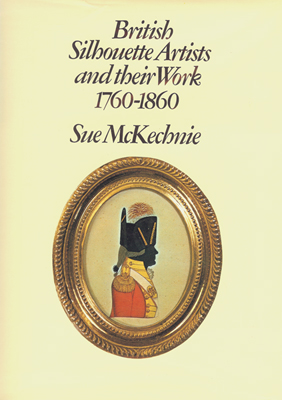
British Silhouette Artists and their Work
This is the Bible of silhouette research....the seminal work....whatever other superlatives can be attached to a reference book.... Ms. McKechnie devoted her adult life to the study of antique silhouettes. This comprehensive book is 799 pages of information and tons of images (it weighs a ton, too). It catalogs every trade label and signature known and recorded at the time of its publication. It discusses individual artists, the history of silhouettes, frames, jewelry, and has a large chapter detailing costumes of the periods (this is my best source for dating silhouettes and portraits). Lucky for us, Ms. McKechnie even devoted a chapter to artists working in America! If you are building a collection of silhouettes, or selling or appraising silhouettes, you've gotta have this book! I apologize in advance for the price. This book as gotten extremely hard to find. I look for months for copies that I can offer at what I finally had to decide was a "reasonable" rate. Believe me, if you are serious about silhouettes, this will be your go-to book. Please also note that the book weighs more than 8 pounds and will be costly to ship....but it is really, really worth it!
This is an ex-library copy with a clear mylar cover over the original dust jacket. The dust jacket is in good condition but the mylar cover has a 2" x 3/4" tear on the back. The mylar cover also has some soiling along the upper left side of the cover at the spine. The dust jacket, itself, has a dent along the spine. The book is in excellent condition and appears to have never been checked out from the Liverpool library from which it came and little, if ever, read. Spine is tight, pages all good and tight. There is soiling at the edge papers, especially at the lower right edge. Inside the front cover is the library's stamps and check-out paper. This is a very good to excellent copy of a monumental book.
(#5095) $365
-
-
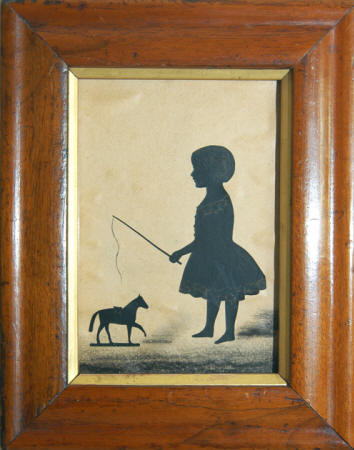
AttributedMerryweather (active circa 1850)
Little is known about the artist Merryweather. The rare examples of his or her work shows that Merryweather cut silhouettes in black paper against a watercolor wash base composed of concentric circles. The figures are lightly brushed embellishment of gold. Children are represented with toys or baskets of flowers. Mrs. F. Neville Jackson mentions a trade label, but does not give detail. Sue McKechnie states that the Merryweather in her collection had a handwritten inscription, "By Merryweather, Profilist" on the verso. She also tells us that the silhouette illustrated in her book (extremely similar to the figure shown here) bore the handwritten inscription, "Cut by Merryweather, Profilist".
-
-

Samuel Metford (1810-1890)
Samuel Metford was born in 1810 to a Quaker family in Glastonbury, Somerset, England. He moved to America around 1834 and became a naturalized American citizen. Metford seems to have centered his profile cutting in Connecticut although he is also known to have worked in New York and South Carolina. He likely also plied his trade in other states. Metford continued working in until 1844 when he moved back to England. He made two more trips to America in between 1865 and 1867. It is unknown whether he cut profiles during the later trips to America as no examples have been found that appear to date to the 1860s. Most books list the date of Metford’s death as 1890. However, Sue McKechnie states that Metford died in 1896.
Although Metford generally placed his cut & paste silhouettes on watercolor wash backgrounds, some examples have been found with lithograph backgrounds. He signed his silhouettes as either “S. Metford” or “Sam’l Metford.”
Metford’s work is sought for its rich embellishments which he perfected to a much greater degree than most 19th century silhouettists. He embellished his silhouettes in either gold, Chinese white, or yellow-ochre watercolor.
-
-
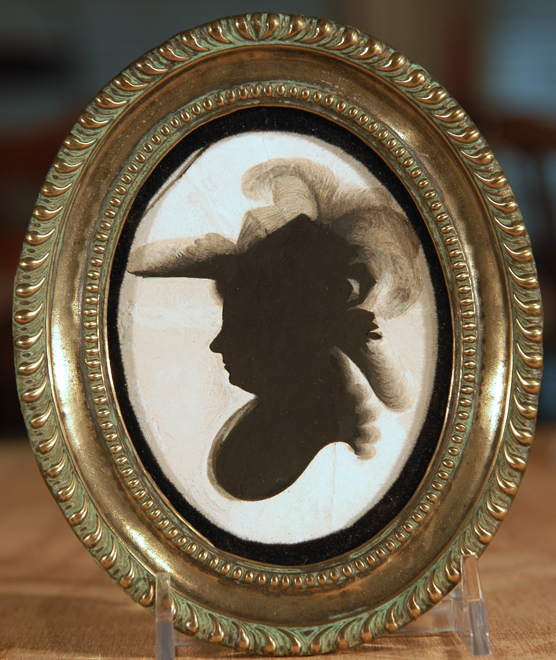
John Miers (1758-1821) and John Field (1772-1848)
John Miers is considered the finest silhouettist of the 18th century. Miers’ father was a painter by trade, having purchased a business which did “Coach Painting and Undertaking for Funerals in general as usual.” Although the young Miers helped his father in the business, there is no evidence that this artist who is considered one of the greatest profilists in the history of art ever received formal artistic training. His painted silhouettes on plaster or ivory are prized by astute collectors.
In 1781, the young, recently married Miers began his own business as a painter, gilder, and profilist in Leeds. He advertised that he took “Most striking Likenesses taken in One Minute upon an entire New Plan.” After 5 years of advertising his “new Method” or “Peculiar Plan (which is allowed superior to any other in the Kingdom),” Miers hit a snag when he discovered that Miss Mary Lightfoot, the daughter of one with whom he had lodged had traveled to Scotland and attempted to establish herself as a profilist by copying his techniques. He fought against Miss Lightfoot’s theft with a very explicit advertisement condemning her activities. It appears that his advertisement worked, as Miss Lightfoot seems to have disappeared from the scene.
In 1791, Miers began using the trade label which backs the offered silhouette and is known as “Trade Label No. 11.” This label was used from 1791 until c. 1810. When Trade Label No. 11 came into use, Miers ceased to be the only artist working under his name. In fact, most of the silhouettes of this period were painted by others.
During this period, John Field began working for Miers. Field proved to be the most talented of the silhouettists working under Miers and by 1823 Miers son, William, and Field became partners in the studio of Miers and Field.
Field’s silhouettes are distinctive in the transparency of the ruffled areas of the sitter’s clothing and by the characteristic dip at the back of the curved bust-line. These features would remain a distinctive quality in Field’s work for the rest of his career. Later in his career, Field painted silhouettes on card with great flourish, detail and bronzing. While working for Miers, however, his silhouettes on plaster were in black with white added only for transparent detailing at the edge of the silhouettes, or light bronzing on silhouettes painted on ivory.
-
-
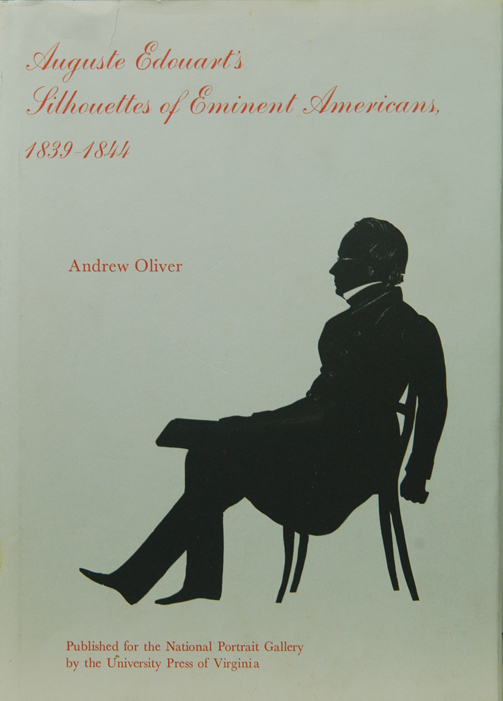
Auguste Edouart's Silhouettes of Eminent Americans, 1839-1844
This book chronicles the only known folio by Edouart that includes lithograph and watercolor backgrounds. The folio appears to be Edouart's duplicate work, but this folio does not appear to have been water damaged (or to have gone down with the ship in 1849). The folio first appeared in 1923 when it was sold to an individual collection in New York. The company selling the folio is said to have acquired it in Paris. The folio contained 91 pages of silhouettes, using 25 different lithographed backgrounds. It contains the most important Americans that he cut, including 4 presidents, 5 Supreme Court justices, 6 state governors, 6 college presidents, 18 mays and at least 29 physicians. It is thought that this unique folio was used to preserve Edouart's personal records and as a marketing took to show a prospective sitters the vast array of prominent sitters he had cut as well as examples of lithograph and watercolor backgrounds from which they could choose. Andrew Oliver put together this beautiful book illustrating every silhouette within the folio and giving short biographies of the important Americans depicted in its pages. This copy of the book is in excellent condition with two tears to the dust jacket. The tears are repaired from the inside with archival linen tape, but the tear to the back of the dust jacket was a little accordianed and I could not straighten it out completely during the repair. However, it looks good and its a really stunning book.
(#5159) Sale Pending
-
-
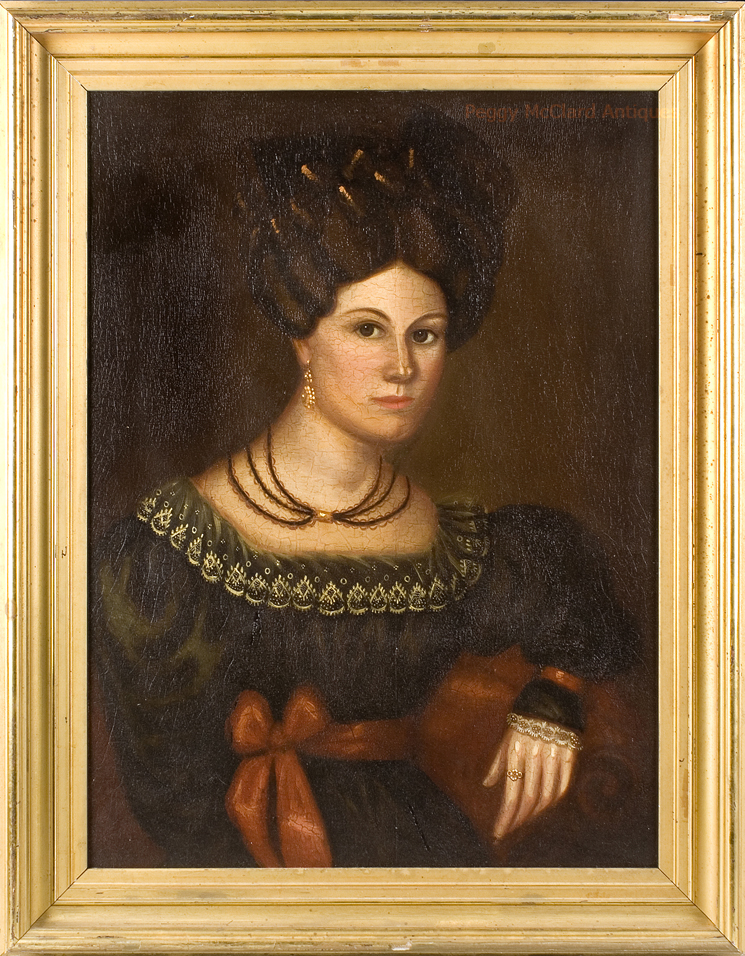
Susannah Paine (1792-1862)
Susannah (sometimes spelled Susanna) Paine was one of the pioneering women artist of 19th century New England. She was born in Rehoboth, Massachusetts to a mariner-father who was lost at sea while she was still a young girl. Paine attended what she referred to as Rhode Island's best girls academy where she was exposed to the art that would later become her professional pursuit. At her mother's urging, she married James Phillips of Providence in 1819, a man she described as a "taunting, sneering surly tyrant...who enjoyed burning bibles when angry." Their union lasted only 14 months, but before their separation, Paine conceived a child. Her son was born 3 months after her separation from Phillips. She was granted custody of her son in a divorce, but Phillips got all of her property, leaving her destitute. Her son died at eleven months of age.
In 1823, at the age of 32, Paine began to travel as an artist. She developed a clientele of women who were proud of having their portrait painted by a woman artist. A letter in the Portland Advertiser in 1827 recognized Paine's portraits and boasted, "Ladies must feel pride and pleasure in patronizing a female artist."
On December 12, 1826, Paine placed an ad in the Portland, Maine newspaper which read:
PORTRAITS. Miss S. Paine respectfully informs the public that she has taken a room at Mrs. Pritchard's in the new Brick Block, Freestreet, for PORTRAIT PAINTING---her former successes in Providence, where she has been liberally patronized, inspire her with confidence to solicit patronage; as she anticipates a very short stay in Portland, she will put her Portraits at a very reduced price, and will engage to make them to entire satisfaction, or receive no pay---those who will favor her with their patronage will please apply very soon. Price-Oil pictures, $8.00. Do Crayons, $4.00.
Susannah Paine was active in New England, especially Rhode Island and Maine. To improve her artistic endeavors, she took art training at the Boston Athenæum around 1832. She was a good hearted person who raised a young girl whom she referred to as her adopted daughter and rented an apartment for her mother and stepfather when she found that her half-brother had obtained the deed to her parents' property and had them living in what she referred to as an "sort of out-house".
Her work is noted for appealing detail of her subjects such as ornate dress and coiled hair dos, she painted primarily with oil on wood but did an occasional pastel portrait. Her works reside in the collections of the Maine State Museum, Portland Museum of Art, Rhode Island Historical Society, and the Cape Ann Museum. In 2011, a pastel portrait signed by Paine sold for $32,500 ($38,513 including buyer's premium).
References:
Payne, Michael and Suzanna Rudnick, "Roses and Thorns: The Life of Susanna Paine", Folk Art Magazine, Winter 2005/2006, pp. 62-71.
Payne, Michael and Suzanna Rudnick, "A Woman Can Paint a Likeness?", The Magazine Antiques, January 2009.
"Selected Works by Susannah Paine", Cape Ann Museum online.
"A City Awakes -- Arts Flourish in Portland", Maine Memory Network, Maine Historical Society online.
Portrait of George Morillo Bartol, Skinner Inc. online archives, American Furniture & Decorative Arts - Sale 2538B - Lot 52.
"Susannah Paine (1792 – 1862)", American Gallery, Greatest American Painters
Please view the Paine attributed portrait currently in stock on the Portraits page.
-
-
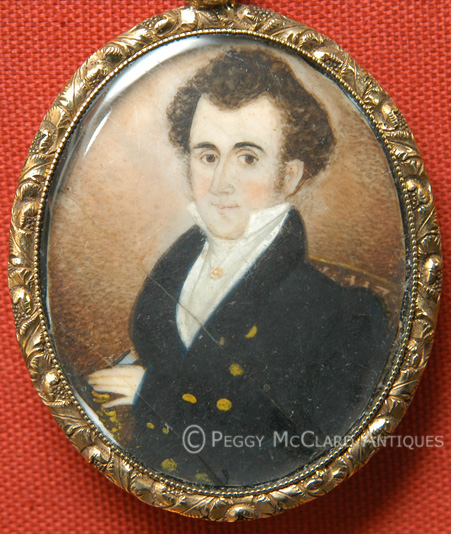
Abraham Parsell (1791-1856)
Abraham Parsell was born in Neshanic, New Jersey on June 17, 1791. He married Mary Richards in Essex Country, NJ on March 23 1819. The had three children, but only one, John H., survived.
Although the more common practice for portraitists of the early 19th century was an itinerant practice, Parsell moved his family to New York City where he competed with academically trained artists. He shows up in the New York City directories, listed as a miniature painter, as early as 1820. He continued to prosper as a miniaturist in New York City for at least 36 years....he must have been well-thought of by his clientele.
Parsell's early work is noted for the lack of hands and props and the more subtly colored, less complex backgrounds. Later works are distinguished by his use of "long, elegant fingers, pronounced eyelids, and penetrating eyes, set against a stippled background." Sitters often hold a book or rolled newspaper or document, eyeglasses and, rarely, a family pet. Sitters' clothing is stylishly depicted, often with elaborate jewelry and hairstyles. Backgrounds of many later portraits "have a dramatic sunset appearance, with clouds of blues, oranges, and pinks. Shades of brown stippled pigment are often included in the background either alone or in conjunction with the atmospheric clouds."
Parsell's later portraits show his good understanding of ivory as a medium. He took full advantage of ivory's translucence by painting areas of the back of the ivory in shades of blue, reddish brown, and orange to produce muted tonalities on the front of the portrait. He scored the ivory surface with a group of barely visible lines to secure the paint. He is also known for the use of gum arabic to highlight the clothing and sitter's details.
Interestingly, Parsell, who died on February 10, 1856 at 65 years old, left several will codicils because he couldn't seem to decide whether or not to leave all of his money and property to his wife if she remarried. His last codicil left her the money and property, but with restrictions if she remarried. Poor Mary did not remarry, living 17 more years
DiCicco, Vincent and Fertig, Howard P., "Abraham Parsell, Miniature Painter", Antiques & Fine Art (8th Anniversary Issue). (Online article found at antiquesandfinearts.com).
-
-

Charles Willson Peale (1741-1827) and Moses Williams (1777-about 1825)
Charles Willson Peale, born in Chestertown, Maryland, is perhaps the most famous of the American-born profilists, and certainly known as a jack-of-all-trades. Known as the “Artist of the Revolution” he is most well known for his wonderful oil portraits of the most important of our country’s ancestors, including George and Martha Washington, and Revolutionary War General Horatio Gates.
Peale was a saddler, harness-maker, clock and watch-maker, silversmith, artist in oils, crayons, wax, and miniature. He was a soldier, legislator, lecturer, taxidermist, and dentist. He married a succession of wives and had children with all of them. A true artist, Peale named his children after artists who had blazed the way before him: Raphael, Rembrandt, Rubens, Titan, and Van Dyke were the names of some of his sons.
Peale opened his Museum of Natural Science and Art in Philadelphia in 1795. The prehistoric bones, taxidermy animals, and plant life that he exhibited became so popular that he was forced to find larger quarters for his museum twice. In 1802, Peale moved his popular museum into the second floor of Independence Hall. Here he added a silhouette business which used a physiognotrace patented by his friend John Hawkins to make hollow cut silhouettes. The majority of the silhouettes from the Independence Hall museum are stamped with the embossed signature “MUSEUM.” Less common is “PEALE'S MUSEUM” stamped above the form of an eagle (please see the note below about spotting fake "PEALE'S MUSEUM" silhouettes. The rarest of the three stamped signatures used by Peale is “PEALE.” We are unsure of the dates in each of the stamps were used nor of which is his eventual three museums, run by his sons, used the scarcer two. It is thought that Rembrandt Peale may have used the "PEALE" stamp at the separate Baltimore museum. Raphaelle Peale also cut silhouettes in Virginia and must have used one of these stamps.
While living in Maryland, Peale acquired a mixed-race slave couple, probably as payment for a portrait commision. According to law which he helped to pass, Peale freed the couple when they turned 28. Their 11 year old son remained bound to the Peale family , which, of course, kept the parents also bound to Peale. Peale took the young slave, Moses Williams, into the family home and treated him almost like another son. Interestingly, Peale could have emancipated Moses early, but chose to keep control over him--much like he kept control over his son's lives throughout their adulthood.
Moses Williams was taught the art of silhouette cutting. Under Peale’s supervision and tutelage. Williams cut most of the silhouette that are signed “MUSEUM.” While many people assume that the silhouettes of statesmen cut during this period were done by Peale himself, Rembrandt Peale once said that Williams' business was so extensive that he amassed two barrels full of blockheads "among which were frequently found, by careful search, the likenesses of many a valued friend or relative, and sometimes of distinguished personages -- another source of profit to him." Rembrandt Peale, Notes and Queries. The Physiognotrace (1856), 308. Peale was fiercely defensive of Williams against any prejudices of museum visitors and credited the physiognotrace’s reputation for correct likeness in part to the “perfection of Williams’ cutting.”
Peale emancipated Williams in 1802, when he was 27. Earning a mere 6 to 8 cents per silhouette, Williams eventually bought a two-story house. He married the Peale family's white cook (who would not let him sit at the table with her before his emancipation) and together they had a daughter. He continued working managing the Philadelphia silhouette cutting business until his retirement. Williams is remembered as one of the earliest known African-American artists in the United States.
Spotting fake "PEALE'S MUSEUM" silhouettes:
The most faked silhouettes in the world have the impressed signature "PEALE'S MUSEUM" under a spread eagle. That is because, in the early 20th century, a couple of unscrupulous antiques dealers named Collins found the original stamp. They set about making horribly cut fakes and stamping them with what had been one of the most rare of stamps from Charles Willson Peale's Museum. The fakes are easy to spot (although they come up for sale all the time as original pieces). First, the silhouette cutting is sloppy and the subjects are quite often George Washington and other great statespersons. Second, the paper used by Peale's real tracing machine was 3 1/2" x 4 3/4". The size of Peale's paper could not vary because his tracing machine was set up to hold a 3 1/2" x 4 3/4" piece of paper and automatically reduce the size of the profile while it was being traced around the actual person. The fake silhouettes are on paper that tends to be 6" x 8"....it is impossible that this size paper was used in Peale's tracing machine. Last, the impressed signature stamp for the real silhouettes sits right below the bust line termination....it had to because the paper was not much bigger than the actual cut profile. The impressed stamp on the fake Peale's sits well below the bust line termination....in an apparent effort to even out the extra expanse of blank space created by such a large piece of paper (even though the figures were cut much larger than the real Peales). The fake Peale's Museum silhouettes are very predominant in the market while the real ones are quite scarce.
Please view the Peale Museum silhouettes currently in stock on the Silhouettes page.
-
-
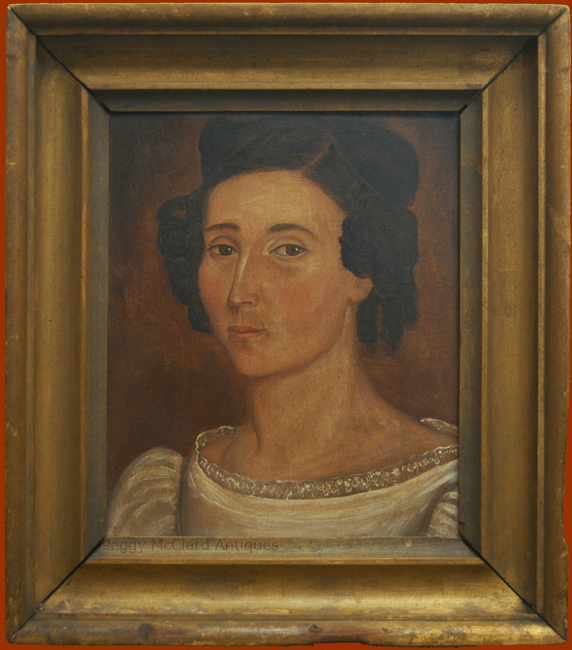
Sheldon Peck (1797-1868)
Sheldon Peck was born in Cornwall, Vermont on August 26, 1797 to Jacob and Elizabeth Peck. Jacob Peck had fought in the Revolutionary War and was one fot eh first settlers of Cornwall, Vermont. Sheldon Peck married Harriet Cory on September 15, 1824. Together, Sheldon and Harriet would have ten children.
He was a self-taught itinerant portrait artist who never signed his work. His earliest portraits, painted in Vermont, appear to be executed according to a formula worked out in an attempt to catch a likeness in a brief period of time. During this time, Peck elaborated on his sitters' coiffures and dress by painting curls, lace-trimmed collars and bonnets, and gold buttons. A decorative motif that reappears throughout the artist's career is a series of brushstrokes often called a rabbit's foot--a long stroke, flanked by two shorter ones. Peck used this decorative motif in the elaboration of lace and other decorative elements of the sitter's clothing. By 1828, Peck and his family had moved to New York. During his New York Period, Peck executed half and three-quarter length portraits on wood panels as he had done in Vermont. However, his New York palette was brighter and the portraits more detailed in their execution. These large portraits were often embellished with draperies, painted furniture and other accessories. On November 9, 1836, the Onodaga Standard newspaper published an announcement by Hezekiah Gunn saying, "Be it known to all people, taht one Sheldon Peck, and Harriet his wife, not having the fear of God before their eyes, being instigated by the devil, have with malice aforethought most wickedly and maliciously hired, flattered, bribed or persuided my wife Emeline, to leave me without just cause or provocation. It is supposed that said Peck has carried her to some part of the state of Illinio. This is therefore to forbid all persons harboring or trusting my wife Emeline, for I will pay no debts of her contracting." About the time of this published announcement, the Pecks moved abruptly to Chicago. Some have speculated that the Pecks were Mormons and that Mrs. Gunn left her husband to practice polygamy, but this conjecture is without substantiation. There was a great economic panic in 1837 that left less people willing to pay for large elaborate portraits. Peck's Chicago Period seemed a return to his simple Vermont style so that in an era of financial depression, he could reduce his prices. The Chicago portraits are painted on canvas which was probably more accessible to him and certainly took much less time to prepare than did his wood panels.
Sometime around 1837, Peck moved his family twenty miles west of Chicago to a town called Babcock's Grove (later changed to Lomard), where he became a respected farmer, community leader, landscapt painter, photographer, founding member of the Chicago Academy of Design. The 1840 census lists Peck as a farmer. His portrait painting business must have gotten better because the 1850 census lists his occupation as a portrait painter. Peck probably farmed during the summer and traveled as a painter during the winter. His work from this period are often full-length and sometimes include several likenesses on a single canvas. His pallet was brighter and many portraits feature bright reds and yellows. He sometimes avoided the additional expense for framing by painting a trompe l'oeil graned frame directly on the canvas. His later style developed to compete with cheaper daguerreotypes that were being offered at the time. While many itinerant portraitists of the day attempted to refine their technique by deliberately trying to paint more realistically to compete with photography, Peck chose the opposite approach. He appears to hav hosen to paint in a simple style that would appear to relatively unworldly clients. Peck chose his style and went to the frontier to find people who would appreciate it instead of setting up in a metropolitan area where the most sophisticated clients could be found. Peck died on his farm on March 19, 1868 of pneumonia
Bishop, Robert, Folk Painters of America. E.P. Dutton, New York, NY. 1979. 192-205.
Lombard Historical Society, "Who Was Sheldon Peck?", http://www.lombardhistory.org/who_was_peck.htm.
Please view the Sheldon Peck attributed portrait currently in stock on the Portraits page.
-
-
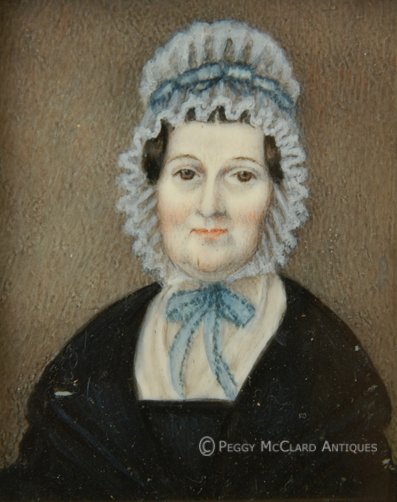
Clarissa Peters (Mrs. Moses B. Russell) (1809-1854)
Clarissa Peters was born in North Andover, Massachusetts to Elizabeth Farrington Davis and John Peters. She was fifth of twelve children born to a family that had been prominent in local affairs for generations. Even though there are no records of Clarissa's early training, it is assumed that Clarissa attended Franklin Academy (the first incorporated school in Massachusetts to admit young ladies) because her younger sister Emily attended the academy from 1836 to 1838. Another sister, Sarah Peters Grozelier also became a miniature portraitist.
Clarissa's earliest known artistic endeavor is a beautifully decorated friendship album that is among a collection of other family papers at the North Andover Historical Society. Entries in the album date from 1829 to 1832 and include twenty-two delicate watercolor floral and foliate vignettes that show her eye for detail, color and composition.
In 1835, Clarissa was living in Boston painting miniatures as well as giving lessons in art. While in Boston, Clarissa met and, in 1839, married her mentor Moses Baker Russell. Clarissa and Moses worked closely to expand their successful miniature portrait business. Clarissa's work closely resembles the work of her husband and there is speculation that they worked together on many pieces--a practice that was not uncommon among artists of the era.
Clarissa first exhibited her work in 1841 at the Third Exhibition of the Massachusetts Charitable Mechanic Association in Boston. Several works by her husband were also included in the exhibition. The Boston Daily Mail printed the following laudatory comments about the Russell's work:
Mr. R. has four Miniatures on exhibition, and his wife three. They are all very beautiful. . . . . Mr. Russell is a very talented and successful artist, and his wife paints the likeness of a lady with much accuracy and beauty of coloring. Their contributions to the Anthen æum have been much admired -- but their extensive practice, and general success is the best test of their talent.
Clarissa shared a studio with her husband at the centrally located Boston address of 21 School Street from 1840 to 1851. The Russells were active in the artistic life of Boston and participated in many local exhibitions. As a result of their hard work and great talent, their practice was quite successful during a time when people were moving away from portrait painting in favor of the cheaper and more easily obtainable daguerreotype. The front page story in the Boston Evening Transcript of her death in 1854 is testimony of Clarissa Peters Russell's place among the respected artists of Boston.
Despite the similarities to the work of her husband, Clarissa's work is "quite distinctive: charming, somewhat naïve likenesses of their subjects who are almost always women and children." Her subjects have oversized limpid eyes with eyelids and irises heavily outlined, making the eyes the most prominent feature. The mouth is small and seems a bit pinched in relation to the large eyes. She generally set off the mouth with small marks at each corner and a shadow below the lower lip. Clarissa generally used a frontal pose of the head and shoulders (sometimes she used three-quarter lengths for children), placing the subject close to the picture plane to create a sense of immediacy with the viewer. The pale skin tones that she used contrast with the deep shades of fabrics. She used a hatched, striated background for which she favored grey green and purple backgrounds but also used unique combinations of the colors brown, pink, green, light blue, and white. Clarissa Russell almost exclusively painted children or women. She almost never signed her work. When she did sign, she most often used the moniker "M.B. Russell", showing the great influence that her husband had on her career and attributing to the decades of misattribution of her work to her husband.
In 1842, the Boston Almanac listed twelve miniature painters. By 1854 only one was listed, Mrs. M.B. Russell. The fact that she was the lone survivor in a world that had turned away from hand painted portraits for the daguerreotype demonstrates that she offered the public something the photograph could not.
Holton, Randall L., "Mrs. Moses B. Russell Boston Miniaturist - Bibliography", The Magazine Antiques (December 1999) (online article found at http://findarticles.com/p/articles/mi_m1026/is_6_156/ai_58468287)
Johnson, Dale T., American Portrait Miniatures In The Manney Collection. The Metropolitan Museum of Art, New York, 1990. 196-98.
Please view th Clarissa Peters portrait currently in inventory on the Portraits pages
-
-
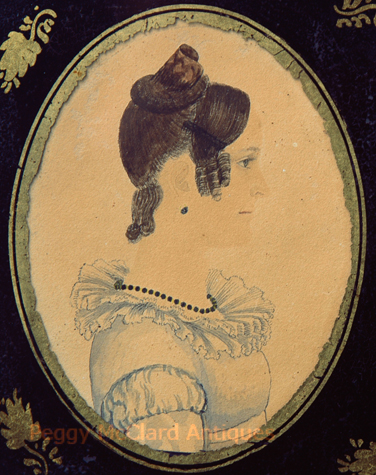
Rufus Porter (1792 – 1884)
Itinerant artist and scientist, Rufus Porter, with a fascinating individual. He painted wall murals, and portrait miniatures, cut silhouettes, authored and published several scientific magazines during the majority of the 19th century. Porter was born in West Boxford, Massachusetts in 1792 to a prosperous farmer. Porter’s father moved the family, which included seven children. Rufus Porter’s higher education consisted of six months spent at the Fryeburg Academy when he was 12. Subsequently, Porter worked as a farmer and in amateur fiddler until, at the age of 15, his family decided “it would be best for him not to settle any longer” so he apprenticed as a shoemaker. Unhappy with this trade, Porter walked to Portland, spent three years playing fife for military companies and violin for dancing parties. His life as an artist began as a house and sign painter and a painter of gunboats, sleighs, and drums. He taught school, built wind driven grist mills, copyrighted a music instruction book, and then began portrait painting. At some point before 1817 Porter ran a dancing school. According to legend, Porter joined the crew of a ship on a trading voyage to the Northwest Coast and Hawaii. He married Eunice Twombly in 1815. Together they had 10 children. Throughout his marriage, Porter continued his nomadic ways, leaving Eunice to manage the home and raise the children. Eunice died in 1848. In 1849, Porter remarried a girl in her 20s and fathered six more children, still continuing his itinerant career. Porter continued to travel nonstop until 1884, when at the age of 93 he was suddenly taken ill and died while visiting a son.
In 1825 Porter published a book called A Select Collection of Valuable Curious Arts and Interesting Experiments, an art instruction manual giving the amateur artist quick and easy recipes for various types of artwork. This book included a section on “landscape painting on walls of rooms” describing in detail his method of painting wall murals for which he is now so famous. Porter’s attitude towards expediency in all things reminds me of me. Porter painted very detailed small watercolor portraits with great speed and creativity, never dallying over anyone piece of work. He used a camera obscura to help quickly draw the profiles for his silhouettes in painted miniatures. Curious Arts also included instructions on how to build and use the camera obscura. Porter’s highly detailed but quickly painted watercolor miniatures are highly collected and very desirable to 21st-century collectors of American folk art. Unfortunately, we have no silhouettes which can be attributed to Porter, because it appears he never signed them. However, we do know that he offered hollow cut silhouettes through his handbills and advertisements. The overwhelming majority of his watercolor miniatures are not signed. Using the few signed miniatures so far found, we are able to attribute miniatures on the basis of Porter’s style. Among Porter’s signature portrait characteristics are the following: 1) the opening of the ear canal painted the shape of a tiny heart with a striking apostrophe curving up word from the canal opening; 2) eyes painted with an ovoid – shaped, outlined iris, a shaded eyelid, and a vertical stroke that forms the pupil instead of a more typical round dot; 3) transparently painted watercolor which, often leaves skin tones difficult to discern after almost 2 centuries of paper oxidation; 4) darker skin tone for men than women; 5) shaded graphite skin tones on top of the painted flesh; 6) eyebrows on profiles often extending to the edge of the forehead; 7) a painted brown line separating the lips; and 8) a straight foreword gaze by the sitter. Porter minutely detailed the hairstyles of his sitters with a fine, probably single – haired, paintbrush which he referred to as a “hair pencil”. His garments are delicately painted in watercolor which sometimes is so finely detailed that it appears to be ink. When the portrait miniatures were painted in an oval format, removing them from the frame often shows that Porter tested his watercolor colors on paper edges that would be hidden by frame or verre églomisé glass mat.
References:
Anderson, Marna A Loving Likeness American Folk Portraits of the Nineteenth Century, (Bristol-Myers Squibb Co. (1992), 32-34.
Lefko, Linda Carter & Radcliffe, Jane E., Folk Art Murals of the Rufus Porter School, New England Landscapes 1825-1845,Schiffer Publishing Ltd., Atglen, Pennsylvania, 2011.
Lipman, Jean, Rufus Porter Rediscovered, Clarkson N. Potter, Inc., New York, 1980.
Please view the pair of Rufus Porter attributed portrait currently in stock on the Portraits page.
-
-
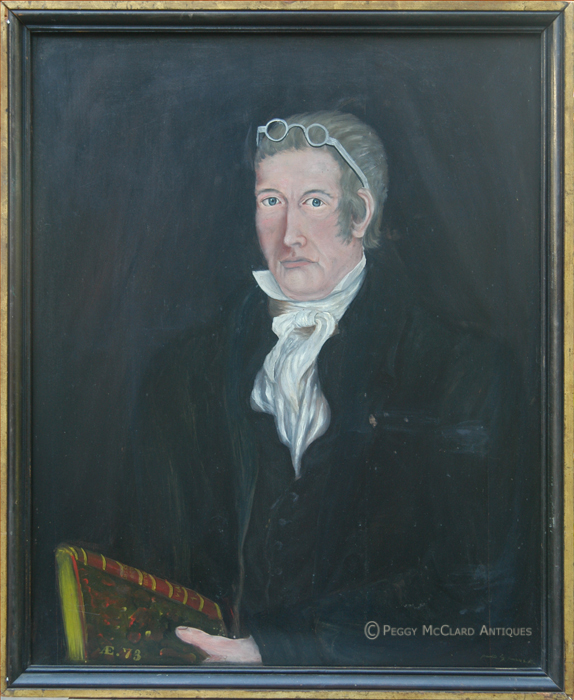
Asahel Lynde Powers (1813-1843)
Asahel Lynde Powers was the first of seven children born to Asahel Powers, Jr. and Sophia Lynde Powers. He was born February 28, 1813 in Springfield, Vermont. By the young age of 18, Asahel had already begun his career as a portrait painter. The earliest dated portrait known Powers' portrait is dated 1831. He spent the next decade of his life traveling throughout Vermont and neighboring states as a successful itinerant portraitist. Powers' early work is rich in colorful detail and strong facial delineation. "The heavy shadowing of the features, the absence of modeling and highlights, and an obvious unfamiliarity with the elements of anatomy and perspective are notable attributes which, to most observers, represent the key features of Powers's earliest and most powerful style."4 Like most folk artists of the early to mid-19th century, Powers delighted in painting costume details and working with his strong sense of decorative design. "Powers was innovative, imaginative, and experimental."5 He tried new backgrounds and color effects throughout his career and his compositions show a definite progression toward more accomplished styles. His use of individual accessories is of particular interest to collectors.
For example the portraits of Daniel Griswold and his daughter Louisa, show to the left, display Powers' wonderful use of accessories and color. Daniel's spectacles, pushed up into his grey hair are a key visual element to this strong portrait. The leather bound book with the marbled covers in Daniel's hand proudly display Daniel's age with "Æ 73" and adds another bit of color to the somber tones of Daniel's dark clothing.
Daniel's daughter, Louisa, also shown at the left, is dressed in her bright green wedding dress (at least a later inscription on the reverse claims it to be her wedding dress). Her scarf is delicately patterned and lightly fringed. She wears a beaded necklace, gold brooch and large tortoise-shell hair comb. The dramatic background of shaded pink and blue gives the impression of a sunset, picks up the pink coloration of Louisa's skin and the pink touches in her shawl. This background is unlike any other in Powers' known paintings.
The portraits of Daniel and Louisa Griswold and four other Griswold and Field (Louisa's inlaws) family members have signatures "painted by powers & Rice" on the fronts. The reverse of Daniel's portrait is signed "painted by / Powers. & Rice / August 1.st 1835" in a flowery script that would be used by Powers during the next five years. The identity of Rice and his role in the painting of these few portraits is still a mystery. By 1836, Powers was again signing paintings with his name alone. However, the other Griswold-Field portraits (in the collection of the Smithsonian Institution) are dated 1837 and signed by both Powers and Rice.
By 1840, Powers had left Vermont and started west. Four portraits are known from Clinton and Franklin counties, New York. We know that Powers left a widow, Elizabeth M. Powers, in Plattsburg, NY although he died in Illinois. Powers work in the 1840s in New York show greater academic accomplishment, which is of less interest to folk art collectors. His earlier work of the 1830s is treasured by collectors.
The work of Asahel Lynde Powers shows the progression of folk art into the modern art of the early 20th century. The skewed perspectives and creative use of props and backgrounds (all slightly skewed in perspective) of the self-taught folk artists of the 19th century were characteristics sought by trained modern artists in the early 20th century. Powers' work represents some of the best, most sought-after of these self-taught artists.
Little, Nina Fletcher, Asahel Powers Painter of Vermont Faces (exhibition catalog). The Colonial Williamsburg Foundation, 1973.
Lipman, Jean, Armstrong, Tom, eds., American Folk Painters of Three Centuries. Whitney Museum of American Art, New York, NY, 1980. 155-159.
Miles, Ellen, ed., Portrait Painting in America The Nineteenth Century, Main Street Press for The Magazine Antiques, 1977. 140-147.
Rumford, Beatrix T. American Folk Portraits Paintings and Drawings from the Abby Aldrich Rockefeller Folk Art Center. New York Graphic Society, 1981. 172-175.
Sarudy, Barbara Wells, "American Artist Asahel Lynde Powers 1813-1843", It's About Time, September 13, 2012.
Springfield Historical Society, "Asahel Lynde Powers - American Painter, 1813 to 1843", Springfield Historical Society blog, April 3, 2012.
-
-

William Matthew Prior (1806-1873)
William Matthew Prior was born to in Bath, Maine to sea captain, Matthew Prior, and his wife. Although little is known about his early training, the inscription on an 1824 portrait indicates that Prior may have received some training from Charles Codman. Codman was a portrait, landscape, marine, and sign painter who worked in Portland, Maine as early as 1823.
His son, Matthew Prior gave the following account of his father:
My father--yes--my father was thought a great deal of. He used to start out early in the he morning and always found plenty of work to do. It seems he was an independent young man, full of ambition, and he worked his way up in the scales so fast that in his early twenties he painted a portrait of A. Hammett, Esp. It was exhibited at the Boston Anthen æum in 1831. When he was a small boy he painted the portrait of a neighbor on the barn door, which created quite an excitement in the village. yes, he heard considerable about it. Young as he was, he made up his mind then and there to become an artist, and when he was old enough he took up the trade of the itinerant portrait painter, walking along the dusty roads with a pack on his back. . . . . .
Father was always an itinerant portrait painter, but now he acquired a horse and wagon, and accompanied by his wife he would start out with the back of the wagon full of canvases, and in this way he journeyed far afield throughout this state and other states as well, where, to this day, you may run across his paintings. When his two children grew out of babyhood, he carried them along with him, which made quite a family party, so it must have been quite a circumstance to put them all up for the purpose of getting a portrait painted. it was the habit of the day to give these artists food and lodging, which was included in the price of the portrait.6
Prior demonstrated that he was fully capable of painting realistic paintings and portraits in the academic style and did so upon request. He practiced a most practical pricing philosophy in which he offered a sitter either a fully realistic portrait or, for those who wanted to save money, he offered the naïve, “flat” style that is so desirable among collectors today. His advertisements offered “Persons wishing for a flat picture can have a likeness without shade or shadow at one quarter price.”
In 1828, Prior married Rosamond Clark Hamblin, sister of artist Sturtevant J. Hamblin, and moved with the Hamblin family to Boston where Prior established himself as one of the most versatile and locally influential painters of his day. He later traveled as far south as Baltimore to continue his profession with new sitters. The works of Prior, Hamblin, William Kennedy, George Hartwell and E.W. Blake practiced a style of portrait painting that became known as the Prior-Hamblin School of Art.
Prior wrote two religious books and claimed that his visionary beliefs enabled him to paint posthumous portraits “by spirit effect.” His second wife, Hannah Frances Walworth Prior, was a practicing clairvoyant in Boston.
The portraits of William Matthew Prior are in the permanent collections of the Abby Aldrich Rockefeller Folk Art Museum, The Museum of Fine Arts Boston, the Fine Arts Museum San Francisco MH De Young, the Wadsworth Anthen æum Museum, the National Gallery of Art, the National Portrait Gallery and too many more to list here.
References:
Hickman, Madelia & Pratt, Wayne, "The 'Celebrated' William Matthew Prior (1806-1873)", Antiques & Fine Art Magazine, online article at www.antiquesandfineart.com.
Krashes, David, "Understanding the Prior-Hamblen School of Artists A Little Bit Better", Maine Antique Digest, July, 2011, attached pdf graciously presented courtesy of Maine Antique Digest.
Rumford, Beatrix T. American Folk Portraits Paintings and Drawings from the Abby Aldrich Rockefeller Folk Art Center. New York Graphic Society, 1981. 176-81.
Sears, Clara Endicott, Some American Primitives: A Study of New England Faces and Folk Portraits, Kennikat Press, Inc., Port Washington, N.Y., 1941. 31-50.
6Sears, supra at 32-33.
Please view the Wm. M. Prior portrait currently in stock on the Portraits page.
-
-

Prior-Hamblen School
The Prior-Hamblen School of artists are comprised of six New England artists who painted similar naïve portraits. The artists identified by Nina Fletcher Little as the Prior-Hamblen School are William Matthew Prior; his brother-in-law Sturtevant Hamlin; one of Hamblin's son-in-laws, George Hartwell (all working in Boston); William Kennedy, for whom Little showed no connection except that he was from Massachusetts; E.W. Blake who lived within walking distance of the Prior and Hamblen studio; and J. (Jacob) Bailey Moore of Candia, New Hampshire also for whom Little showed no direct relationship with Prior. This article includes short biographies for Sturtevant J. Hamblin (or Hamblen), George Hartwell, William Kennedy, and William Matthew Prior.
There is also good information about the Prior Hamblen School at the following reference:
Krashes, David, " Understanding the Prior-Hamblen School of Artists A Little Bit Better", Maine Antique Digest, July, 2011, attached pdf graciously presented courtesy of Maine Antique Digest.
Please view the Prior-Hamblen School portraits currently in stock on the Portraitspage.
-
-
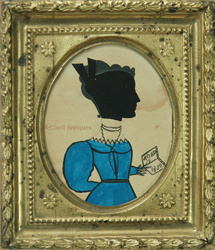
Puffy Sleeve Artist (active 1830-1831)
This is a recognized and highly sought-after American silhouettist whose work makes me happy and shows the great creativity of American folk silhouette artist of the 19th century. We don't know who the Puffy Sleeve Artist was, but he or she left behind a wonderful legacy of unique naïve silhouettes with hollow cut heads atop watercolor bodies. The profiles are all three-quarter length with women always facing left and men always facing right. The heads of women sit high above their bodies with long necks that give room to highlight their necklaces and fichus. Hair is added above the head with India ink or watercolor. The dresses are always painted, usually blue or black. The women's hair combs are cut into the hollow cut and sit high above their head. The right hands of the women rest at waist length and the left hands hold an accessory such as a book, purse, parasol, or flower. Books often bear the initials or age of the sitter and a date. Like the women, men have their hair painted around the hollow-cut head. The left hand is frequently in the man's pocket or resting at hip length. The right hands of the men holds a decorative object such as a hat, book, cane or even a trumpet. Hands of both women and men appear to be gloved. Many have been found in gilded frames with an inset rope, leading some to believe that these were the only original frames used by this artist. I believe that enough have been found in originally sized period frames that this artist may have used a number of different frames. Itinerant artists often bought frames from different frame-makers as they worked their way along their routes. All recorded dated examples bear the dates of 1830 or 1831. Examples have been found in New Hampshire, Vermont and Massachusetts. Work by the Puffy Sleeve Artist is so desirable that unknowledgeable (or unscrupulous) sellers often mislabel silhouettes in which women wear leg-o-mutton sleeves as work by this artist. This artist's work is unique and there is only one other anonymous artist who did work similar to this.
Anderson, Marna A Loving Likeness American Folk Portraits of the Nineteenth Century, (Bristol-Myers Squibb Co. (1992) 44-47.)
-
-

Silhouettes in America, 1790-1840: A Collector's Guide
Another of my favorite reference books, this little book includes a very important chapter on dating silhouette from clothing. You'll pull it out again and again for that chapter! It's packed with illustrations of great American silhouettes. Ms. Rifken seems to lean a bit towards the folky silhouettes (which I love) and she illustrates what I think are some of the most creative silhouettes made. This copy looks unread and almost like a brand new book. Can't possibly have even been read as it has no creases in the binding and no marks. However, there is a crease running vertically from top to bottom about 1 1/2" from the right edge. Still an excellent copy
(#5634) $45
-
-
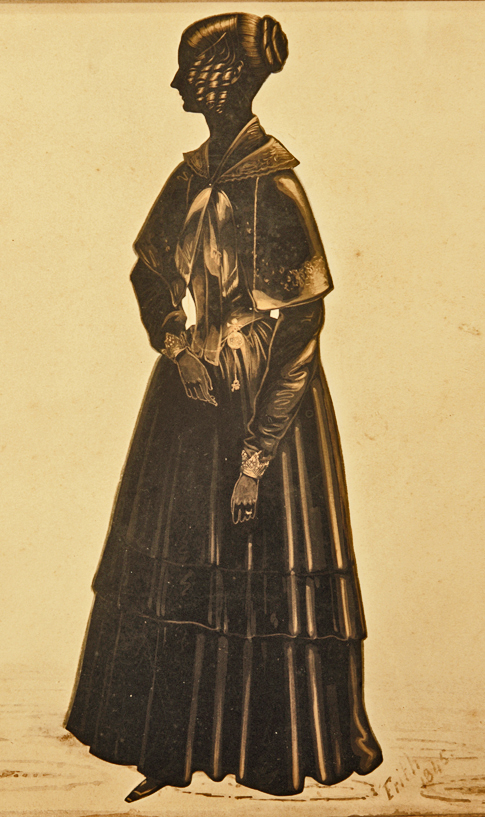
Royal Victoria Gallery - F. & H.A. Frith (after 1837-1854)
The Royal Victoria Gallery was managed by three artistic members of the Frith family. Brothers Frederick (who used the signature "F.") and Henry Albert (known as "H.A.") touted their talents as “PAPRYOTOMIST[s] to His Late as well as to her present Most Gracious Majesty, and to whom most of the brilliant Court of the United Kingdom have sat for Their Likenesses. . .” They claimed to have cut “many Thousand Likenesses” and to being able to complete the cutting with their “Talismanic Scissors” in only one minute. The brothers often advertised that they were joined in their travels by their father, “Mr. Frith, Senr.” “whose Talents as a Portrait and Miniature Painter are too well known to need comment.” Both brothers are known to have cut silhouettes. It is unlikely that Frith, Sr. cut profiles, but it is assumed that he may have done some of the bronze work on the more elaborately embellished silhouettes.
The embellishment of the Royal Victoria Gallery silhouettes is of the highest quality. Unless a signature identifies one of the brothers, it is impossible to know which brother may be responsible. It is also generally assumed that the Friths had unidentified assistants who may have helped with the cutting and/or bronzing. Sue McKenzie notes in her book, British Silhouette Artists and their Work 1760-1860, that signed examples tend to show that Fredrick Frith was capable of painting backgrounds in a more finished style than his brother. Also, the bronzing in some of F. Frith’s signed examples exhibits more expertly rendered work with more extreme highlighting than H.A. Frith’s signed work.
One feature common to full-length male figures produced by the gallery is the stance in which the men are shown standing with their feet apart, with the far leg bent at the knee. Although full-length female figures have legs hidden under skirts, the feet apart stance is commonly seen with the lady’s background foot pointed to the side and the front foot pointed forward.
Please view the Royal Victoria Gallery & Frith silhouettes currently in stock on the Silhouettes page.
-
-

American Folk Portraits: Paintings and Drawings from the Abby Aldrich Rockefellar Folk Art Center
This is another of my favorite books on folk portraits from the museum which, in my opinion, has the largest and most complete folk art collection in the country. A real go-to reference book with wonderful illustrations of portraits by the most important American folk portraitists. I use this book at least weekly in my research. It has 97 color and 240 black & white illustrations. The book reads like a Who's Who of early American folk art and also includes lots of images and details of work by unidentified artists. This is a must-have.
This copy is in very good to excellent condition. Dust cover is excellent with a mylar covering (the back flap has a crease). Spine is good and tight, no marking on the pages that I can find. A previous owner's name is written on the inside front cover page and brief annotations written on the inside back cover page. Pages have slight yellowing. Otherwise, it looks like a unused copy, carefully shelved.
(#5253) $50
-
-
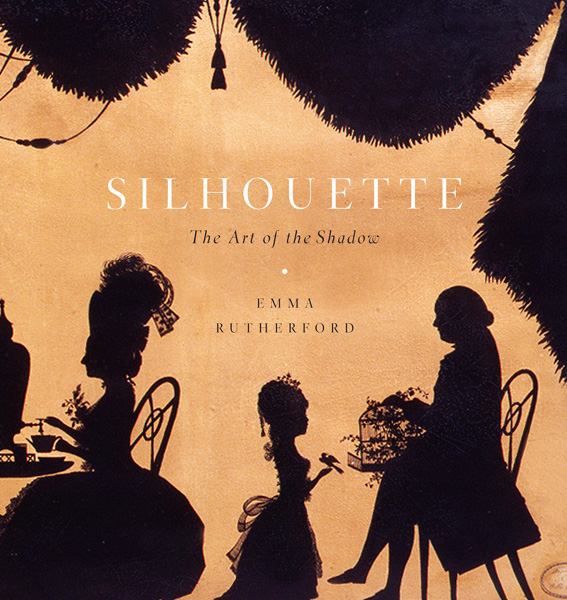
Silhouette: The Art of the Shadow
This is the first major book about silhouettes since 1978. The first review of the book says the book is "Beautiful and overflowing with charming illustrations, Rutherford’s book proves full of substance." The book has arrived and it is visually stunning book with 255 pages packed with beautiful color photographs of silhouettes from museums and private collections and good information about history, techniques, artists, and more. You don't want to miss this beautiful book!
List price is $65 but I'm offering this book to my faithful readers for $45 plus USPS Priority Shipping $15
-
-
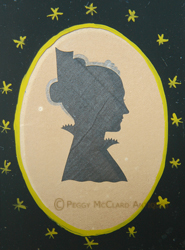
Justin Salisbury (active circa 1825-1835)
Justin Salisbury was a Vermont resident, who worked primarily inthe Connecticut River Valley. Unlike most hollow cut silhouettists of the period, it appears that Salisbury worked freehand, without the aid of machines such as physiognotrace. We believe this because his work does not exhibit an incised or penciled line bordering the edge of the profile, as most mechanically drawn profiles exhibit. Salisbury's work is often embellished with penciled details, such as the hairstyle embellishments in this silhouette. The sawtooth border of this young lady's neck ruff and the wave at the bust termination are characteristic of Salisbury's work. Salisbury cut his men with hollow cut heads, uncut collar and coat lapel, then hollow cut shoulder, much the same as William Chamberlain's cutting. However, whereas Chamberlain and most similar works of the period colored the lapel with watercolor, Salisbury used pencil to color the lapel. He drew a very simple stock with ink. The bust termination of Salisbury's men is a straight line, slightly angled up toward the back, with a small downward notch about two-thirds toward the back to depict the arm.
Howe, Florence Thompson, "Justin Salisbury's Silhouettes", Spinning Wheel, March 1971. 54-55. Click here for a pdf version of the article.
Sloat, Caroline F., ed., Meet Your Neighbors New England Portraits Painters & Society 1790-1850, Old Sturbridge Village 1992. 93-95
-
-
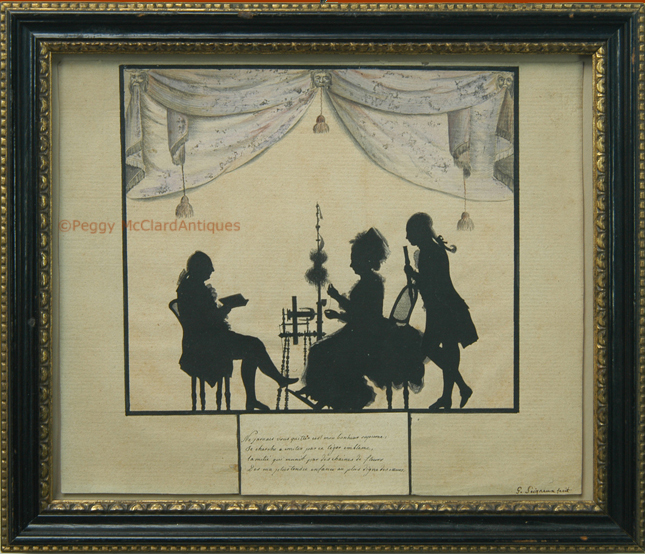
Georges-Hyde Seigneux (1764-?)
The Musée historique de Lausanne in Switzerland has two silhouettes by Georges-Hyde Seigneux in its collection. The museum reports that Seigneux was born into a noble family in Lausanne in 1764. He was a first office Captain in the service of the Electorate of Bavaria. During the height of the French revolution, Seigneux was a lawyer and prosecutor for the canton of Vaud. He was a jurist and historian and published Summary of Revolution in the canton of Vaud in 1798. He married Elizabeth Massé, daughter of Jacques Massé. His work is cut & paste with watercolor backgrounds. The fine, tiny conversation silhouette shown at the left is only 7" x 9" but all three figures are cut with amazing detail and placed within a drawn border with added watercolor detail for the frills, the caning on the chair backs, and the finer parts of the spindle. The grey and mauve painted swags are held in place with three grotesque heads which add a wonderful touch of humor. An inscribed verse placed within a cut border below the figures. The source of the verse is as untraced so it may even be original. “Ne jamais vous quitter est mon bonheur supreme: / Je cherche a imiter par ce léger emblem / la mitie qui munit par des chaines de fleurs / Des ma plus tendre enfance au plus digne des coeurs.” This roughly translates to “ To never leave you is my supreme happiness / I am trying to imitate this lightweight emblem / the mitie [I have not found a translation for this word] which equips by chains of flowers / Of my childhood the most worthy of hearts.” Seigneux's work is rare and very fine.
-
-

W. Seville (1797-1866) & F.W. Seville (circa 1825-1899)
William Seville probably began cutting silhouettes in 1818 or 1819 in Manchester, England. He and his son, Frederick William, offered a great variety of work other than silhouettes. It appears that W. Seville began traveling as an itinerant artist in 1820 as a number of addresses have been noted on handbills advertising his work. One advertisement notes his prices as follows:
- One Black Shade for 1s.
- Two Black Shades for 1s. 6d.
- These, ‘bronzed’, 1s. extra.
- Full-length: 5s. Two full-lengths for 6s. 6d.
- Bronzed: 2s. extra.
- Dogs: 3s. 6d.
One shilling for a plain black silhouette was quite cheap even for the period. Seville must have been quite busy at those prices. He eventually raised the prices of his dog profiles to 5s.
W. Seville is known as an accomplished cutter, working only with plain scissors--never the automated contraptions that were the rage in the early 19th century. The bronze embellishment may have been done by his son, F.W. Seville, who is known to have been an accomplished painter.
A silhouette that has recently passed through my hands is signed by the son as the cutter. The silhouette also bears the impressed stamp "W. SEVILLE, ARTIST." Because of this wonderful find, we now know that the son worked in his father's studio as both an accomplished cutter and painter of embellishment!
There is a wonderful blog entry about William Seville and his work at
Photo-Sleuth, September 17, 2009 entry
-
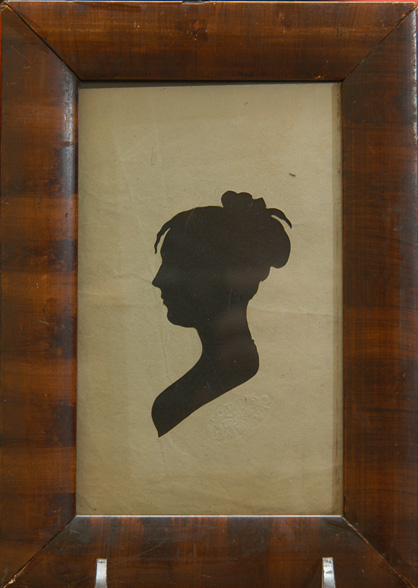
Todd's Patent, Isaac Todd, American Silhouettist (active at least 1807-1812)
Little is known of the American silhouettist who signed his profiles with the impressed stamp “Todd’s Patent.” Alice Van Leer Carrick’s research led her to believe he was the George Todd found in the Baltimore Directory of 1810, and he was known as “George (?) Todd” since Carrick wrote her book in 1928. Thanks for the research of Sue Anderson, we now know that the silhouettes bearing the impressed signature "Todd's Patent" were cut by Isaac Todd. Ms. Anderson's research (which she cheerfully shared with me) found that I. Todd was advertising his appearance and work with his Physiognatrace as early as 1804 in Alexandria, VA and Washington. Todd worked for a while in conjunction with T.P. Jones in New York City beginning in 1805. In 1807, Isaac Todd advertised in Charleston, SC that "All profiles will be stamped Todd's Patent." His Charleston advertisement stated that he cut 4 profiles for 25 cents "From the liberal encouragement received during nearly four years in New York, Baltimore, Alexandria, New-Orleans and several small towns..."
It is surprising that an artist who has remained such a mystery left a wonderful legacy of duplicate hollow-cut silhouettes. The Anthenænum Special Collections Library in Boston owns the beautiful folio consisting of 1,758 hollow cut silhouettes in which Todd scrupulously recorded the name of each sitter. The Anthenænum's folio by Todd includes sitters from Maryland, Virginia, South Carolina, Kentucky, Pennsylvania, New Jersey, New York and Massachusetts. The museum identifies Todd as "Isaac Todd of Baltimore".
Todd’s unadorned silhouettes were done in several sizes, from a mere 1 5/8” tall to nearly 3”. His style is distinctive and always bears the impressed stamp “Todd’s Patent.” His ladies are beautifully cut and thoughtfully rendered. But Todd’s excellence in cutting is found in his rendering of men (which are now very rarely found) who bore the most elaborate of costumes, including ruffled shirts, hairstyles à la Titus, and tall beaver hats. However, Todd’s silhouettes are so rare that any found are always quickly snapped up.
-
-
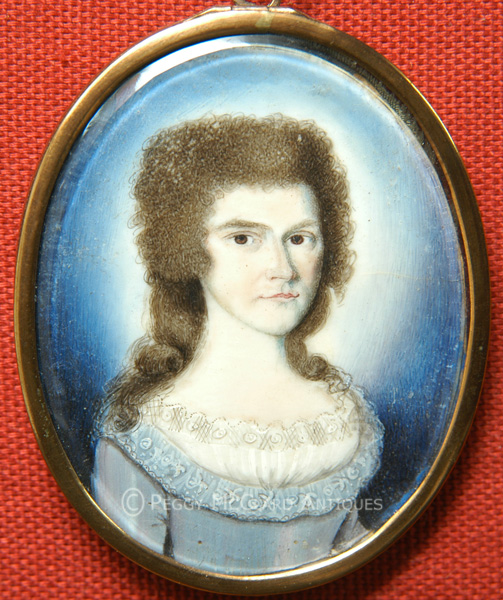
William Verstille (1757-1803)
William Verstille was born in Boston in 1757, but raised in Wethersfield Connecticut when the family moved their in 1761. He was a soldier in the Revolutionary War, during which time he painted portrait miniatures of some of his officers. He married Eliza Sheldon in 1780 and moved to East Windsor, Connecticut, where the first five of the Verstille's six children were born.
Verstille worked in Connecticut, Philadelphia, southern Massachusetts, and New York City (where he obviously took notice and styled his work after John Ramage, New York's leading miniaturist). While in New York, he kept a detailed account book recording his commissions for mourning pieces, hairwork, and jewelry. While in Salem, Massachusetts, he painted several portraits of sea captains, setting them against a seascape background that often included a ship, a lighthouse, and sometimes a rowboat.
Verstille's brushwork shows a sketchy quality with thin, wavering lines. Modeling is minimal and effected by a blue or grey hatch. His sitters are portrayed with large, piercing, dark eyes, thin brows set close to the eyes, a long, somewhat crooked nose, then, slightly mispositioned lips that occasionally curl and the corners, and bristly hair. Backgrounds are frequently blue or grey, thickly painted and shaded with long, vertical grey hatches. Backgrounds on later works are often shaded with light blue. Details of costume are considered charmingly decorative but not rendered with the precision of the master John Ramage (for whom Verstille's work is often mistaken). The signature "Verstille" is often placed beside the sitter's shoulder, half hidden by shading.
Johnson, Dale T., American Portrait Miniatures In The Manney Collection. The Metropolitan Museum of Art, New York, 1990. 223-25.
-
-
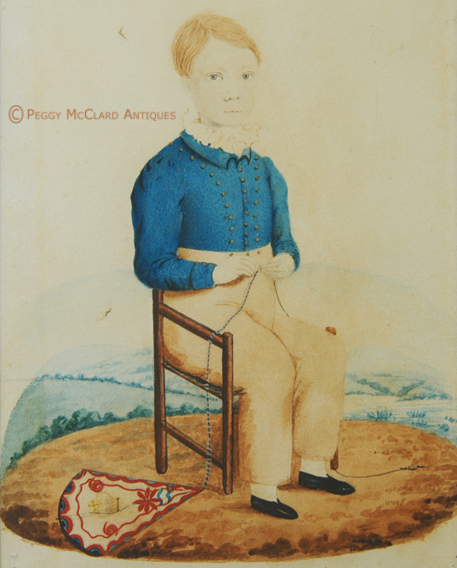
Henry Walton (1805 - 1865)
There is some confusion about Henry Walton's birth and death. Sources say he was born either in New York City or England in either 1804 or 1820. The 1804 date seems the most likely since the majority of his watercolor portraits date from the 1820s through the 1830s. He died either in 1865, in Michigan, or in 1873, in California. All sources seem to agree that he made a living with his watercolor portraits. By 1829, Walton was drawin on stone (making lithographs) for Pendletons of Boston, and is well-recognized for his lithographic cityscape work. He is known to have painted portraits in New York towns such as Elmira, Big Flats, Addison, and Painted Post. In 1851, Walton left the East for the gold rush of California. In 1857, Walton and his wife, Jane Orr Walton, moved to Michigan where they lived until the end of their lives. I found an undated marriage record on Ancestry.com for Jane Orr marrying Henry Walton....although the marriage record was undated, it gave Jane Orr's birthyear as 1804, making it more likely that Walton's birthyear was 1804. But see Note below. I also found a marriage record on FamilySearch.org saying that Henry Walton and Jane Orr were married in Cass, Michigan June 20, 1839.
It is thought that Walton might have had some architectural training because the detail of his town-views and the backgrounds of his portraits are so precisely depicted. It is less likely that he had any academic training for his portraiture work which displays the naïve that folk art collectors cherish. Leigh Rehner wrote,
Apparently neither a complete amateur nor academy-trained, in his small water color portraits . . . he shares with the primitive or naïve portrait painter some of the pitfalls (or charms, depending on the present-day taste of the viewer) of inaccurate perspective, in contrast with the control of perspective in his town-views. One result of this "failure," the lengthening and flattening of the figure, consciously pursued by artists of other periods, occurs frequently in primitive painting. At times, the opposite can be noted; torsos and arms appear foreshortened, and size relationships may be somewhat erroneous (this can be seen in the rather large heads of some of the children he painted). Although these distortions were never extreme in Walton's work, he nevertheless shows increasing mastery over these tendencies; we may perhaps assume he was aware of these problems.&nbnbsp; He futehr shares with the primitive portraitist a lovely quality of abstraction, quite pronounced in his early water colors as well as in his first oil.7
Note: Thanks to a kind reader, Floyd Deal, who was researching a member of the Orr family to whom he is related, found Henry & his wife, Jane Orr Walton's burial marker in Prospect Hill Cemetery, Cassopolis, Michigan. The headstone confirms that Henry Walton died on April 25, 1865. The marker also gives his birthday at 1805. Having readers contact me with family information about artists or sitters is always exciting and I love to give credit where credit is due (if the researcher agrees for me to release a name). I strongly encourage all of you to contact me with new information about these artists. That's how scholarship progresses! Thanks to Floyd!
Jones, Leigh Rehner, Artist of Ithaca: Henry Walton and His Odyssey. Herbert Johnson Museum, Ithaca, New York. 1988.
Lipman, Jean & Winchestor, Alice, The Flowering of American Folk Art (1776-1876). Penhuen Books Ltd. 1977. Plate 40 at 41 & 282.
Rehner, Leigh, Henry Walton: 19th Century American Artist. Ithaca College Museum Of Art, Ithaca, N. Y., 1969.
Rumford, Beatrix T. American Folk Portraits Paintings and Drawings from the Abby Aldrich Rockefeller Folk Art Center. New York Graphic Society, 1981. 190-191.
7 Rehner, supra, at 12.
-
-

Thomas Ware (1803 – 1826 or 1827)
Thomas Ware was born in Pomfret, Vermont to Frederick and Jemima Manning Ware. Frederick apparently liked having a very large family because Thomas had 3 step-sisters born during Frederick’s first marriage and Thomas was the tenth of twelve children born of the second marriage! Thomas grew up with another important Vermont folk artist, Benjamin Franklin Mason. When Mason was 9 years old, he was confined to his bed to recuperate from surgery. Thomas encouraged his friend to draw, copying engravings in books. The two friends continued to draw, using chalk and coal. Ware met portraitist Abraham Tuthill from whom Ware learned the techniques of painting in oil. In 1823-25, Ware and Mason were in school and painting together in Woodstock.
When Arthur & Sybil Kern published their article, “Thomas Ware: Vermont Portrait Painter”, only 41 portraits by Ware had been identified, all in oil on either wood panel or canvas. All but two are bust length (really these are half-length but generally referred to as bust-length in publications discussing his work) with the sitters shown in three-quarter view and filling most of the frame. With a few exceptions, women generally face slightly to their left and men to their right. All portraits are strikingly similar (which is not surprising since they were all painted within the period of 4 to 6 years) with wide-open eyes, large ears, large eyebrows, heaving shading along the line of the nose and a deep depression in the midline of the upper lip. Hands are generally not shown unless holding a prop such as a book or spectacles. Young women generally have a tortoise shell haircomb and prominent ringlets in front of their ears. Backgrounds are generally dark and subjects usually have a dark outline and a source of strong light usually comes from the side on which the sitter is slightly turned away from, casting a strong shadow to the front of the slightly turned subject. Some of Ware’s portraits bear inscriptions on the reverse, painted by the artist identifying the sitter and less frequently including his signature. Since no advertisements have been found for Thomas Ware as an artist, it is thought that he was commissioned solely through word of mouth. Thomas Ware reportedly died, unmarried, in Whitehall at the age of 23 or 24.
References:
Kern, Arthur B. & Sybil B., “Thomas Ware: Vermont Portrait Painter”, The Clarion Winter 1983/1984, 36-45.
American Paintings at Harvard: Paintings, watercolors, pastels, and stained glass by artists born 1826-1856, Harvard Art Museums, 2014. 508
Please view the Thomas Ware portrait currently in inventory on the Portraits page.
-
-

Electra Case & Husband John BlackOrson C. Warner (b. 1800 & active in New England circa late 1820s)
Orson C. Warner has been a mystery silhouettist until very recently. He does not show up in any of the silhouette reference books. However, thanks to the author of the very interesting blog Photo-Sleuth we know that Orson C. Warner was born in 1800 in Chester, Connecticut. His parents were David Warner and Mary Cone Warner, both life-long residents of Connecticut. Orson Warner's family first immigrated from England to America both on the Mayflower (Mary Chilton) and on the later ship Fortune (John Winslow) which came to America in 1621. Other than this very interesting genealogy, we know little else about Orson Warner except he wrote a self-published autobiography. I am currently waiting for a copy of this book to arrive.....I'll add any appropriate information once I have a chance to examine the book.
We do know that Warner cut hollow cut silhouettes with uncut collars for both men and women (see the silhouettes of Electra Case and John Black). He also favored a bust termination consisting of two convex curves with a sharp point in the center (compare the silhouette of John Black with those of the Head twins) although this was not the only bust termination he used (see silhouette of Col. John Head). We also know that he sometimes cut women with completely painted bodies (see silhouette of Anna Brown Head). Warner identified his sitters and signed his work with rather sloppy writing on the wood backing of his frames.
Warner's silhouettes are classic examples of American folk silhouettes.
-
-
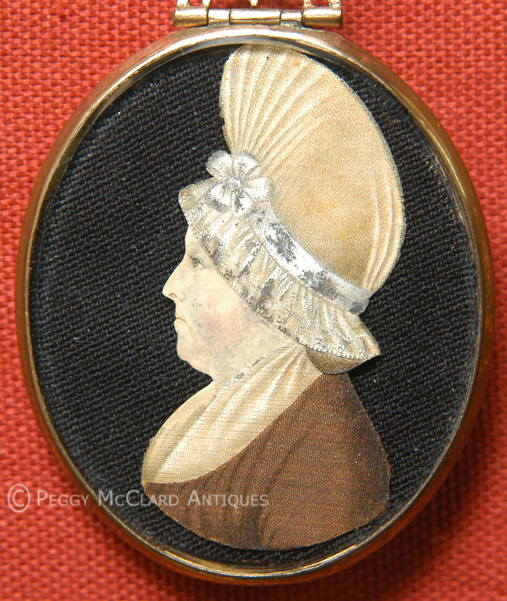
Mary Way (1769-1833)
Mary Way was born in 1769 in New London, Connecticut to Ebenezer and Mary Taber Way. Her family helped settle New London in the mid-seventeenth century. Mary never married and her letters indicate that she was too independent for the thought of marriage. It was difficult for a single woman to make a living in the late 18th century, but Mary turned her skills as a seamstress and an artist into an active and successful career as the first professional female artist in America.
Mary combined her skills of sewing and painting to produce "dressed miniatures"--tiny cut-paper profiles with the face and hair painted with watercolor, the clothing cut from various materials--stitched and glued in place, highlights added to the clothing with additional paint, and finally pasted onto a fabric background. Although Mary was not the first or the last to create dressed miniatures, she was certainly the most successful. She created these dressed miniatures only for period of 12 to 15 years at the end of th 18th century. As of 1997, only 36 dressed miniatures that are reasonably attributable to Mary Way had been recorded.
Although Mary appears to have stopped creating her lovely dressed miniatures after 1800, she continued her profession as a painter of portrait miniatures. Self-taught and competing against the most accomplished artists in America, Mary Way had an active business in New York City from 1811-1819. Her advertisements in The Columbian and the New York Evening Post in 1811 stated:
Mary Way, portrait and miniature painted from New-London, Connecticut. Takes likenesses upon ivory or glass in colors or gold, landscapes or views of country seats, &c &c. Paintings not approved may be returned without charge at her painting room, No. 95, Greenwich-Street, where specimens of her performance may be seen and the prices made known. hours of attendance from 11 o'clock till 3.
Mary supplemented her income by teaching painting, embroidery, lace work, and other subjects to young ladies while she was living in both New London and New York. Mary Way's miniatures on ivory exhibit a skill comparable to the best of American miniatures portraiture on ivory of its time in levels of sophistication and sensitivity to character. Her work was exhibited at American Academy in 1818.
The facial features of the miniatures that Mary painted on paper or ivory show the same style as those of her dressed miniatures. Her dressed miniatures were placed on black fabric to emphasis the profile. She used a dark wash background for her painted miniatures to achieve the same result. Mary Way's dressed miniatures and painted profiles are exceedingly rare and greatly sought by collectors.
Frank, Robin Jafee, Love and Loss American Portrait and Mourning Miniatures, Yale University Art Gallery, New Haven, Conn., 2000. 199-204.
Kelly, Catherine, "Object Lessons: Miniature Worlds", Common-Place.org, Vol. 3, No. 2, January 2003.
MacMullen, Ramsay, Sisters of the Brush Their Family, Art, Life, and Letters 1797-1833, PastTimes Press, New Haven, Conn., 1997.
Visit this blog about Mary Way, written by, Cheryl-Lynn May, a graduate student in the Winterthur Program in American Material Culture. She is writing her thesis on Mary Way and dressed miniatures. Very exciting stuff!
-
-
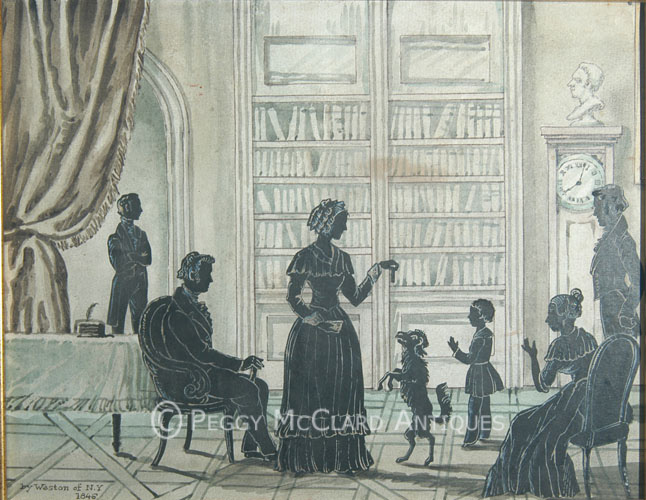
Mary Pillsbury Weston (often listed as Mrs. Valentine Weston) (1817-1894)
Mary B. Pillsbury was born in Hebron, New Hampshire in 1817. Her father Stephen Pillsbury was a Baptist minister and a fifth generation American. His family members immigrated from England sometime before 1645 when the first American member, Moses Pillsbury, was born in Dorchester, Massachusetts. Mary was the sixth of eight children born to Stephen and his wife Lavina Hobart.
Mary acquired a great love for art at an early age. When she gave an account of her life for the 1859 book Women Artists All Ages and Countries by Mrs. E.F. Ellet, Mary recollected that she first attempted to draw the face of a beautiful woman who caught her eye when she was merely seven years old. After that, young Mary spent her free time sketching and reading books about artists. She was especially fond of prevailing upon a younger sister to sit for her as she practiced sketching. Once Mary had mastered a sketch of her sister, she turned her drawing talents towards neighboring Indigenous People who often visited Hebron. One day during Mary’s childhood, Hebron was visited by an itinerant silhouettist whom Mary watched while at work. From that day forward, Mary practiced cutting silhouettes from leaves and paper until she had mastered the art.
Although Mary wanted to spend all her time with her artwork, her mother was afraid the study of painting would interfere with more important study and refused to allow young Mary to take art lessons. Despite her mother’s objections, Mary continued to practice painting. She used beet-juice, and the extract of bean-leaves to prepare paints for herself until a family member finally gifted a box of paints to her. Mary continued to paint and read biographies of artists and as many books about classical times and faraway places as she could find in her father’s library to the exclusion of playing with other children her age. Her longing to become a famous artist filled her otherwise lonely life.
When Mary was fourteen, she ran away from home, walking thirty miles in a day with the intent to reach Concord where she hoped to earn a small living through housekeeping or laundry while she worked to establish herself as an artist. Late at night, the tired young girl finally stopped at a small house in the country where she asked to stay long enough to rest. Once Mary had told her story, the home owners asked her to stay the night. After the exhausted young girl had fallen asleep, Mary’s host left for Hebron to alert her family. The next morning, Mary awakened to find her uncle waiting to take her home. Mary’s family welcomed her home, never said a word about her disobedience and offered a bit more understanding about her wish to spend her time practicing her art instead of doing chores. Mary never quit dreaming about life as a professional artist.
At the age of nineteen, Mary finally set out to become a professional artist. With twelve dollars and a small basket of clothes, Mary left for New York. She spent a week in New York, staying with a lady whom she did not know, but who let her stay because she had previously heard about the strange young lady in Hebron who wanted to be a painter. After a week in New York, Mary took a suggestion from her hostess (and a letter of introduction) and set out for Hartford, Connecticut. There she was received by Rev. Henry Jackson who allowed the young artist to stay in his home. There she set out preparing canvases and grinding paints in preparation for her new profession. Soon after, Rev. Jackson received visitors from Willington. Mary’s paintings pleased the visitors so much, they took her home with them to paint family portraits. Nineteen year old Mary Pillsbury was now a professional artist. In Willington, Mary painted the portraits of her benefactors as well as thirty other people. Homes were opened to her all over the city. Among those she painted in Willington were members of the Jonathan Weston family.
Mary returned to Hartford and spent much of time staying with the Weston family who had a daughter of Mary’s age with whom she became fast friends. While Mary was staying with the Westons, Jonathan Weston’s brother, Mr. Valentine Weston, paid a visit and was so enthralled with Mary’s paintings that he urged her to visit New York to study art. Mary became intent upon raising enough money for a year’s study in New York. Soon however, her savings were unnecessary as an invitation came from Valentine Weston’s daughter, Sarah, for Mary to come to New York and stay with the Valentine Westons while she studied art. Mary took advantage of the offer, moved in with the Westons, studied her art, and, three months after the move, became the second Mrs. Valentine Wightman Weston.
She bore at least two children: a daughter named Valentine Lavina Weston who was born in September 1843. I have been unable to find the name or birthdate of the second child but I have found evidence that one of Mary’s children was a daughter who went by the name of Eva. Whether “Eva” was short for Lavina I can not tell, but after Mary’s husband died in 1863, Mary and Eva lived with relatives in New Hampshire before moving to Lawrence, Kansas in 1874. There Mary lived until her death in 1894.
Mary’s paintings were exhibited at the National Academy in 1842. In 1893, she created a painting especially for the 1893 World’s Columbian Exposition in Chicago which she called “The Spirit of Kansas.” The painting depicts a classical figure of a woman astride a white horse. The woman holds a dove representing peace. Below the horse’s feet is a snake representing tyranny being stamped out. Receding storm clouds above the woman’s head represent her hope that the violent Indian/settler conflicts upon which Kansas was built were disappearing. This great painting currently resides in the collection of the Kansas Museum of History.
Mary Pillsbury Weston was an accomplished portrait artist, silhouettist, and painter of classically-based paintings and religious paintings. She depicted her figures with great movement and with a special eye towards grace of the human form. Her silhouettes are rarely found and represent some of the most complicated of the already rare American conversation pieces. She cut whole families, embellished them with Chinese white and pale blue and laid them upon watercolor backgrounds of a much more complicated nature than those done by Edouart, Metford, or even William Henry Brown. Unlike other artists of the day, she used color in her backgrounds such as subtle shades of green and brown. Her silhouettes are very rare.
Mary’s cousin John and second cousin Charles Pillsbury founded the Pillsbury flour milling dynasty.
-
-

James Hosley Whitcomb (1806-1849)
James Holsey Whitcomb was born to Oliver and Hannah (née Hosley) Whitcomb in Hancock, New Hampshire. The Whitcomb family first immigrated from England to Massachusetts sometime before 1632. When James was two or three years old, he became ill with scarlet fever which left him permanently deaf. In 1822, he was admitted to the American Asylum, which was founded in 1817 in Hartford, Connecticut as the nation's first institution for the education of deaf-mutes. James was one of nine deaf children, chosen from forty applicants who received a scholarship from New Hampshire's legislative appropriation of $1000 "for the purpose of educating the deaf and dumb children belonging to this State at the Asylum in Hartford, Connecticut." At school, James learned both written English and a sign language that was to become the basis of today's American Sign Language. He was also introduced to abstract philosophical and religious ideas to which the deaf child had no previous comprehension. The students spent three or four hours each day training for a specific occupation. James learned the trade of shoemaking. There are no specific records showing that the school taught the arts, but the school's principal, Rev. Thomas H. Gallaudet, seems to have included the fine arts among his goals for deaf-mutes. Several graduates of the school are known to have become artists, including Augustus Fuller (portrait painter, admitted to the Asylum in 1824), and William Niblo, Jr. (exhibited paintings at the American and National Academies, admitted to the Asylum in 1826). James graduated from the Asylum in 1827 and by 1830 he was producing both cut & paste and hollow cut silhouettes.
James H. Whitcomb probably spent a number of years as an itinerant artist. Although several silhouettes by Whitcomb of New York residents have been found as well as New Hampshire residents, nothing is known about Whitcomb's exact locations until 1839 when he married Sarah Ann Enos, who had graduated from a New York institution for deaf-mutes. By 1841, the Whitcombs lived in Afton, New York, where Whitcomb worked as a shoemaker. James died suddenly at the age of 42 in 1849. He had fathered three sons by the time of his early death. It is unknown whether he continued his silhouette cutting during the last decade of his life.
Only one cut & paste silhouette by Whitcomb is know. The silhouette is a spectacular representation of President Andrew Jackson on horseback. Painted banners surround the president and stylized stars are painted in the corners. It is signed "Cut with scissors and painted by J.H. Whitcomb in 1830." This silhouette resides in the Boston Museum of Fine Arts. It is Whitcomb's hollow cut silhouettes that rarely show up on the market and have such a stylized bust-line termination as to be instantly recognizable. Only two are known to be signed, including a portrait of W.M. Matthews, signed "J.H. Whitcomb a cutter of this". Also know is a self-portrait signed "Aged 24, 1831. James H. Whitcomb cutter of himself." All other of Whitcomb's work is attributed based on his exaggerated fully curved bust line terminations with deep indentations delineating the outline of the lower edge and back of the sitter's coat so that the bust termination looks like an apostrophe. The men all have hollow cut heads and the shoulder beneath the jacket lapel is also hollow cut. The coat lapels, shirt front and collar are all left uncut, then richly detailed with ink and watercolor. Hair is added to the simple cutting of the head with the addition of ink or watercolor. The women have the same apostrophe bust curve. Again, heads and shoulders are hollow cut and the woman's collar is left uncut. Details of collars are delightfully painted with watercolor and ink. Bonnets or hairstyles are softened with pencil or watercolor. The depth of the apostrophe bust curves vary from silhouette to silhouette showing that Whitcomb's formula was not hard and fast. He took the time to make each silhouette unique.
J.H. Whitcomb silhouettes are quite rarely found on the market and highly sought.
References:
Garvin, Donna-Bell, "James Hosley Whitcomb: New Hampshire Silhouettist", Historical New Hampshire, Spring/Summer 1977. 42-57.
Jackson, Mrs. E. Nevill, Silhouettes a History and Dictionary of Artists. Dover Publications, Inc. New York 1987 (first published in 1938 by Methuen & Co. under title Silhouette: Notes and Ditionary). 152 & Plate 60, illustrating signed silhouette of W. M. Matthews by Whitcomb).
Rifken, Blume J., Silhouettes in America, 1790-1840. Paradigm Press, Inc., Burlington, VT. 1987. 74-75 (showing two unattributed Whitcomb silhouettes of New York residents.
-
-
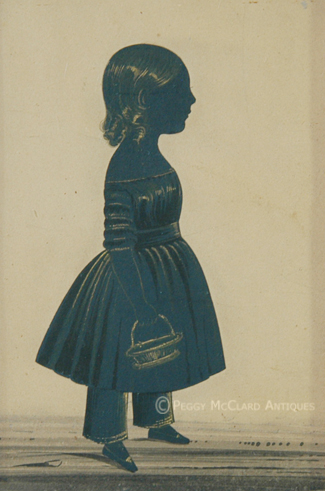
George White (1810-1880) White's Gallery
George White was born in Derbyshire village of Winster to James White and Elizabeth Hodgkinson. In 1835 he married Ann Melbourne. One year later White opened a profile cutting studio in Manchester offering to “cut likenesses of ladies, gentlemen, and children; dogs, horse, &c”. This studio remained open for seven months then White moved his family to Preston, where he offered likenesses in full length, half length or busts, plain or finished in shade or bronzed. He advertised that he could cut “STRIKING LIKENESSES, cut with scissors in three minutes.” Little is known about White’s professional career between 1836 and 1846. We do know that he worked as an itinerant artist at least through the last half of the 1830s. Although we do not know where he cut them, we have silhouettes bearing the White’s Gallery stenciled trade label which date circa 1840 – 1845. Therefore, we know that White was still cutting silhouettes as part of his profession during that period. However, neither advertisements nor directory listings have been discovered that indicate what type of art White was creating between 1839 and 1849. In 1849 in tree in Gillian Jones’ directory, Lancashire Professional Photographers, White is listed as a photographer.
Recent discoveries show that George White was indeed still cutting profile likenesses of both humans and animals circa 1840-1845 and embellishing them not only with gilt bronzing but also splashes of color. Two recently discovered full length silhouettes backed by the White’s Gallery stamp depict people and a dog standing at waters edge with water indicated by a splash of Prussian blue watercolor behind the figures.
-
-
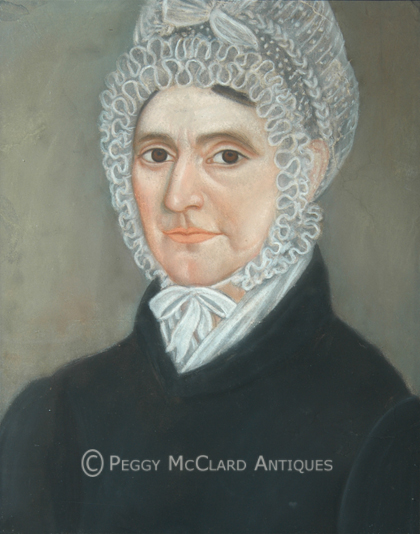
Micah Williams (1782-1837)
The tombstone of Micah Williams in North Brunswick Township, New Jersey, gives his birthdate as 1782 and his death as November 21, 1837. His birthplace is believed to be near Hempstead, New York, but that is not confirmed. He married Margaret H. Priestly, daughter of John and Catherine Voorhees Priestly, on December 24, 1806. Public records show he had six children. Williams and his brother-in-law had a successful silver plating business. However, the Embargo Act of 1807, the Non-Intercourse Act of 1809 and the War of 1812 all combined to cause a severe economic depression and the silver plating business collapsed. The Williams family had all of their possessions seized and Williams, himself, went to debtor's prison 1815 (he was released from the Middlesex County jail in New Brunswick, NJ in the spring of 1815.
Once Williams was released from jail, he set about establishing himself as an itinerant portrait painter and supported his family in that field for the next twenty years. Early in his career as an portraitist, Williams worked in New Jersey, including the New Jersey counties of Middlesex, Monmouth, Bergen, Somerset and Essex with most of his clients being from Middlesex and Monmouth. In the three years between 1818 and 1821, Williams produced over sixty pastel portraits of Monmouth County residents.
In 1828, Williams and his family moved to New York City, where he learned to paint in oils. About fifteen oil portraits are thought to survive from this time period. He continued to work in pastels throughout his career.
Williams portraits were hailed by his clients, as evidenced by a note of praise published in 1823 in the Paterson Chronicle and Essex and Bergen Advertiser. After noting that Williams was self-taught the note stated:
we . . . cheerfully express our opinion of his correctness of design and execution, as well worth the patronage of an enlightened public.
Gerard Rutgers noted in his March 19, 1823 diary
this morning my Son Anthony went to Newark, and M. Williams Portrait Painter took my likeness, he began in The Morning and finished by Sundown.
Williams and his family returned to New Brunswick in 1832. The pastel portraits from 1832-1835 (the last three years of his career) show a sophistication that is lacking in his folkier, more naïve pre-New York work. It is believed that Williams received training from an artist while in New York, but this has not been confirmed.
It seems that Williams stopped painting in 1835. A newspaper report of a tornado hitting New Brunswick on June 19, 1835, described one of the hardest hit structures as "Occupied by Mr. Williams." Thus, it is believed that the catastrophic even contributed to the end of his career as an artist. It appears that when Williams died in 1837, his family was again impoverished.
Williams worked mostly in pastels, which according to a descendent, he made himself. He stretched a sheet of pastel paper onto a sheet of newspaper, then attach the layers of paper to a wooden stretcher, usually of white pine and fastened at the corners with half-lap joints. This method allowed Williams to prop his work against pieces of furniture, which negated his having to carry an easel. Also, the use of newspaper provided a later importance to art historians because the dates of the newspapers document the time the portraits were completed. Many of his paintings have monochromatic backgrounds, but some have landscapes with trees and grassy hills and others showed interiors with elegant draperies and architectural moldings. His pastel work is acclaimed for its "brilliant colors, stylized figures and hands, bold patterns and its distinctive yet realistic effect, although he tended to use standard poses and costumes for his sitters." Williams characteristically painted his sitters eyes as almond-shaped and gave them chubby fingers. The majority of his identified work was done between 1818 and 1830 in the vicinity of Monmouth County, New Jersey.
Bernadette M. Rogoff, "Micah Williams, Some Recent Discoveries", The Magazine Antiques, January 2009.
Rumford, Beatrix T. American Folk Portraits Paintings and Drawings from the Abby Aldrich Rockefeller Folk Art Center. New York Graphic Society, 1981. 193-95.
-
-
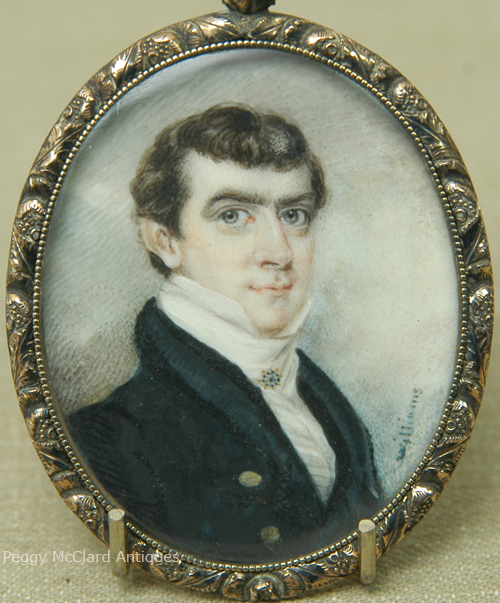
Henry Williams (1787-1830)
Bostonian Henry Williams cut profiles with added watercolor embellishment for hair and collar adornments around the edge of his machine-drawn, hollow cut silhouettes. According to his advertisements, he also painted miniatures and portraits on ivory and portraits in oil and pastel (or "crayons" as pastel was called in the 18th and 19th centuries). His hollow cut silhouettes were signed with an impressed signature in capital letters "WILLIAMS". His silhouettes are confidently cut with lovely extras such as small, narrow cuts for cravat ties and forelock hair. His added adornment finishes his hollow cut silhouettes with great flourish. One of his early advertisements described his work as follows:
CORRECT
PROFILE LIKENESSES
or no pay
Henry Williams will take correct Profile Likenesses with his new machine; and which takes 16 different sizes down to a quarter of an inch; cut on beautiful wove paper--may have two or four cut for 25 cts. -- elegantly framed with enameled glasses from 75 cts. to 1 dol., 1.50 and 2 dols.
Miniatures and Portraits executed upon Ivory; Portraits in Oil and Crayons; profiles painted upon glass; likewise on Ivory -- from 3 to 4 dols. Also, Glass Miniature Settings, for Sale, from 10 to 16 and 20 dols.
Profile Frames for sale, oval, round, square or circular, of various sizes; by the dozen, gross or single, cheaper than can be purchased in Boston.
N.B. Constant attention from 7 o'clock in the morning, until 9 in the evening.
This advertisements was found in an 1806 newspaper, when he would have been nineteen years old. No signed examples of Williams' painted profiles on ivory or glass are known. His hollow cut work is very scarcely found and very desirable.
Williams is considered a versatile artist doing work in pastel, silhouette, wax portraits, oil portraits, miniature portraits and engravings. He was listed as an anatomist in the Boston directories of the 1820s. He published Elements of Drawing in 1814. The book includes an essay and twenty-six engraved copper-plate portraits and other figures. Williams was most active in miniature painting from 1808-1826. At the end of 1806, Williams was in partnership with William M.S. Doyle in Boston. Many works between the years 1810 and 1820 are signed by both Williams & Doyle.
Fellow artist William Dunlap described Williams as follows: “He was a small, short, self-sufficient man; very dirty, and very forward and patronizing in his manner.” Williams silhouettes are always hollow cut and have India Ink embellishments around the edges. They are often signed with an impressed stamp “WILLIAMS”. His portrait miniatures display great detail and the sitters tend to have large, round eyes with heavy top and bottom eyelids. Mouths show slight pouchiness. The tips of noses are strongly highlighted. Most works show strong value contrasts. The backgrounds are of a mottled neutral color with light to heavy shadowing to indicate light coming in from the sitter’s back. This allows the pale ivory surface to often show through the light hatching on one side of the sitter.
References:
Barratt, Carrie Rebora and Zabar, Lori, American Portrait Miniatures in The Metropolitan Museum of Art. The Metropolitan Museum of Art, New York, Yale University Press, New Haven and London. 2010. 114-16.
Johnson, Dale T., American Portrait Miniatures in the Manny Collection. The Metropolitan Museum of Art, New York, Distributed by Harry N. Abrams, Inc., New York. 1990. 232-33.
-
-

Henry Williams (1787-1830)
Bostonian Henry Williams cut profiles with added watercolor embellishment for hair and collar adornments around the edge of his machine-drawn, hollow cut silhouettes. According to his advertisements, he also painted miniatures and portraits on ivory and portraits in oil and pastel (or "crayons" as pastel was called in the 18th and 19th centuries). His hollow cut silhouettes were signed with an impressed signature in capital letters "WILLIAMS". His silhouettes are confidently cut with lovely extras such as small, narrow cuts for cravat ties and forelock hair. His added adornment finishes his hollow cut silhouettes with great flourish. One of his early advertisements described his work as follows:
CORRECT
PROFILE LIKENESSES
or no pay
Henry Williams will take correct Profile Likenesses with his new machine; and which takes 16 different sizes down to a quarter of an inch; cut on beautiful wove paper--may have two or four cut for 25 cts. -- elegantly framed with enameled glasses from 75 cts. to 1 dol., 1.50 and 2 dols.
Miniatures and Portraits executed upon Ivory; Portraits in Oil and Crayons; profiles painted upon glass; likewise on Ivory -- from 3 to 4 dols. Also, Glass Miniature Settings, for Sale, from 10 to 16 and 20 dols.
Profile Frames for sale, oval, round, square or circular, of various sizes; by the dozen, gross or single, cheaper than can be purchased in Boston.
N.B. Constant attention from 7 o'clock in the morning, until 9 in the evening.
This advertisements was found in an 1806 newspaper, when he would have been nineteen years old. No signed examples of Williams' painted profiles on ivory or glass are known. His hollow cut work is very scarcely found and very desirable.
Williams is considered a versatile artist doing work in pastel, silhouette, wax portraits, oil portraits, miniature portraits and engravings. He was listed as an anatomist in the Boston directories of the 1820s. He published Elements of Drawing in 1814. The book includes an essay and twenty-six engraved copper-plate portraits and other figures. Williams was most active in miniature painting from 1808-1826. At the end of 1806, Williams was in partnership with William M.S. Doyle in Boston. Many works between the years 1810 and 1820 are signed by both Williams & Doyle.
Fellow artist William Dunlap described Williams as follows: “He was a small, short, self-sufficient man; very dirty, and very forward and patronizing in his manner.” Williams silhouettes are always hollow cut and have India Ink embellishments around the edges. They are often signed with an impressed stamp “WILLIAMS”. His portrait miniatures display great detail and the sitters tend to have large, round eyes with heavy top and bottom eyelids. Mouths show slight pouchiness. The tips of noses are strongly highlighted. Most works show strong value contrasts. The backgrounds are of a mottled neutral color with light to heavy shadowing to indicate light coming in from the sitter’s back. This allows the pale ivory surface to often show through the light hatching on one side of the sitter.
References:
Barratt, Carrie Rebora and Zabar, Lori, American Portrait Miniatures in The Metropolitan Museum of Art. The Metropolitan Museum of Art, New York, Yale University Press, New Haven and London. 2010. 114-16.
Johnson, Dale T., American Portrait Miniatures in the Manny Collection. The Metropolitan Museum of Art, New York, Distributed by Harry N. Abrams, Inc., New York. 1990. 232-33.
(Unfortunately, there is an extremely caustic blogger out there who has stolen my photos of the double silhouette that you see to the left and is claiming that the silhouette is fake. His sole reason for these blog posts is to bash me and promote himself. Please know that this horrible man has never held this double silhouette in his hands and has never seen anything but the medium resolution photos that you see here. I assure you that there is no evidence that all Williams stamps are not 19th century as they have been identified by the scholarly community for years or that the silhouette shown was not done by Henry Williams. One must always consider the source of such bad information and the evidence presented for unfounded claims such as this. I can also assure you that I know the difference between 19th and 20th century silhouettes and provide the best, most current information you can find about antique silhouettes. I am so sorry that I have to make such an announcement at all!)
-
-

Joseph Wood (about 1778-1852)
Wood was born in Clarkstown, New York, to a farmer who was also the town sheriff. Legend has it that Wood’s father locked him in the courthouse steeple because the child neglected other work so he could draw. In 1793, against his father’s wishes, and at the age of only 15, Wood walked to New York City with only a few dollars. His plan was to start his profession as a sketch artist. After several years of doing odd jobs during the winters and playing the violin during the summers, legend is Wood happened upon a portrait miniature in a shop window and asked permission to copy it. Such was the start of his professional career as a portrait artist in 1801. In 1804, Wood formed a partnership with John Wesley Jarvis, painting portrait miniatures, and profiles in both full color and silhouette. The partnership, financially, was very successful and Wood and Jarvis became known as a lively pair in social circles, entertaining others with humor, “fiddling and fluting”. During the partnership, both artists met and trained under Edward Malbone. However, the Jarvis-Wood partnership dissolved in 1809, probably due to Jarvis’ wild ways with the ladies. Woods continued working in New York City until about 1813, when he moved to Philadelphia. He exhibited at the Philadelphia Academy. In 1827, Wood moved to Washington DC where he continued to establish himself as an important portrait artist. He spent the rest of his career in DC except for occasional itinerant visits to Baltimore and Philadelphia. Wood is mainly known for his portrait miniatures but also painted a few full-size portraits. His work is incredibly precise and detailed. Wood’s portrait miniatures are in the collections of numerous major museums. The Smithsonian American Art Museum has a full-size portrait on wood panel by Wood of a young man in the style of this offered portrait and with the same dark amber background color. Woods gathered the patronage of prominent leaders of the early 19th century, including Andrew Jackson, President James Madison and his wife Dolly Madison. Wood was more academic than folk artist, but I want to share his info with you and, since I don't have an academic portrait artists page, I'm including him here!
References:
Falk, Peter Hastings, Who Was Who in American art 1564-1975, Vol. III: P-Z, Sound View Press 2001, 3626.
Bolton, Theodore, Early American Portrait Draftsmen In Crayons, Da Capo Press, New York, 1970, 98 – 99.
Carrick, Alice Van Leer, Shades of Our Ancestors American Profiles and Profilists, Little, Brown & Co., Boston, 1928, 55 – 56.
-
Show All

